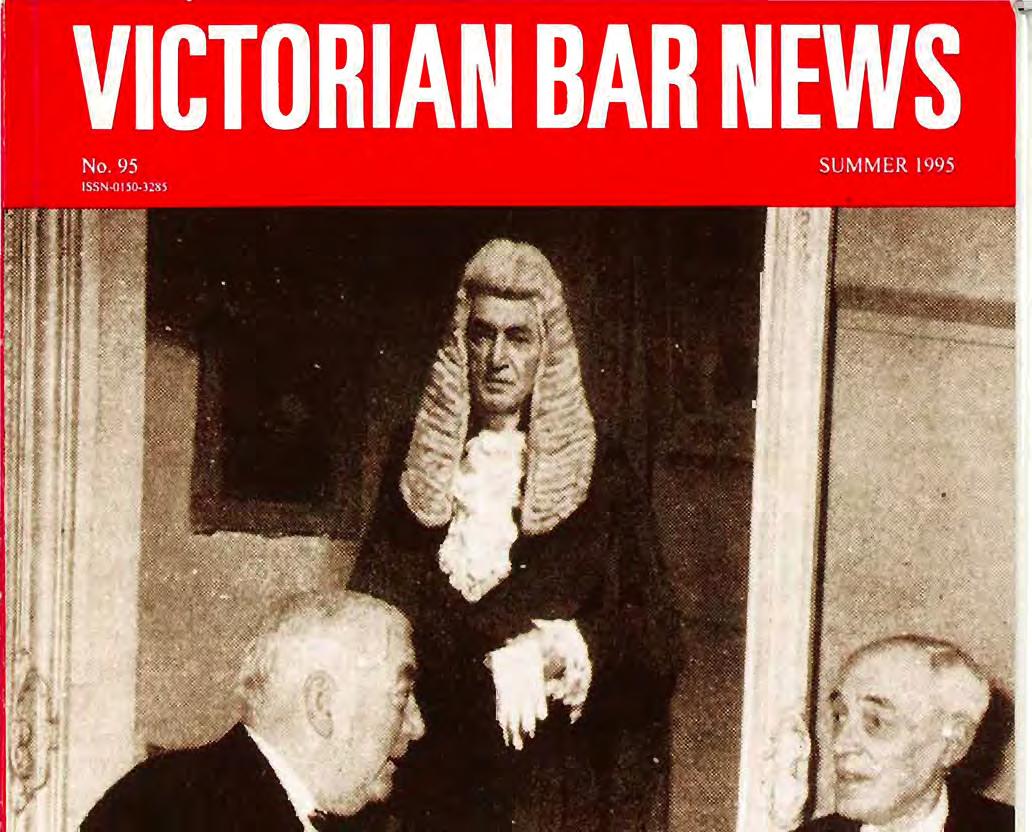








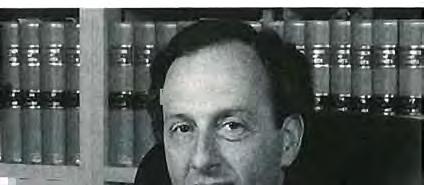
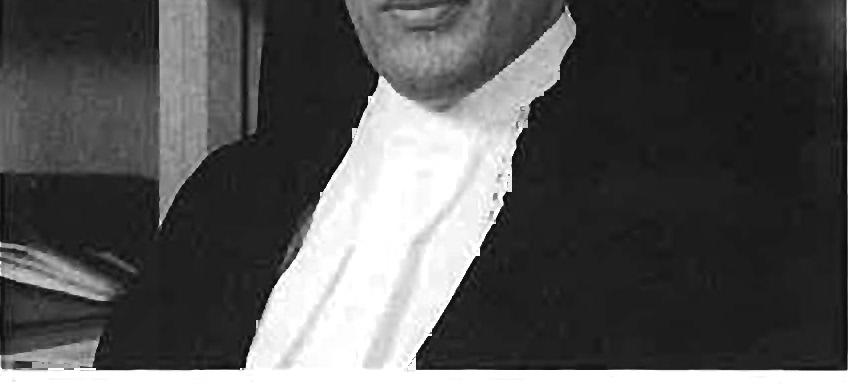
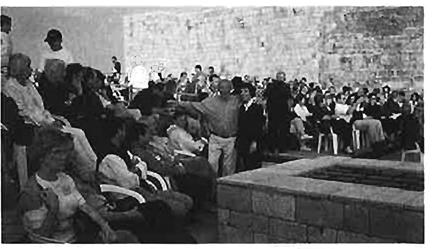
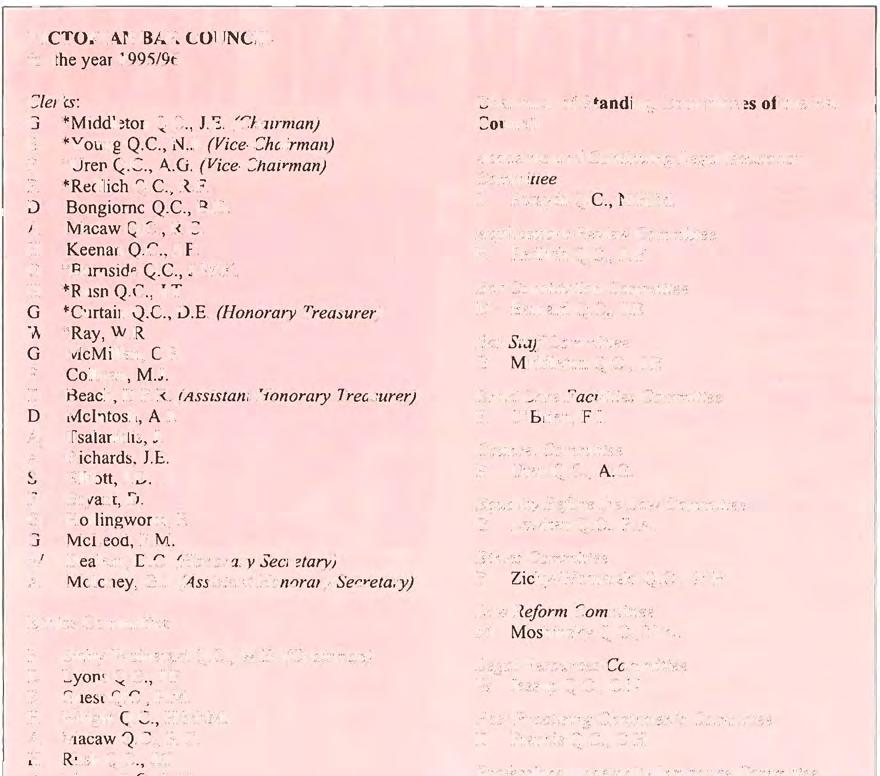



THE WINDS OF CHANGE, WHICH FOR OVER twenty years have been sandblasting the veneer of the rule oflaw from our society, are now aided and abetted in this task by the somewhat less subtle executive bulldozer.
At a f ederal level we are asked to believe that ministerial responsibility to Parliament is a thing of the past. At a Victorian level access to the courts has been whittled down further, not only by further amendments to the Grand Prix legislation, but also by the application of the user pays principle to the administration of justice.
It is no doubt hue that, from a totally utilitarian point of view, a dictatorship, properly administered, is more efficient than a democracy The rule oflaw and the rights of the individual will often be in conflict with the demands of economic rationalism or the efficient pursuit of the dollar.
In the conflict between an individual's view of what is good for him and the politician's view of what is good for that individual, the latter must always prevail. Big Brother knows best. At a very parochial level this is seen in the recent changes to the Bar ' s own telephone system.
The Bar Councilor Barristers' Chambers Limited - it is sometimes difficult to distinguish the two - has entered into a "deal" with Optus. Consequently the telephone system used by the clerks has be en transferred from the Telecom system to the Optus system and local calls are to be paid for on a time basis. This may be efficient. It may be part of a very sensible deal. It may benefit us all. But surely the question of which carrier an individual deals with is a matter for the individual? Surely the question of what should happen to a particular clerk ' s telephone system is a matter for the clerk or the list - not for the Bar Council ? At the least, the individual barrister ought to be given an opportunity to be heard on the question . Is dictatorship catching?
In Fascist Italy the trains, we are told, ran on time In Victoria, the concentration is rather on making the tollway run profitably . If citizens were free to continue to use the existing roads of the State , uninhibited by artificial narrowing or blocking of these roadways, the new tollway might be
less profitable. Equally , if the people who live in Albert Park were able to assert their common law rights to damages, the activities of those administering the Grand Prix would be inhibited Economic r ationalism has also led to the break up ofthe State Electricity Commission in th e interests of some warped idea of "free competition "
Gradually , both the State and Federal Governments are casting off their responsibility for the delivery of basic services to the community No one has yet suggested that the courts be privatised . But we are getting there.

Readers will recall that for the last six or seven years politicians of every colour and at every level have been telling members of the legal profession that access to justice was impeded by the restrictive practices of the legal profession, their high fees and general selfishness. In this State the executive - in the interests of economic rationalism -ha s now decided th at access to justice should be limited to those who are prepared to pay. Some 780 year s after King John undertook that "To no one will we sell , to no one will we refuse or delay, right or justice", daily hearing fees were introduced in the Victorian courts In this State we must all purchase justice.
The charging of a daily hearing fee - $260 per day in the Supreme Court - certainly adds to the cost of justice and restricts access to justice. In cases of hardship the fee can be waived, so that no doubt the totally indigent can have access to justice. Equally the rich and the large corporation
have ready access. It is only the vast majority ofthe population whose access to justice is inhibited by the application of the user pays principle to the enjoyment of a right which should be an absolute right in any democratic society which respects the rule of law.
In Victoria the Queen's Courts are open only to those who are prepared to pay for the use of those courts.
Ultimately, perhaps, when all services are delivered on a user pays basis and all services are privati sed we will find that there is no role for the politicians or the bureaucrats. Economic rationalism would dictate such a conclusion, but we fear that any such hope is ill founded.
At an international level France knows what is best for the world. What is good for France is good for the South Pacific - but, just in case, we will do it in the South Pacific! The history of France as a colonial nation does not make the French disregard of Polynesian concerns surprising. French arrogance makes it understandable that the protests of Australia and New Zealand, many of whose young men died to defend France in World War I, should be rej ected out of hand
Apparently France regards the nuclear weapons which it is testing as the' modem equivalent of the Maginot Line. History would seem to indicate that a Maginot Line - or a nuclear deterrentdoes not necessarily compensate for the sort of corruption and incompetence which resulted in France's rapid surrender in World War II.
What is disappointing - and even surprising - is the attitude of our British cousins The "mother country" is the only member of the European Community and the only member of the British Commonwealth to support French nuclear testing in the Pacific.
From the English bulldog and France's rooster the world is treated to a "coq and bull" story.
Britain seems to be reverting to the role of "appeaser", which was seen at the Versailles peace talks where Clemenceau dominated the British, and which was more recently manifested at a place called Munich.
Mr. Major must be delighted with the ammunition which he has provided for those who would support the establishment of a Republic in Australia
The Editors


• Effective design for barrister's chambers and legal offices
• Award winning residential interiors
• Consultant interior design and decoration
• Rina Cohen - Director
• Member of the Design Institute of Australia
• Building Practitioners Board registered

EVERY YEAR THE BAR COUNCIL PAYS
tribute to the Past Chainnan, retiring members of the Bar Council and others who have served the Bar at a dinner held in the Essoign Club. Actually, it is part tribute/part roast. This year I thanked and "basted" among others Her Honour, Susan Morgan, Paul Elliott and Con Kilias and, of course, David Habersberger Q C The Bar Council's effectiveness as a governing body of and advocate for Bar members depends upon the willingness of members to stand for the Council and devote their time for the great deal of work which arises in the course of a year. It also depends upon the willingness of each member of the Bar to give assistance from time to time.
So that the work of the Council can be done even more efficiently, we have introduced a system of allocating "portfolios" to Council members. A number of significant matters have been allocated to a senior and a junior member of the Council. The responsible Council members will also report to the Bar Council meetings on a regular basis in relation to their particular responsibilities. Members of the Bar should feel free to approach the designated Council representative if any problem or concern arises . Of course, any member of the Bar remains free to raise matters of concern with me on any topic.
The following are the list of "portfolios":
Reform of the Profession/Court Liaison; Human Rights - International Exchange: Middleton Q.C
Membership Matters/Law Reform: Uren Q.C and McLeod Barristers' Chambers Limited: Young Q.C. and McIntosh Bar Rules : Redlich Q.C and Colbran
Costs and Fees:
Bongiorno Q.C and Diana Bryant
Court Listings:
Clerking :
Legal Aid:
Keenan Q.C and Jenny Richards
Rush Q.C and McMillan
Curtain Q C and David Beach
Library and Resources:
Macaw Q.C. and Hollingworth
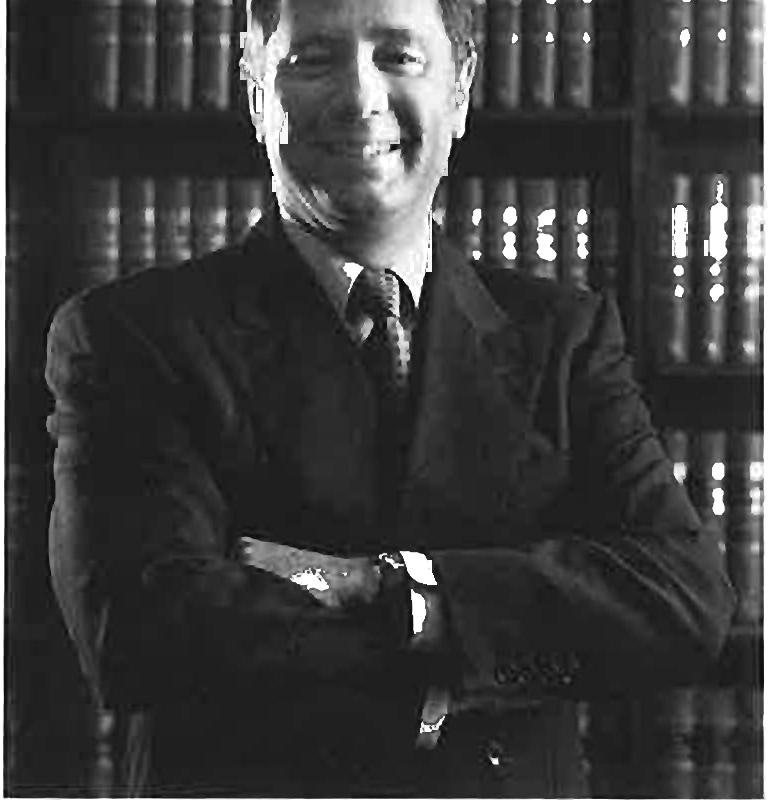
New Barristers: Ray and James Elliot Readers Course and Continuing Legal Education/Mediation/ADR : Burnside Q.C and Tsalanidis
In the course of the year I hope to be able to continue to rely on the good work of the various associations within the Bar. The associations provide an important voice for members in particular practice areas and are an invaluable resource to the Bar Council for consultation, law refonn submissions and the provision of feedback on specific issues. The number of committees of the Bar has been greatly reduced and the associations will become increasingly important in providing support and in being sounding boards for ideas
I propose that the Bar Council will need to set certain objectives in the near future. We have a continuing role in preparing submissions to both State and federal bodies on "law refonn", but the Bar Council will need to devote attention to such matters as the structure of our Bar (including Barristers' Chambers Limited) and the practice rules of the Bar. We will need to identify the major projects that must be undertaken this year for the benefit of our current and future members. I would be delighted to hear of any ideas from any member as to the priorities we should now set ourselves.
Clive James has said that civilisation depends upon the good work done by the anonymous many. So too the Bar. We are an unusual organisation, a professional body composed of fiercely independent advocates bound together by certain common ideals and, I think, a great sense of responsibility to the community. While there is no doubt that we are service providers in the true sense, the independent Bar is an essential element in the administration of justice. We must by our actions demonstrate to those who influence decision-making that this is
so and is for the public good. In this sense, each barrister has a responsibility to uphold the general principles of our professional court, which include the principles that a barrister must not engage in conduct which is prejudicial to the administration of justice or likely to diminish public confidence in the legal profession. Every time we deal with members of the public we act as ambassadors of our branch of the profession - we must be mindful to act accordingly, particularly at a time when our behaviour is under public scrutiny.

THE GOVERNMENT HAS TAKEN ACTION to improve many aspects of the justice system in Victoria. Some of these refonns have been funded by the increased revenue generated by the revision of court fees in 1994. One such improvement was the recent increase in the ceiling on the Appeal Costs Fund civil awards, which I discussed in a prevlOus Issue.
Prior to the commencement of the new court fees, an agreement was reached with the Department of Treasury whereby a percentage of the funds raised from the revision would go directly to the courts so that an appropriate standard of service can be maintained for the benefit of the public and members ofthe legal profession. The Chief Justice, Chief Judge and Chief Magistrate have recently advised me that their courts have already used some of these funds to provide better services. I propose to outline some of these improvements in this column.
The Supreme Court has used some of its share of the funds generated from the increase in court fees to facilitate the expeditious resolution of cases. A proportion of these funds was used to conduct the successful Autumn offensive. This offensive resulted in the fixing of hearing dates for 271 cases. Moreover, it facilitated the resolution of a number of cases by referring them to mediation. The success of this and the previous offensive undoubtedly assisted the Supreme Court in controlling the overall delays in the civil lists. In another attempt to improve waiting times the "Portals" program was created using part of this additional revenue. This program enables parties to civil litigation to take advantage of mediation serv-
ices at any stage during court proceedings. While insufficient time has passed to enable this program to be assessed, the provision of these services should meet the expectations of those parties who seek a prompt resolution of their cases.
Another major initiative of the Supreme Court funded by these additional resources was the introduction of new arrangements for the fixing of civil cases for trial. The objectives ofthese new arrangements are to introduce more certainty into the conduct of these cases, reduce their length, and encourage greater use of mediation services. The major features of this initiative are as follows. Approximately 12 weeks prior to the intended trial date the Listing Master will call on most cases to fix a hearing date. Unless cases are referred to mediation, parties will be required to confinn that they are ready for trial. They will also be required to provide to the Supreme Court an accurate estimate of the expected duration of the hearing. The Listing Master will then assign a trial date. This date may only be departed from in exceptional circumstances. Parties may also be ordered to file and exchange witness statements and to prepare a court book of exhibits. In circumstances where these orders are not made, directions will be given regarding the filing and exchange of outlines of evidence. It is expected that these arrangements will expedite civil proceedings by focusing parties on the importance of narrowing issues prior to hearings, if possible, and meeting deadlines.
The Supreme Court has also embarked on other initiatives funded by its share ofthe revenue generated from the new court fees. These include the creation of an Admiralty and a Major Torts List.
The fonner will facilitate the efficient resolution of maritime disputes and the latter will expedite tort actions involving professional negligence, defamation, very serious personal injury and other suitable cases.
The Supreme Court has also used some of this revenue to improve court facilitie s. Preliminary architectural and electronic reports have been commissioned by the Chief Justice for the creation of an electronic courtroom. Judges have also been the recipients of improved computer services which will assist them in writing and delivering judgments expeditiously. As I have indicated in a previous issue, the Government is keen to encourage greater use of technology in court proceedings and these steps are to be welcomed.
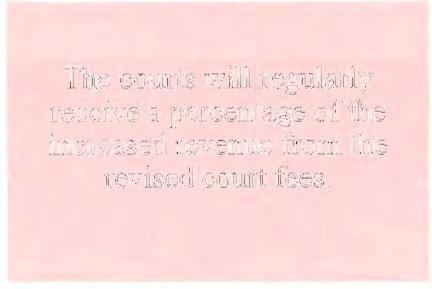
The County Court has similarly employed its share of the additional revenue re sulting from the revised court fees for the benefit of the public and members of the legal profession. In an effort to introduce greater efficienci es, the Registry document filing system has been upgraded, a transcript analyser with real-time option has be en introduced, and it is proposed to commence a more general upgrading of computer hardware . The County Court has also recommenced it s project to compile a Sentencing and Trial Manual , which is intended to be a working tool for all sentences and to assist practitioner s in their preparation and presentation of cases. Additionally, funds have been used to enable judges to attend conferences on such matters as gender bias and the development of innovative practices in an effort to meet community expectations . Future proposals include upgrading security arrangements, and employing short-tenn contract staff to provide judicial support and carry out administrative duties when required.
Finally, the Magistrates Court has also commenced a number of initiatives to improve its services and facilities using funds which have already been made available from the revision of court fees. The state of the Children's Court has
been subject of some recent criticism. The Government does not endorse the decision of the fonner Labor Government to place this court in the building it presently occupies. It is clearly an unsuitable building. The Department of Justice is currently ascertaining the future requirements of the Children ' s Court in preparation for the expiration of the lease in 1998 . In the meantime, some of the additional revenue has been used to paint and re-carpet the interior of this building. Services have also been improv e d, particularly in relation to family division matters. A proportion of this revenue has been used to fund the Children's Court Clinic assessment service.
Funds have been also been used by the Magistrates Court to achieve greater use oftechnology. A pilot court recording project has commenced in three of the courtrooms in the City Court. Recording of proceedings will be extended if this pilot project is successful. It is clear that this initiative would benefit members of the court, the legal profession , their clients , and other court users. Additionally, personal computers have been purchased for magistrates It is also intended to use this network to make available electronic legislation services and other useful computer data bases in an effort to improve the provision of relevant infonnation. An enhanced network should enable magistrates to carry out their duties more efficiently and effectively
The provision of additional infonnation has also been achieved by using a proportion of this incre a sed funding to enable magistrates and registrars to attend conferences and receive training on such matters as child abuse, gender awareness, crimes compensation and crimes family violence
A future initiative of the Magistrates Court is the creation of a Case Flow Management Unit. It is reported that this Unit will be comprised of a magistrate and registrars. The Unit will review the way in which ca ses are brought before the Magistrates Court with the aim of recommending refonns. The creation of this Unit follows the review of the arbitration procedure which is already underw ay. Both these initiatives show a concerted effort by the Magistrates Court to ensure that it continue s to provide an expeditious, efficient and cost-effective service.
These initiatives are to be welcomed . They complement other refonns introduced by the Government to make the justice system more accessible and efficient. The courts will regularly receive a percentage of the increased revenue from the revised court fees and we can therefore expect these initiatives to continue. Importantly , these achievements show that the Government and the courts can work together to improve the justice system for the benefit of all Victorians.

ON 5 OCTOBER LAST A LARGE NUMBER OF people gathered in the No. I Court, 450 Little Bourke Street, to welcome Justice Anthony Max North on the occasion of his appointment to the Federal Court and the Industrial Relations Court.
His Honour was admitted to practise in March 1973 and thereupon became Associate to Mr. Justice Stephen of the High Court. In November 1975 he obtained his Master of Laws from the Univer-
sity of London and in February of the following year, he signed the Roil of Counsel and commenced reading with Jeff Loewenstein. In his time, His Honour would have three readers of his own, Kenyon, McDonald and Cam.
In his first ten years at the Bar, His Honour developed a general civil practice embracing commercial disputes, company law, revenue law, building law, insurance law, trade practices law,
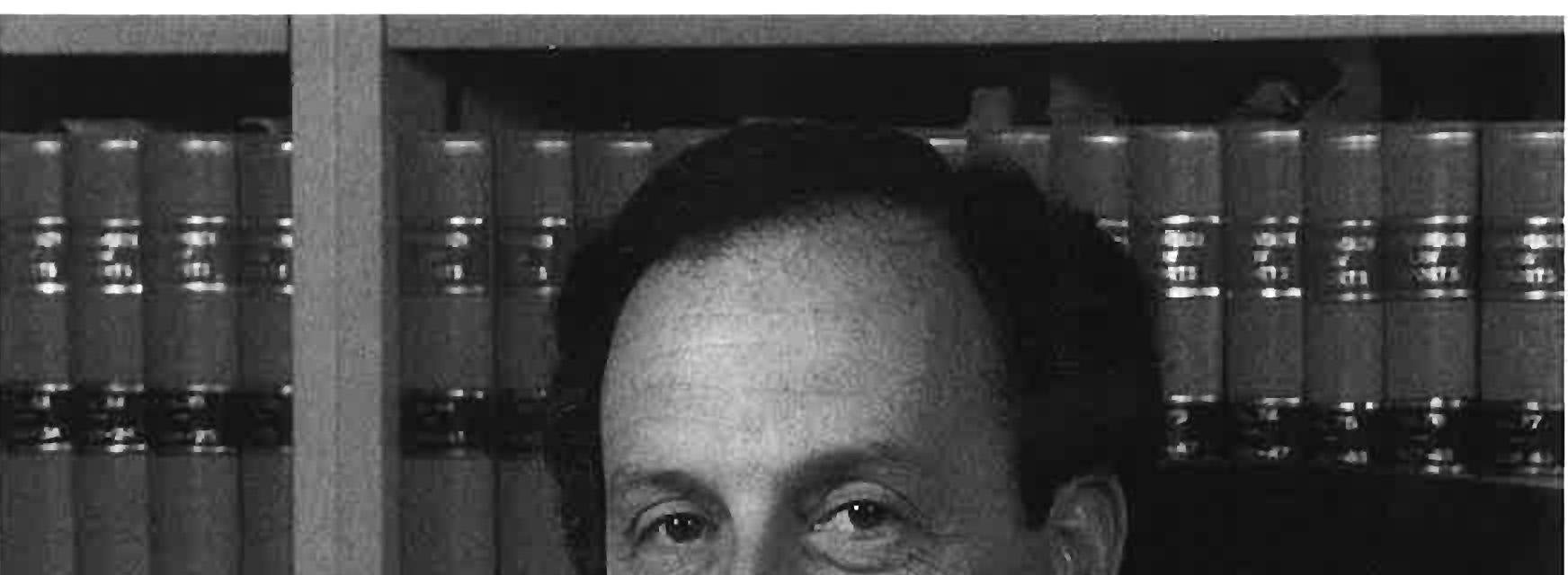


landlord and tenant and planning law. In the early 1980s His Honour began working in the industrial law field and by the time he took silk in November 1989, industrial work formed the majority of his practice. His Honour argued many major cases in the Industrial Relations Commission, the Federal Court and then the Industrial Relations Court, the Victorian Supreme Court and the High Court of Australia. Perhaps most notable of His Honour's cases were the Mudginberri Meat Workers Dispute, the Troubleshooters' case and the Pilots' case.
By the time of his appointment, His Honour was universally regarded as a leader of the Industrial Relations Bar. His Honour's advocacy was characterised by incisive analysis of issues, meticulous preparation and measured, persuasive presentation. The net effect of this was that His Honour consistently seemed to be appearing for clients whose cases seemed irresistibly reasonable. This must have been a source of great frustration to His Honour's opponents who would frequently have launched into battle thinking they had been favoured with the better side of the argument.
A common theme of the welcome speeches is that His Honour is a man without apparent vices. Certainly he does not drink or smoke. He does have a love of horses, but it is not of the sort usually encountered in articles such as this. His Honour actually enjoys riding horses. If one were being particularly churlish, His Honour's total indifference to, and ignorance of, football and cricket may be described as a vice. So too could his chronic neatness. Apart from his obvious skill as an industrial advocate, it came as no surprise when, in 1992, His Honour was appointed to the statutory position of Defence Force Advocate. The most punctilious Sergeant Major would have conducted snap inspections of His Honour's Chambers in vain. The mere need to mention these venial sins is sufficient proof that His Honour is a fine fellow indeed.
Apart from his mainstream work as a barrister, His Honour was also a member of the Human Rights Committee of the Victorian Bar and had the distinction in 1993 of being selected as one of the delegates from Australia to the Duke of Edinburgh's Commonwealth Study Conference in London.
Away from the pressures ofthe Btlr, His Honour likes nothing better than to retreat to his home in Warrandyte which he shares with his wife Audrey and their three children. His Honour's delight in family life and the bucolic pleasures ofWarrandyte is unbounded and always proved an effective antidote to the rigorous demands of his consistently busy practice.
Those of us who knew him well will miss his
friendship and wise counsel. Our loss will be far outweighed by the gain conferred on litigants in the Federal and Industrial Relations courts. There can be no doubt that His Honour's intellectual endowments, capacity for hard work and thoughtful, even-tempered disposition will prove a great acquisition to the courts in which he serves.
On behalf of the Victorian Bar we wish His Honour a long and satisfying career on the Bench.


The Services for the Opening of the Legal Year are as follows:
St Paul's Cathedral Cm Swanston & Flinders Streets MELBOURNE at 9:30 a.m.
St Mary's Star of the Sea 33 Howard Street WEST MELBOURNE at 9:00 a.m. (Red Mass)
East Melbourne Synagogue 488 Albert Street EAST MELBOURNE at 9:30 a.m.
St Eustathios Cathedral 221 Dorcas Street SOUTH MELBOURNE at 9:30 a.m.
I hope that many of you will find time to celebrate this event with your colleagues. Family and friends are also most welcome.
Members of the judiciary, Queen's Counsel and the Bar are invited to robe for the procession in the various robing rooms in good time·for the start of the procession, in which all members of the profession are invited to join. Marshals will be present at the services to indicate the order of the procession.
Yours sincerely,
JOHN HARBER PHILLIPS Chief Justice


PETER ABERNETHY COLD HAM HAD BEEN admitted to practise two years before I first met him in 1948. As juniors at the Bar together we cut our teeth on the post-war crop of landlord and tenant disputes which proliferated when soldiers were demobilised and sought to take advantage of the National Security Regulations, weighted in their favour. Briefs for would-be tenants were marked at two guas and briefs for landlords at three guas. On red letter days you might hold two briefs in the same Court of Petty Sessions.
Peter Coldham had returned after serving as a volunteer in the R.A.A.F. where as a pilot in Bomber Command in England he had been awarded a Distinguished Flying Cross, and then, as a Pathfinder, he had gone on to earn a Bar to his D.F.C.
Yet he remained at all times a charming, modest young man who, not often enough, regaled us with an odd tale of his exploits, but even then, only when favoured, and usually late at night in the company of friends. For he was a most convivial companion especially on circuit or perhaps after a Bar dinner.
There are the days when the Common Law Bar, particularly the Junior Bar, enjoyed the bountiful first fruits of Jack Galbally's Private Members Bill, which became the Contributory Negligence Act 1951. Before that Act, every plaintiff in a running down case, claiming damages for personal injury, ran the real risk of losing his action and of having to pay not only his own, but also the defendant's costs, if the jury found that he was guilty of even one per cent contributory negligence.
But now, with the apportionment of damages for contributory negligence, the Common Law Bar, being given free rein, commenced what quickly became a welter of jury actions, which drew forth a soulful complaint from the Bench, many members of which had not themselves enjoyed, not even experienced the cut and thrust of a jury action.
It was in this climate that Peter Coldham along with Jack Lewis, Jimmy Gorman, Tony Murray, Bill Crockett, Ted Laurie, Moodie Heddle, Lionel Revelman, John Starke, Bill Kaye, Reg Smithers, Herbert Frederico and many others matured.
Peter was Counsel in many enquiries concerning air disasters of the day, and when John Starke
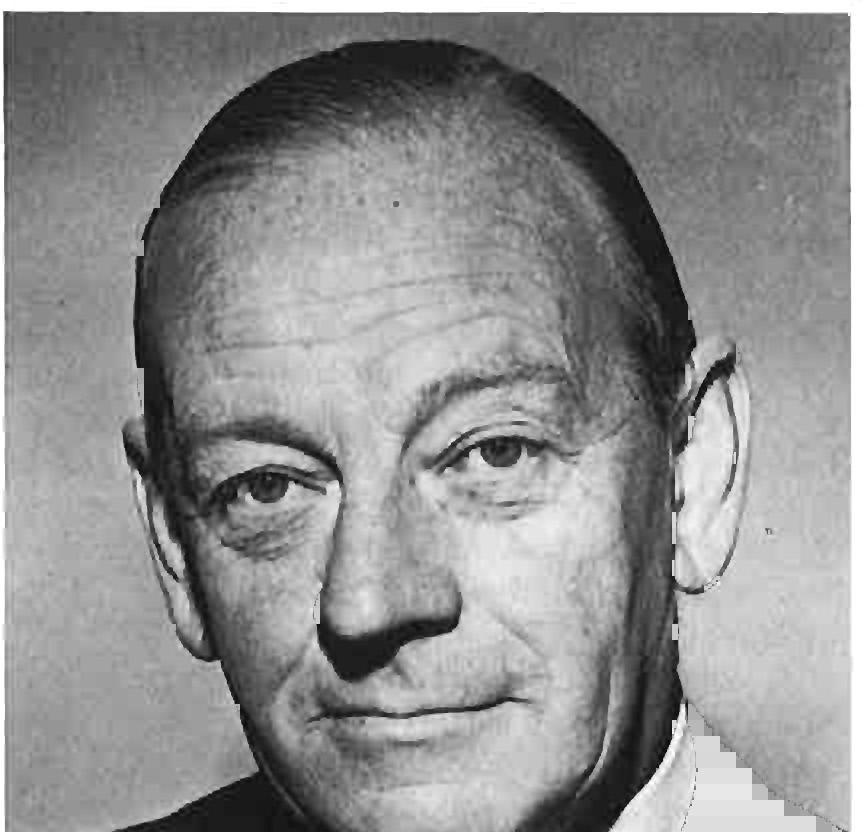


was appointed to the Bench, he succeeded to the retainers for the Herald newspaper. That may be one reason why there were very few defamation cases brought in the court in those days.
Peter had always had the happy knack of giving his opponent the impression that he had settled well.
It was, I thought, a sad day for the Bar and the Bench when he accepted an appointment as Deputy President of the Australian Conciliation and Arbitration Commission, in 1971. From this on until his death he was continually involved in important industrial and arbitral work, for which he was eminently suited.
He was a keen sportsman, playing tennis, cricket and later golf, in all of which activities he engaged socia1ly with his many friends.
We shall all miss him, but retain the fondest of memones.
Peter Murphy
ON SUNDAY 17 SEPTEMBER 1995, IAN Geoffrey Abr aham passed away. His final illness was of very short duration .
Ian was born in Ballarat in 1930, where he received his primary and secondary education. He came to Melbourne to study law, at the University of Melbourne , and took up residence in Ormond College. After graduating, he was admitted to practise on 15 February 1954 , and worked for several years as a solicitor, for Morris Cohen and Co ., and for Pavey Wilson Cohen & Carter, as those firms were then known.
Advocacy appealed to Ian. He read with Richard McGarvie, as he then was, and signed the Bar Roll (no 626) on I February 1961 At fir st , Ian built a general practice, and appeared in criminal and civil jurisdictions. While still quite junior, Ian was briefed in a then highly publicised Board of Inquiry into Scientology, constituted by Kevin Victor Anderson Q.c., as he then was.
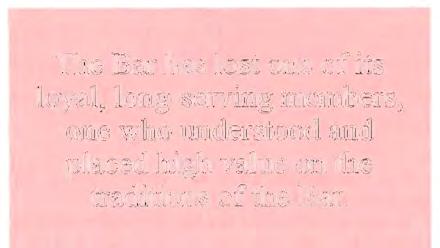
As time passed, Ian's practice tended increasingly to be d e voted to what was known at that time as the Matrimonial Causes jurisdiction , and he appeared as junior counsel in many of the more vigorous jou sts of those days. When the Family Law Act w a s passed, Ian continued to practise in that jurisdiction, almost exclusively.
To those who knew Ian only as an adversary, the image was one of an advocate who vigorously put his client ' s case That was neither a complete nor even an accurate picture of the personality of the man. Ian was a gentle person, with simple, modest tastes . To him, what was important, above all , was his family.
He was very proud of the deeds of his children, and loved to recount tales of their latest adventures or achievements. He relaxed tending the gardens, both at home and at Lome , where the Abraham

family had for generations had a holiday house. He loved to walk with Rocky, the most recent Labrador member of the family. He also loved to cook, something he did regularly.
Ian derived satisfaction helping others, and his generosity was not confined to his family. Anyone who was in need of his assistance was willingly given all the help he could provide Ian's three reader s, Tom Wodak, Fred Lory and Eileen Stuart (who now has a son at the Bar) would all attest to Ian' s giving nature Each was the beneficiary of unlimited patient tuition, and sound advice.
Ian is survived by his wife of 26 years , Helen, his son Simon, presently an articled law clerk, and daughter Karen, a fourth year law / arts student at Monash University.
The Bar has lost one of its loyal, long-serving members, one who understood and placed high valu e on the traditions of the Bar.
To Helen, Simon and Karen, the Bar offers its deepest sympathies.
Tom Wodak
DONALD (DON) GENE DOANE, A FORMER member.of the Bar and an early member of staff at Monash University, died on 15 July 1995.
He was born in the U.S.A. on 26 January 1935, graduated B.A. from a U.S. university, joined the U.S. Navy and was posted to Bermuda. After several years' duty there he took his family on a sea cruise holiday, fell in love with Melbourne and settled here in the early 60s.
He entered the University of Melbourne Law School and graduated with honours.
He then joined the Monash Law School where he remained a member of staff for nearly 15 years teaching several subjects including Corporations Law and Legal Personality.
He had a deep love for the law.
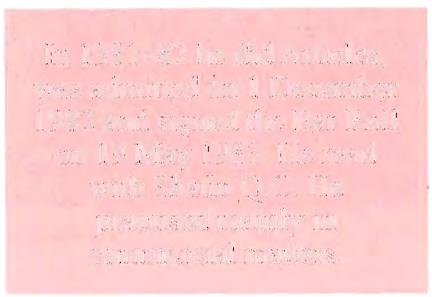
He thoroughly enjoyed his teaching and seeing the development of his students during their courses and in the profession. He left Monash in 1980.
He had wide interests. He read extensively. He was never lost for a word. He loved card playing.
Life did not treat him kindly, at times, however.
He was widowed in the 70s and reared (and according to his eldest daughter was reared by) his two teenage daughters.
In 1981-82 he did Articles, was admitted on 1 December 1982 and signed the Bar Roll on 19 May 1983. He read with Shatin Q.C. He practised mainly in commercial matters. His name on the Bar Roll was removed at his request on 28 Fe1:>ruary 1985. He then joined Blakes.
Later he did locums for a number of firms.
On occasions he briefed members of the Bar, including former students of his at Monash. He remarried in January 1995. He was still engaged in locum work and continued this work.
Sadly, he was struck by cancer in May and survived barely six weeks.
He 'held- a Full Practising Certificate from the L.I.V. at his death.

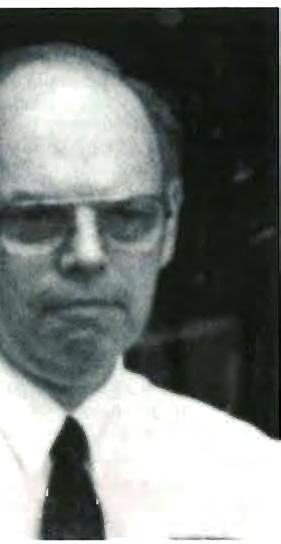
Our sympathies go to his widow Helen, his daughters and his four stepchildren.
A number of his old friends at this Bar recently suggested to Monash Law School that a simple memorial be created in his honour. This idea was received warmly.
So has been created a perpetual trophy to be called the "Don Doane Memorial TrophyMonash Law School Junior Mooting Competition". This complements the established trophy for the Senior Mooting Competition.
Vale to a most kindly, generous and gregarious bearer of the English tongue. He will be missed by many.
Because of the suddenness of his passing, his death may be still unknown to some Regrettably there were only a few of his old colleagues able to be present at the funeral.
It is hoped that the publication of this article in some small way will make amends.
Also, contributions to establish the trophy and the annual inscriptions on it and on an Honour Board, may be made by cheque made out to Monash Law Students Society Inc. and either sent to Monash Law School, Wellington Road, Clayton 3168 or left with Tony Radford's clerk.
Tony Radford
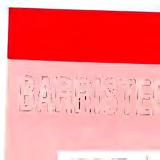


















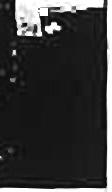
nx from Dix: Publ ic tran s port so repelle d A rnold Dix he has s tan ed h is o wn lux u ry c oa ch s ervi c e f or Bel g ra ve lin e co mmute rs


ARNOLD Dix Is so sick ot the violence and Illth on Melbourne's pubUc transport system he Is Starting his own luxury coac h service.

'nU'eatened by thugs on the train. haVing had windows :.mashed over him , his car repeatedly vandallsed in the statlon car park and ruining clothes on Illthy seats In a decade oC commuting on the Belgrave train line, Mr Dix said he had simply had enough

For about $10 just 80 cents more than the S9.20 price of a daily train tickettrom Belgrave - the bus will pick u p and dro p olf commuters near t h e maln pubUc service route between Moo b ulk: In the Dandenongs and Me l · b o urne ea.ch morning and night .
Having Investigated various posslbWtles, 'Mr Dix said he was su p rlsed to nod he could privately charter a bus and coach captain from Belgrave'S US BusUnes and charge abollt the same as the PTe ,
By PETER MICKELBUROUGH
"The aim Is to oaer cost·effective, safe , clean and rellable transport and a bit of old·Cashloned service ." he said.
Mr Dix said stops would be taJIored to suit passengers' needs. with each passenger gi ven a dO,uble seat ' and a mobile telephone avru.Jable to them
A fl.ve·day lrial sel"V1cc begms next Monday ThOse interested in uslngt h e ' hus may contacc' Mr Dix on 9608 8890
The PTe yesterday de,cllned to com· ment on Mr Dix's plans ,
"It's a terrible shame that people have to re so rt to things like this but good on him tor dOing something," PubUc Transport Users' ASsociation president Paul Mees said
,·It's not only safety and cleanllness: It's the high fares, the In,trequent $ervices and t h eir unreUabWty ,"



In September this year one of the great coinmon law judges of the Victorian Supreme Court "Bill" Crockett was awarded the degree of LL.D. (Honoris Causa) by the University of Melboume. This recognition of His Honour's service to the law and the outstanding role which he has played on the Supreme Court is richly deserved. The editors are delighted to print below the address which His Honour gave to the graduates on that day.
A GREAT ENGLISH BARRISTER F.E. SMITH
was a famous orator. He became Lord Chancellor as Lord Birkenhead. All law graduates will have heard of him at least I hope they have. His services as a speaker were difficult to obtain. An old friend, the headmaster of a great school, managed to procure him as occasional orator to speak at the school's annual speech night. Birkenhead, who was a very prickly fellow, expected to speak early and then get away. However, he was forced to sit through the lengthy process of the award of prizes, school reports and so on to his mounting chagrin and his perceptibly lessening patience. At last the headmaster announced: "And now Lord Birkenhead will give you his address". The Lord Chancellor strode to the lectern and snapped, "22 Picadilly, London, SE2", turned on his heel and departed.
I wondered whether I might employ the same tactic. After mature consideration I thought not.
First of all Chancellor may J say how greatly honoured I am by the University and Council by the conferment upon me today of the degree of Doctor of Laws honoris causa. I am, of course, aware that that degree is one of the most prestigious awards which is within the gift of the University to bestow
I am also most beholden to Council for the generosity of the sentiments expressed in the citation gi ven in support of the award. May I just add that I am particularly delighted that the award in recognition of any contribution I may have made to the law has come from my own university.
Next, may I congratulate all those who have graduated today and particularly those who are taking out their first degree. My bachelor's degree
was conferred just half a century ago, I think to this very month. I am afraid that after such a lapse of time which has brought me close to God's "use-by date" that I recall nothing of the event itself. However, it must be so as the University of Melbourne Law Society has on the basis of alumni records recently made me an honorary life member in recognition of the fact. That conferment was, of course, held on this site but in that great example of Australian bluestone gothic the old Wilson Hall which was later destroyed by fire. However, I do remember the great relief it was to have finally reached the end of my immediate tertiary education.
I am sure you, too, are feeling that sense of relief that the grind of endless study is at least for most of you at an end.
I know J felt then, and I hope you feel now, a sense of indebtedness to the University which has given you the opportunity to acquire knowledge and, perhaps more importantly, the thirst to continue to do so. You can now call the University of Melbourne your university and speak of it with pride as the great teaching institution which it is and of which you and I have been privileged to be a part.
If the opportunity arises to repay in some measure that debt do not fail to accept it. I must confess I have felt guilty in the past of doing too little to repay the University for what it did for me . I tutored the correspondence students, participated in a few moots and for some years undertook the task of correcting the examination papers of Professor Zelman Cowan's students as to which incidentally if there is a more dreary way of earning a dollar I have yet to hear of it.
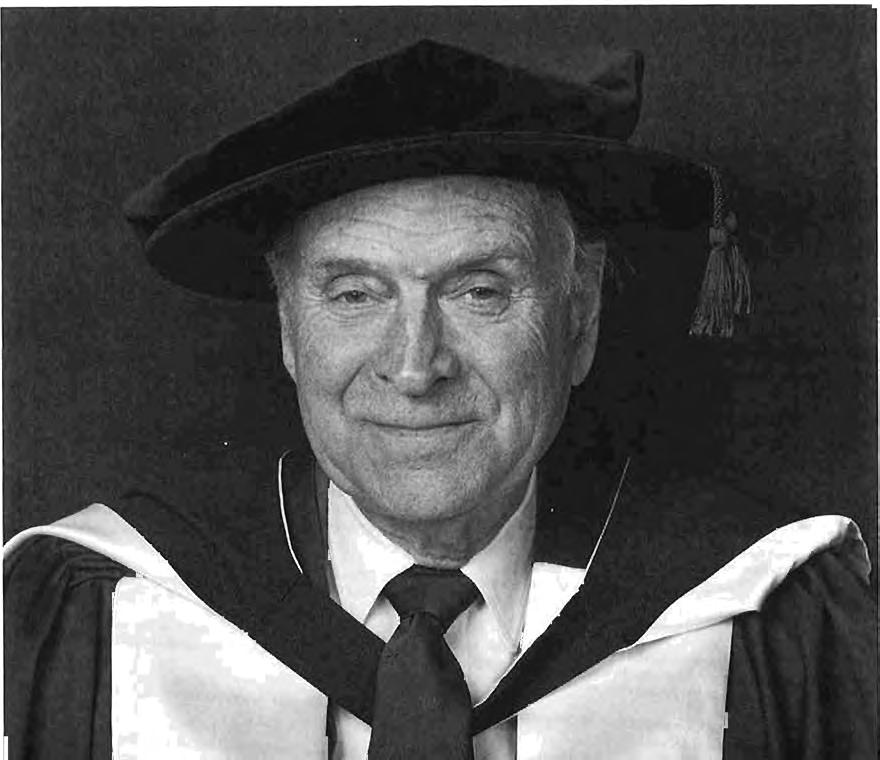

It was much later, when I was a senior judge, that I realised that I had in fact been doing rather more for the University than I thought had been the case. That was work done as assessor for the Governor of the day in his capacity as Visitor to the University. Being Visitor does not mean that Mr. McGarvie may call socially on the ViceChancellor for a sherry or two. The term has a technical meaning and the office itself is one of ancient lineage.
Perhaps a brief description of it may be of some interest to you.
In the Middle Ages what were to become great university colleges or hospitals in England were founded by the high and mighty They might be members of the Royal Family, aristocrats or senior churchmen but always they were persons of great wealth. That wealth was needed to establish the institution in question. It was a kind of medieval equivalent of to day's "every gift over $2 is tax de-
Me Chuncellor




W ILLIAM CHARLES CROCKEn'
WiIIl.m Churlcs Crockell WIl$ born on 16 April. 1924. He was educalcd 01 Gce10ng Culle!;e, ond Ihen.1 The UI\iversity of MclI>ouroc. from which he gr.dunted wilh Ihe deGree oC Masler o f Laws During the nn.l year of his law course he Guined Ihe Supreme Cuurt Prize Immedialely after Ihls he joined Ihe Royal Austrltllnn Naval Reserve where he served in 1945 and 1946





He was admitlcd III procli.'IC as a barrister and sol1chor oflhc Supreme Court ofVicloria on I FebnlBry, 1948 then signed Ihe mil uf cMnsel in Vicluria Mil beGan 10 praclise .1lbe Bur His lega.l abililY and foteeM but rcsponsihle .tlvIlCUCY qukkly earned him a praclice. particularly in common law und il WUS nul surprising thnl. 0.1 the early oge of 38, he apPllinled us Her Muje Counsel oC Victorio






qulckly became recugnised one o[ Victoria's 'silks' In \Ill jurisdictions of the Cuun. his services were slIugh! nfter law He alsu appeared in u number of inquiries imu mtuine and nir<'rufllllS3.ltclS Mil COllduclCd a lenglhy invesligalion .
On 2 December, 196\1 his Honour nppoinled "Ilhc Supreme Court or Viclurili lo lilllhe crealell hy Ihe dCOlh 0 Sjr Jvhn Bal·ry. The ("ellhul he was 45 or althe time .lr 'pp"illinlell l culttr nnd his cupacity as It lawyer ad vocale






lircmcnlur Sir Juhn SluI ke rrnm HUmlnr beca me lind since Ihen ha.l remained Ihe Puisne Judge til' Ihe Court.
FUr lIla'oy yeal's his chief work has been us a member of Ihc Appcllttle Division uf Ihe Court. Si nce becoming IheSen or Puisne Judge II( Ihe Cllurt. und when lhe Chief Justice hus nOI been his H.onour pre1ided oV<:1lhc Cou rt of Criminal App






The (.C Honour hus u of the Supreme Coull of Viclori demon slrale s service 10 Ihe law and lhe co mmunity of Viclori. lIS n whule He is now lhe lungesl serving judge or uny Stale Supremc Cnuli. Bul his "isl inclion lies nm merely in lenglh of service; lhc o( his work has, hy conseOl. been lhe ig h order. WIth his Hunour enjOys an repulatio .ISll the UC lite Cllmmoll L:1w world Throughout his he has on lIS devolopment p'1(licularly. in more recent years, in thc fie ld of cr iminal








would be true 10 thut His Flonour been Q model Supremc CuUrt Judge bOlll nllhe and as 8n appell.le judge He is quick courtc6us and, mure uflCn lb.n mosl. His j udgment,s have practi cal , pcnc!mting.leamcu where necessory, bUI alw.ys 10 the poinl. He sel! slandards al a lime when a rc increasingly nceded


yenrs he has been of gneal assi$tunce 10 the Chief Justice, Inti in recenll1mes hus shlluldCtcd Ihe hurden of Ihe appellale work of the Supreme Court to an eXlenl well beyond Ihal norm.lly expecled anyone ju dgc, and hus so nut on ly cfricienUy, hUI a1su wilb grent wisd um and depth of underslanding


Mr Chancellor


1987 nour Officer in Ihe Order of Australi a.


J presenlto you
WILLIAM CHARLES CROCKETI
ror admissiun to lhe degree of Doclor of Laws, hOI/oris ca"sa.

ductible". At all events, the founder originally had the right to visit to see how his money was being spent and how his heirs were being deprived of their inheritance. It is a commonly held belief that that right had become obsolete by the 19th century unless express statutory provision for its existence has been made.
Indeed, real doubts existed until relatively recently as to whether the principal right that had for centuries been exercised by visitors may not also have fallen into desuetude. That right was one enabling members of the institution to bring their disputes to the Visitor for resolution. Those doubts are now well and truly laid to rest. The office of Visitor is one created by the common law. The common law recognised that the Visitor had not only jurisdiction to entertain disputes but the power to enforce his rulings.
Indeed, the Visitor has exclusive jurisdiction over questions arising from the interpretation, application and observance of the laws of the foundation.
If no Visitor should be appointed then, in the case of a university built from public funds, the Crown is its Visitor. There is, as I have indicated, no doubt now that the Visitor's dispute resolution jurisdiction is anything but obsolete. It has in the past 40 or 50 years undergone something of a renascence both in Australia and England from whence of course it derives. Indeed, visitations in all jurisdictions have become a growth industry. The earliest Visitor of which I am aware was Geoffrey De Merton who founded Merton College Oxford in about 1384. Visitors were mostly members of Royalty. They were best positioned to make wealthy endowments. However, the practice has continued long past the days of personal endowments for members of the Royal Family in Britain and even the Privy Council to hold the office.
That is not much help to us in Victoria. Yet the Royalty connection has been maintained. Each of the universities in this State is set up by its own Act of Parliament. Each university is a corporation. By each Act the Governor ofthe day is appointed Visitor to the University. Petitions to the Governor are by no means infrequent. But the view taken hereand in the other States - is that a vice-regal representative cannot embroil himself in political or other disputation. Like the monarch whom he represents he or she must stand above all that and preserve strict neutrality.
How then was the petition to be dealt with? That did not bother the common law one little bit. It invented the notion of the regal or vice-regal personage acting through an assessor who hears and determines the petition. He then writes a judgment in the name of the Governor who by convention signs it and thus adopts it as his own. He gets all the credit for his Solomonesque judg-
ment while the assessor gets all the hard work. The part played by the Visitor's assessor is, I think, very akin to that of the writer of the speech prepared by the Government for the Governor to read when he opens Parliament. Everyone knows the statements made in it are not necessarily the Governor's own opinion. Indeed, the contrary may be true but he is required by constitutional convention to utter the words.
You will have guessed by now that the assessor has invariably been - in this State at leasteither the Chief Justice or his senior puisne judge. And that is how I have found myself from time to time for some years hearing petitions from members of the major State universities. One comfort to an assessor is that there is no right of appeal from a determination. Nor will the assessor substitute his discretion for one properly exercised by a university officer in whom is vested discretionary powers. This includes the power to pass or fail a student upon examination.
The principal complaint of petitioners concerning such matters as assessment of a student's scholastic work, admission to a course, admission to a degree etc. is that an adverse ruling was given with the petitioner having had no opportunity to be heard. That is, the allegation is one of procedural unfairness - or what used to be called breach of the requirements of natural justice. Then, differences arise over the interpretation of the University's statutes or agreements made under them such as, for instance, those which affect staff members' pension rights.
Suggestions that the jurisdiction is anachronistic and should be abolished are made from time to time but its great advantages of informality, privacy, cheapness and expedition are likely to lead to its preservation for many years yet.
An English judge recently defined the visitorial jurisdiction in these words:
My final conclusion, therefore, is that the visitor's role cannot properly be characterised either as supervisory or appellate. It has no exact analogy with that of the courts. It cannot usefully be defined beyond saying that the visitor has untrammelled power to investigate and right wrongs arising from the application of the domestic laws of a charitable foundation.
I should, I think, say no more on the subject otherwise I might seem to be touting for business or encouraging members of the University Corporation to bring suit against the University.
Again I congratulate the graduates, express the hope that you all have a successful and enjoyable professional career and present my felicitations to the relatives and friends (including my own) who have attended here this morning so full of pride at the scholarly achievements of their kinsmen and kinswomen.

IN SEPTEMBER 1995 THE ATTORNEYGeneral's Working Party on the Legal Profession published its report titled "Reforming the Legal Profession". The report carries a disclaimer that it represents the views only of the Working Party and "does not necessarily represent the views of the Attorney-General or the Government". However, it seems fair to suppose that the recommendations of the Working Party will, to a considerable extent, be reproduced in legislation presumably to be introduced in the 1996 Autumn session of Parliament.
The purpose of this article is no more than to summarise the proposals contained in the paper. No doubt the response of members of the Bar will vary but this article is not intended to be a critique of these proposals It merely seeks to inform the Bar of the content of the paper.
The paper is divided into 12 chapters. Not all the chapters deal with matters of immediate relevance to the Bar. For example , chapter 2 deals with the Solicitors' Guarantee Fund and chapter 8 deals with multi-di sci plinary practices The most relevant chapters are these:
Chapter 1: The Legal Practice Board and Recognised Professional Associations
Chapter 3 : The Legal Ombudsman(a) Complaints Against Lawyers
Chapter 4 : The Legal Ombudsman(b) Anti-Competitive Practice
Chapter 5: The Legal Profession Tribunal
Chapter 6: Reform of Barristers' Work Practices
Chapter 9 : Legal Costs and Client Information
CHAPTER 1: THE LEGAL PRACTICE BOARD AND RECOGNISED PROFESSIONAL ASSOCIA TIONS
Groups of lawyers such as the Victorian Bar or the Law Institute Board should be known as Recognised Professional Associations (RP As). Supervising the RP As will be a new Legal Practice Board. The membership of the Board will be retired or serving judges of the Supreme, County or Federal courts, as Chair, three lay persons (appointed by the Governor-in-Council), three legal practitioners of no less than ten years seniority
elected by all lawyers holding a practising certificate or members of the Victorian Bar. Eventually all lawyers holding a practising celtificate will be entitled to vote. There were be a limit of two persons from each RP A. At least one practitioner should come from the roll of practising solicitors, one from the roll of practising advocates and one "should be elected from ajoint roll".
The Law Institute and the Bar will be permitted to continue in existence. However after two years both bodies will be subject to accreditation requirements. Criteria for the accreditation of RP As will be specified including:
(a) the capacity to discharge regulatory functions delegated by the Board;
(b) sufficient size - it is envisaged that small associations will not viable and will not be accredited;
(c) the body must be prepared to regulate pra ctitioners who are not members of it but who nominate it as their regulator or have been allocated to it by the Board ;
(d) membership eligibility requirements are not to be unduly narrow;
(e) rules that are not anti-competitive in effect.
It is envisaged that new RPAs will come into existence as well as those already existing, i.e. the Bar and Law Institute. All practitioners will be required to have a practising certificate and the power to issue a practising certificate will be delegated by the Board to the relevant RP A. Investigative and prosecutorial functions will be allocated to RP As Further, one condition for accreditation will be to satisfy the Board "that it had effective conciliation procedures for the resolution of client-practitioner disputes. Such disputes will include costs disputes".
The office of Legal Ombudsman will be empowered to:
• receive complaints from members of the public against lawyers;
• refer sllch complaints to RP As for investigation and action ;
• investigate such complaints on his or her own behalf; in response to complaints, bring lawyers before the Tribunal; and
• take-over investigations being conducted by RP As.
The Legal Ombudsman therefore may both refer prosecutions to RPAs or take prosecutions over from them. The Ombudsman can investigate complaints that an RP A has not prosecuted the matter to the satisfaction of complainants. The Ombudsman will have the power to bring practitioners before the Tribunal, that is to say, a power equivalent to the prosecutorial power of the RP A. The Ombudsman "should not have been a practising lawyer at any time during the five years immediately before his or her appointment". It appears that the Ombudsman will not be the exclusive avenue of complaint to members of the public as it is proposed "that as a condition of accreditation, RP As should be required to deal directly with complaints from the public about their members or nonmembers regulated by them". A list of the Ombudsman's proposed powers is given at page 52 of the report. As well as those mentioned already it includes powers to:
• give binding directions to an RP A handling a complaint on how it should continue to deal with the matter;
• seek an independent assessment of legal costs charged to a complainant or independent advice on other matters;
• refer a dispute not involving an allegation of professional misconduct or unsatisfactory conduct to the Registrar of the Tribunal.
The Ombudsman will have all the powers currently exercised by the Lay Observer. One new aspect of the complaints procedure will be a sixyear time limit. At present there is no time limit. There will be a six-month time limit for complaints about an RP A's handling of a complaint. The Ombudsman will report to Parliament annually.
The conduct code agreement signed by the States and Commonwealth and Territories on 11 April 1995 radically alters the reach of the old Trade Practices Commission, now the Australian Competition and Consumer Commission (ACCC). The broad effect of the agreement is described in the report thus. Where the responsible Commonwealth Minister is satisfied that the laws of a State or Territory significantly modify a competition code text then "that jurisdiction (shall lose) rights in relation to the appointment of members of the ACCC and (lose) the ability to exempt conduct under section 51 of the Trade Practices Act. In addition a State which is not a fully participating
jurisdiction is not entitled to the per capita guarantee and competition payments funding agreed by COAG agreed in April 1995". Unlike the old general exemption under section 51 of the Trade Practices Act, it will be necessary to specify each kind of conduct which is to be exempted. The ACCC will have jurisdiction over the legal profession. "However, the Working Party believes that it is properly a matter for government to decide which exemptions are appropriate in the general context of competition policy". The government referred to is the State Government. ,The State solution to the imposition of anti-competitive regimes on lawyers is that the Ombudsman should report to Parliament on anti-competitive practices in the legal profession.
The Solicitors' Disciplinary Tribunal and the Bar Disciplinary Tribunal will be replaced by a single Legal Professional Tribunal. This will be chaired by retired judges of the Supreme, Federal or County courts appointed for three years. The Deputy Chairperson will be a retired judge of the Supreme, Federal or County court. There will be pool of 40 solicitors and 20 barristers appointed to the Tribunal after consultation with the Law Institute, the Bar Council and eventually other RP As. There will be a pool of 40 lay persons. Appointments will be for three years, subject to removal on grounds of incapacity, misbehaviour, neglect of duty or insolvency. The Tribunal will be constituted for the purpose of hearings by the Chairperson with one lay person and one lawyer, but the Chairperson may appoint five members being the Chairperson, two legal practitioner members and two lay persons to hear "a particularly grave charge". Less serious matters will be heard by the Registrar of the Tribunal who will be a practitioner of not less than seven years standing appointment by the Governor-in-Council. The Registrar will take over the function of the Ethics Committee to hold disciplinary hearings. The Tribunal will not sit in separate divisions for barristers or solicitors but the Chairman will be required in deciding on the selection of members of the Tribunal to sit in any particular case, to choose members who have relevant experience. A new category of disciplinary offence will be added to the current categories, being "unsatisfactory conduct". The powers of the new Tribunal will be similar to those of the present Tribunal but the maximum fine which it may impose will be $50,000 and it will be able to order compensation up to $15,000. The Registrar will be able to strike off a practitioner'S name from the Supreme Court roll, cancel a practising certificate or suspend it for more than
three months or fine the practitioner "more than 50 penalty units" ($5,000). (It may be that this is a misprint for no more than 50 penalty units ) The Registrar may deal with disputes between practitioners and clients, whether relating to costs or not, involving a limit of $15,000. The RPAs will have standing to prosecute disciplinary matters before the Tribunal. "A party to a proceeding before the Registrar should have a right to appeal to the Tribunal for leave to appeal by way of rehearing any decision of the Registrar." It is not clear whether this is includ((s a complainant . Appeals to the Tribunal will lie to the Supreme Court.
"The paper supports the continued existence of an independent Bar composed of specialist advocates. The Working Party envisages that the Victorian Bar would be a recognised Professional Association and that it would be possible for other associations of advocates also to be recognised." The four areas of practices considered in the paper are:
• Co-advocacy;
• Direct access;
• Chambers; and
• Clerking.
On co-advocacy it is recommended that :
a new legislative division should be enacted to enshrine the principle that a solicitor and barrister may appear together as co-advocates. Legislation should not attempt to define in detail any appropriate restrictions on co-advocacy, but should empower RPAs to make rules consistent with the basic principle permitting co-advocacy, subject to disallowance by the Governor-in-Council.
Little detail is supplied of the proposed form of such a rule although it is asserted that Rule 4.7 A: still [has 1 the potential to be unnecessarily restrictive, particularly as it purports to regulate solicitors' relations with their clients.
The recommendations about direct access are also left fairly general:
· new legislation should confer on all practitioners a general right to accept any client matter (subject, of course, to complying with requirements regarding trust funds) RPAs should be permitted to make rules of conduct consistent with the basis principle permitting direct access, including rules reasonably limiting the application of that principle.
Compulsory clerking will be abolishe.d.
There should be a legislative prohibition of any rule requiring a barrister to employ a clerk licensed by the Bar Councilor any other body ... there should be a substantial transitional period for abolition of the rule.
The Working Party supports the abolition of the
chambers rule announced by the Attorney-General on 10 April 1995.
On the question of sole practice, the Working Party recommends that the sole practice rule should not be abolished, because:
There is a significant risk that intervention to permit partnership of barristers might result in highly anti-competitive niche monopolies the Working Party does not recommend legislative intervention to abolish the sole practice rule applicable to members of the Victorian Bar.
The Working Party recommends that the office of Queen's Counsel remain and also supports the creation of the office of Queen's Attorney.
The Working Party recommends that: ... the common law prohibition on prohibition on percentage contingency fees should remain.
It does however recommend: that legislation should permit uplifted fees up to a maximum of 25%.
A significant proposal from the Bar's point of view will be that the Working Party recommends that section 10(1) of the Legal, Profession Practise Act be repealed and section 67 of the Supreme Court Act be amended to the effect that "a solicitor is only liable to pay barristers' fees according to the ordinary principles of contract and agency". In other words, the mere delivery of a brief will not mean that a solicitor undertakes the responsibility of paying for barristers' fees. The Working Party also recommends "an enhanced disclosure regime" regarding costs. This will apply to barristers in cases where no solicitor is involved The details of the enhanced disclosure regime require that various matters be continuously disclosed to clients so that they will be able fairly to assess the costs of any legal proceeding and will not be hit with unpleasant surprises by way of bills.
M.l. Crennan


An expert is someone who wasn't there when it happened, but who for a fe e will gladly imagine what it must have been like.
University of Texas Law School Professor Michael Tigar quoted in the ABA Journal (August 1995) 39.

THE Industrial Relations and Other Legislation Amendment Bill 1995 was about to be considered by the Senate. It will, if passed into law, make the following main changes to the Industrial relations Act 1988:
1. An amendment to s 170DE(2), by inserting the following italicised words:
A reason is not valid if, having regard to all of the circumstances of the case. including the employee's capacity and conduct and those operational requirements, the termination is harsh, unjust or unreasonable. This subsection does not limit the cases where a reason may be taken not to be valid.
2. An alteration to the procedure by which applications by or on behalf of dismissed employees are made: such applications now to be made to the Industrial Relations Commission in the first instance rather than to the Industrial Relations Court.
3. The introduction of a procedure by which parties to an unlawful dismissal matter which has been commenced in the Commission may have the matter, if not settled by conciliation, dealt with by agreement by arbitration by a member of the Commission.
4. The clarification of the circumstances in which an applicant will be taken to have an adequate alternative remedy under State law. Each of these aspects will be considered in tum.
Many members of the Bar have no doubt encountered the provisions of Div. 3 of Part VIA of the 1988 Act, inserted by the Industrial Relations Reform Act 1993. Under that Division, a person earning less than about $60,000 p.a. whose employment has been terminated may apply to the Industrial Relations Court for a remedy (reinstatement or compensation, up to a limit). The purpose of the legislation is to implement certain provisions of a Convention, and a Recommendation, of the International Labour Organisation. Relevantly to s 170DE, the Convention provides that:
The employment of a worker shall not be terminated unless there is a valid reason for such termination connected with the capacity or conduct of the worker or
based on the operational requirements of the undertaking, establishment or service.
These words are reflected, almost verbatim in s 170DE(l) of the 1988 Act. Sub-s (2) is as set out at the outset. The onus of proof of establishing the existence of a valid reason lies on the employer. If that onus is discharged, the onus of showing that the termination was nonetheless harsh, unjust or unreasonable lies on the applicant.
Hitherto, proceedings were commenced in the Industrial Relations Court and were forthwith referred for conciliation to the Industrial Relations Commission. If the matter could not be settled in the Commission, it came back to the court to be dealt with as a matter of ordinary litigation.
For many years before the introduction of these provisions into the 1988 Act in 1993, State industrial tribunals exercised their own unfair dismissal jurisdictions, determining cases usually by reference to the question whether the dismissal was "harsh, unjust or unreasonable" (e.g. see s 34(5) of the Industrial Relations Act 1979, Vic.). It had been held that such a question was often to be answered by considering whether, in the circumstances of the dismissal there had been "a fair go all round". This meant that the employer's situation in dismissing the employee could be considered alongside the employee's situation in having been dismissed. When this formula was put to the Industrial Relations Court in Fryar v. Systems Services Pty Ltd (1995) 130 ALR 168, 189, Gray 1. described the provisions as "a charter of rights for employees". He had previously described the distinction between the traditional formula in N.S.W. legislation and the new federal provisions in these terms:
It must be emphasised that the court is not given general jurisdiction to judge the fairness or otherwise of a termination of employment. It is given specific jurisdiction to determine whether a contravention of Subdiv B has occurred. It is a contravention of Subdiv B which will bring into operation the remedies provisions in s 170EE. Contravention of a single provision will result in the court turning its attention to remedies.
It is in that proposition that the essential qualitative difference lies between the provisions of the NSW Act and the provisions of the federal Act. Even if faced with a clear contravention of a prohibition laid down in the Convention, the Industrial Relations Commission of New South Wales would not be required to tum its attention to the question of remedy unless it were satisfied that, in all the circumstances, the dismissal concerned was harsh, unreasonable or unjust. The contravention could be submerged in other circumstances which would override it in the determination whether the dismissal could be characterised as harsh , unreasonable or unjust. In contrast, the court cannot disregard or treat as outweighed any contravention of the relevant provisions of Subdiv B. If it finds such a contravention, it must proceed to deal with the question of remedy (Liddell v. Lembke (1994) 127 ALR 342, 366-7)
These observations apparently caused some disquiet, and the amendment to s 170DE(2) is the result.
It will be noted that the amendment has been to sub-s (2) of s l70DE only. There is no requirement for the court to consider all the circumstances of the case when addressing the question whether there was a valid reason for the termination under sub-s (1). Neither are the anti-discriminatory prohibitions set out in s 170DF similarly qualified. It is also of interest that the Convention makes no use of the phrase "harsh, unjust or unreasonable". To the extent that the Act enjoins a termination for which there was a valid reason, but which was "harsh, unjust or unreasonable", it may be doubted whether there is a constitutional mandate as a matter of external affairs (these provisions not relying, of course , upon the conciliation and arbitration power).
Under the amendments, proceedings will no longer be commenced in the court. They must be commenced in the Commission . Conciliation will follow, as previously. Indeed, under s 170EA(4), the Commission must treat the application as a request to settle the matter by conciliation. What the Commission actually does is prescribed by s 170EB(l):
... the Commission must inquire into the matter to which the application relates and try to help the parties to the conciliation to agree on terms for settling the matter.
As previously, the "parties" are the employer and the employee and, if the application was made by a trade union on behalf of the employee, that umon.
To the extent that there was a reluctance (and the figures do not show that there was) on the part of applicants to commence proceedings without the assistance of legal advisers, it is likely that this amendment will lead to more applications being
made by applicants in person or by unions on their behalf. It may be that members of the Bar will tend to receive briefs after matters have been through the process of conciliation more so than at present. If however, the Bar is involved at the outset, it will be to the Commission that the application is made, and the client will henceforth need advice on important tactical issues which arise in the context of conciliation and consent arbitration, as will be shown below.
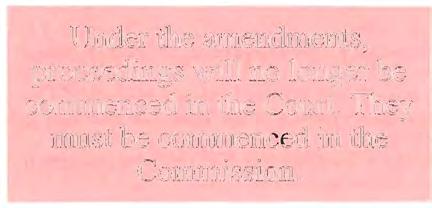
If, having conciliated , the Commission decides that the matter before it cannot be so settled within reasonable period, the Commission must:
... invite the parties to elect, by notice in writing given to the Commission ... to have the matter dealt with by consent arbitration. (s 170EB(2))
Such an election requires, of course, the consent of both parties. If it is not forthcoming, the matter returns immediately to the court to be dealt with much in the way as previously (s 170ED(l)). It is when the parties do so consent that the substantially new (and interesting) provisions of the legislation come into operation . By s 170EC(I), an election to have a matter dealt with by consent arbitration:
constitutes an agreement between the parties:
(a) to submit the matter to the process of consent arbitration ; and
(b) to comply with any requirement of the Commission for the purpose of that arbitration; and
(c) to comply with any award made on that arbitration; and
(d) if that award is taken on appeal to a Fun Bench of the Commi ssion - to comply with the award as confirmed, varied or substituted on that appeal.
The Commission may (must?) either dismiss the application or provide "a remedy of the kind able to be granted by the Court under s 170EE" (i.e. reinstatement or compensation) An "award" made by the Commission is not an "award" for any other purposes of the Act (thus there can be no interim award under these provisions, a dismissal award cannot be the subject of an application for interpretation by the court, nor can penal proceedings be instituted for a breach of such an award). Enforcement is provided for in s 170ECB(l):
The Court may, on application by a party to a consent arbitration, take such action as the court considers necessary to enforce the agreement of the parties to comply with the terms of an award made in a consent arbitration ofa matter.
It is specifically provided that the powers of the court in this regard include the power "to grant an injunction enforcing the reinstatement of an employee" (s l70ECB(2)).
These provisions raise certain questions. The first concerns the norms, if any, which the Commission is to apply in a consent arbitration. The Act does not require the Commission to proceed as the court would by considering, for example, the existence of a valid reason under s l70DE(l) and the other matters that, in court proceedings, would produce a substantive result in the case. This may have been to avoid the conclusion that the Commission has been invested with part of the judicial power of the Commonwealth, but it does seem to mean that parties who commit themselves to consent arbitrations may be getting into a contest without definition. What, for instance, would constitute error for the purpose of an appeal from an order made as a result of a consent arbitration? Is it likely that the Commission will revert to the traditional test of enquiring only whether the dismissal in question was harsh, unjust or unreasonable? Will the Commission be entitled, if satisfied that there was no valid reason for a dismissal, to balance all the surrounding circumstances and perhaps uphold the employer's decision to dismiss? A party who has consented to an arbitration in such an illdefined forensic setting may be in no position later to complain that the Commission has applied the wrong test or reached a wrong result.
The second question is whether the provisions are constitutionally valid. It is not that the Act as amended is any the less a matter of external affairs than was the Act previously: the relevant Convention requires the adopting State to implement it either by collective agreements, arbitration awards, court decisions, laws, regulations, or 'in such other manner as may be consistent with national practice". It is that the new provisions contain an admixture of judicial-looking and arbitral-looking powers. Apparently an attempt has been made to steer clear of the reef upon which the legislation that was considered in Brandy v. Human Rights Commission (1995) 127 ALR I came to grief and to maintain the distinction between the creation of legal obligations (by the Commission) and the enforcement of existing rights (by the Court). As noted above, the absence of any normative law which must be applied in a consent arbitration in the Commission presumably works in aid of the . conclusion that the Commission is not exercising judicial power when so proceeding. The fact that the order of the Commission is not simply regis-
tered in the court as was the case in Brandy would reinforce that conclusion. The function of the court on the other hand looks fairly traditional but it is interesting to note that the legislation does not simply provide that non-compliance with an order by the Commission will produce stated penal or civil consequences. Rather, what the court might do if confronted by a party who has not complied with the order is left somewhat at large. Further, as separate proceedings will be required in the court, parties will presumably be given an opportunity to contend that the order of the Commission ought not to be "enforced", or not enforced in a particular way. All this seems to be frontier thinking on the part ofthe policy makers, and perhaps indicative of better times ahead for the Bar.
In a number of cases already, the court has considered what constitutes an "adequate alternative remedy" under State law, the existence of which will disentitle a dismissed employee from making application under the federal Act. The matter is to be tested as at the time it comes to be considered by the court, and often, by then, any application the employee might have made under State law will be time-barred. The court has held that a remedy which is conditioned upon the applicant securing a discretionary extension of time (after the time has expired) is not an adequate alternative remedy. In this respect, the Bill abandons the concept of "adequate alternative remedy". Instead, s l70ED(4) requires the court to reject an application if the applicant is entitled to apply for an alternative remedy under a State law which satisfies the requirements of the relevant provisions of the Convention. Under sub-s (6), an applicant is to be taken to remain entitled to apply under a relevant State law even where he or she requires an extension of time, if the State tribunal is required to grant such an extension where sought within a reasonable period after the court (i.e. the Federal Industrial Relations Court) declines to consider the application, or within a specified period after the court so declines that is reasonable within the meaning of the convention, or where the court has a general discretion to grant extensions of time and is required, in the exercise of that discretion, to give effect to the Convention. These rather complicated provisions defy paraphrasing. They are sufficiently clear to justify the conclusion, however, that they will have little operation in Victoria. Neither as a matter of substantive law nor on the question of time extensions do the relevant provisions of the Employee Relations Act 1992 (Vic.) meet the requirements of an "alternative remedy" under these new federal laws: see ss 38 and 40 of that Act.
Chris Jessup
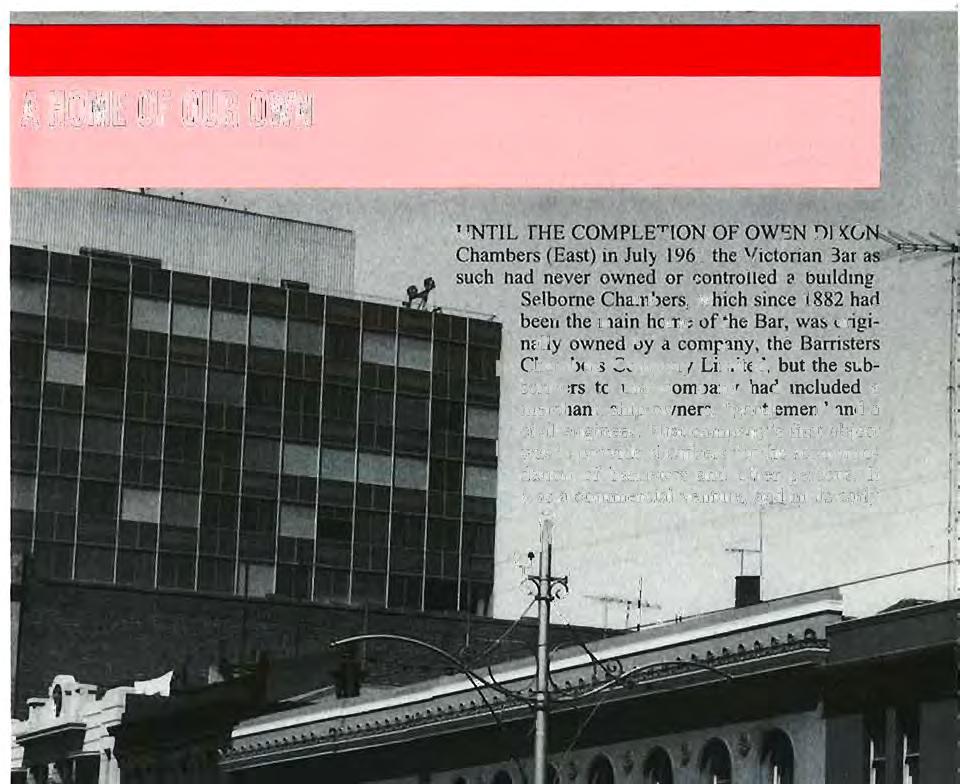
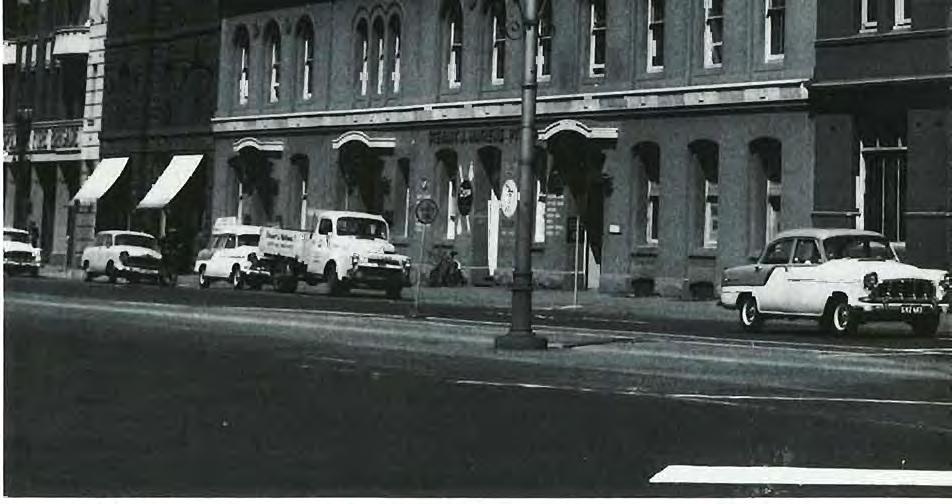
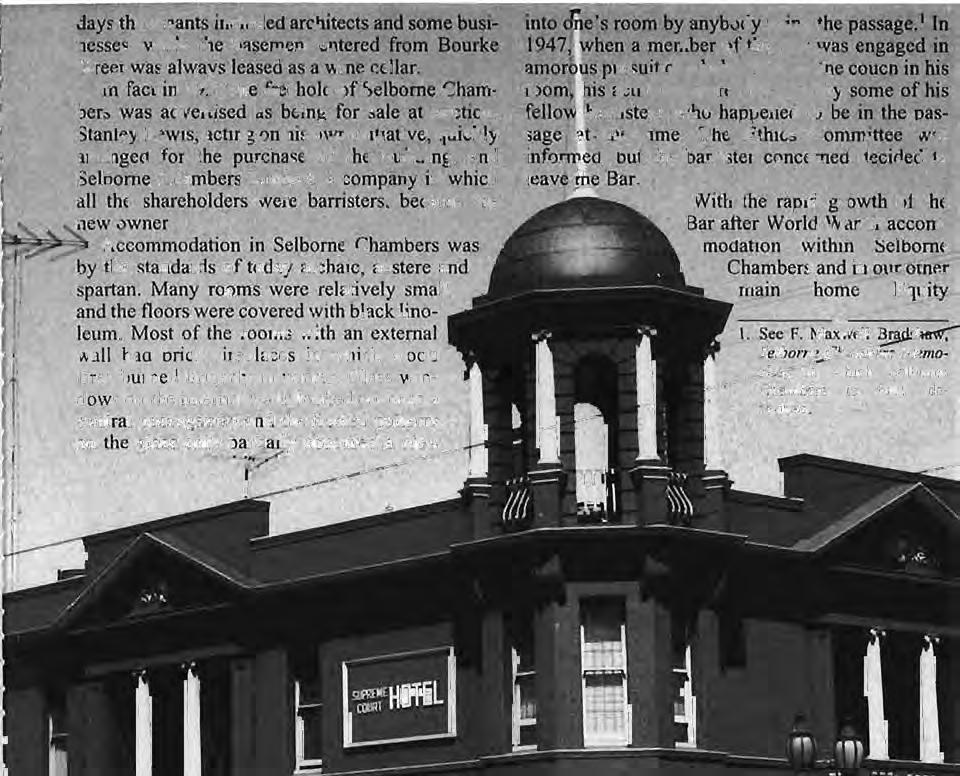
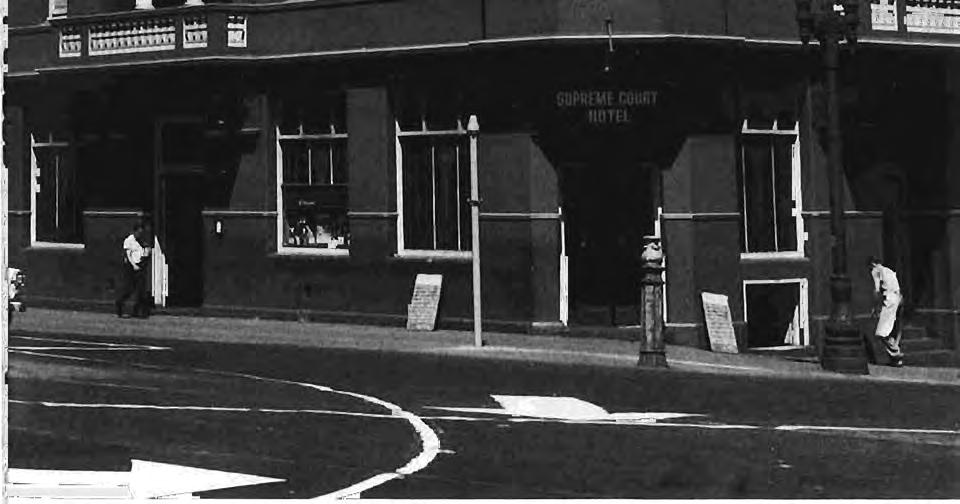

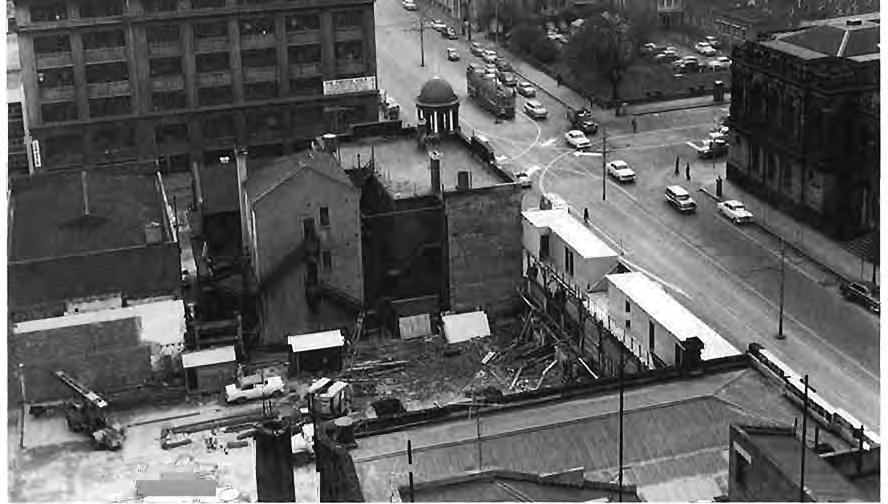
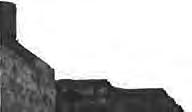
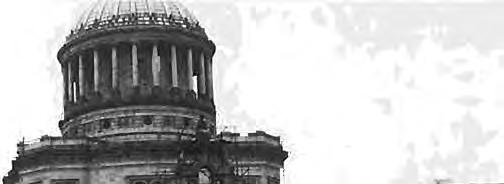
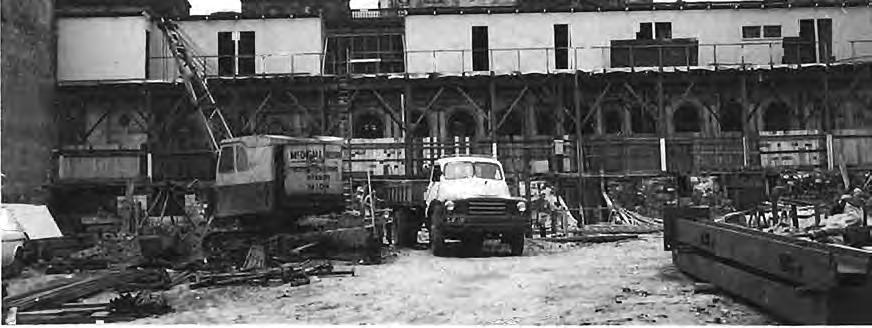
September 1960, preparation of the site for Owen Dixon Chambers (top: facing north, bottom: facing east)
Chambers became quite inadequate to house the entire Bar. In 1950 arrangements were made by the Bar Council for the leasing of additional rooms in Saxon House and later further chambers were also leased in the Eagle Star Building and in Brougham Chambers. The leasing of these areas by the Bar
He and Smithers were ably assisted by McInerney Q.c., Minogue Q.c., Lush Q.c. and Kevin Anderson, while Jim Tait Q.c. wrestled with the financial problems.
In order to ensure that the new building would never pass out of the hands of the Bar it was
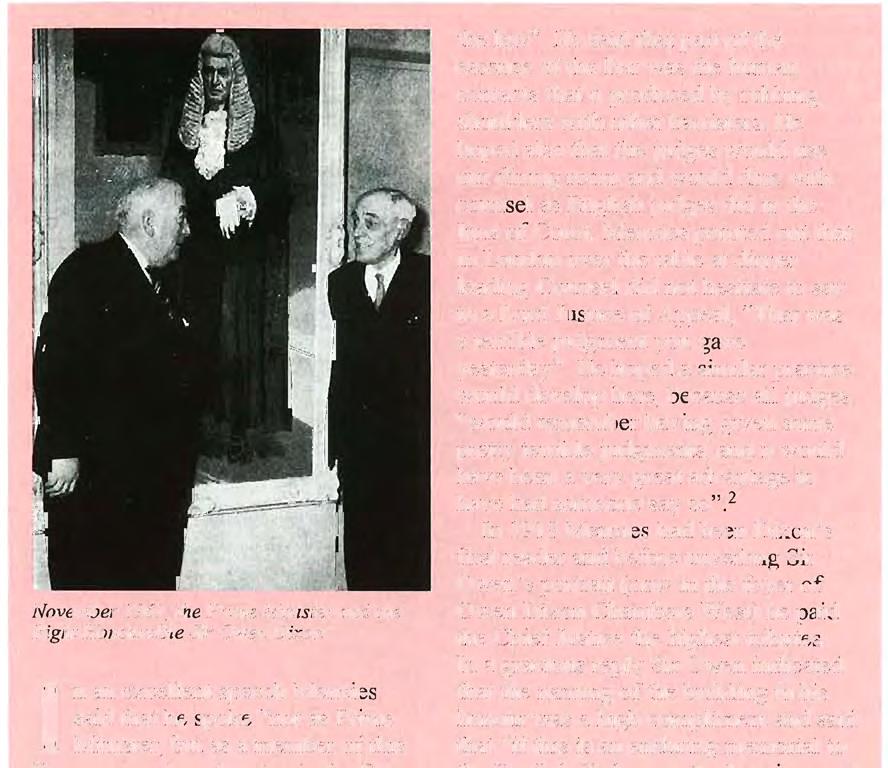
Bar; a man whose heart is in the Bar and in the practice of the profession of
Council was not without contention. Some more senior barristers considered it was inconsistent with the proud independence of the Bar, that its Council should be leasing chambers for its members.
By the late 50s many of the shares in Selbome Chambers were owned by the estates of deceased barristers so that the Bar could no longer necessarily control its main set of chambers. There was an ever-growing feeling that new chambers needed to be built to hold most if not the' entire Bar. On the 30 May 1958 a general meting of the Bar resolved that an effort should be made to provide a single home for the members of the Bar.
In accordance with this policy Barristers Chambers Ltd was incorporated in 1959. Even within the Bar Council there were divisions of opinion, the strongest advocate for a new building being Reg Smithers Q.C. Late in 1959 very lively
the Bar I shall share in the happiness of having a memorial".
and at times stormy meetings of the Bar were held and plans of a proposed building were on display at the meetings. 3 Opponents ofthe scheme were derisive of the plans referring contemptuously to the new building as "Bull-shit Castle". Prominent in their opposition to the scheme were Maxwell Bradshaw and Russell Barton who among other objections, considered in particular that the Victorian Bar Council should never involve itself in the owning of buildings.
In 1959 the Bar was fortunate to have at its helm Oliver Gillard Q.c. who, above all others, was responsible for planning the various practical steps which resulted in the ultimate building. To him most of all the Bar owes a huge debt of gratitude.

2 The speeches of Robert Menzies and Sir Owen Dixon are fully recorded in Law Institute Journal, November 1961, pp 397-401.
3. Ibid pp 94-9
decided that the only shares with voting rights in Barristers Chambers Ltd would be owned in trust for the Bar Council, and that the purchase of the site and the construction of the building would be financed by preference shares to be owned by barristers and by a large mortgage. Bob Gilbert
undertook the unpleasant task of canvassing the Bar to subscribe for the necessary preference shares, until he had sufficient written undertakings for the appropriate amounts to ensure the plan was financially viable. Added stimulus for the move was provided by Federal Hotels Limited, which
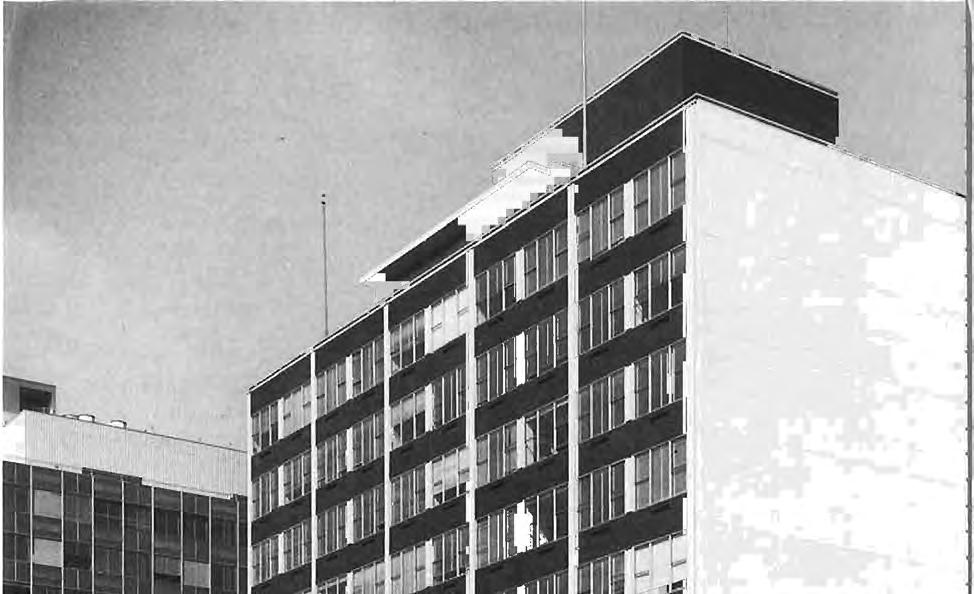
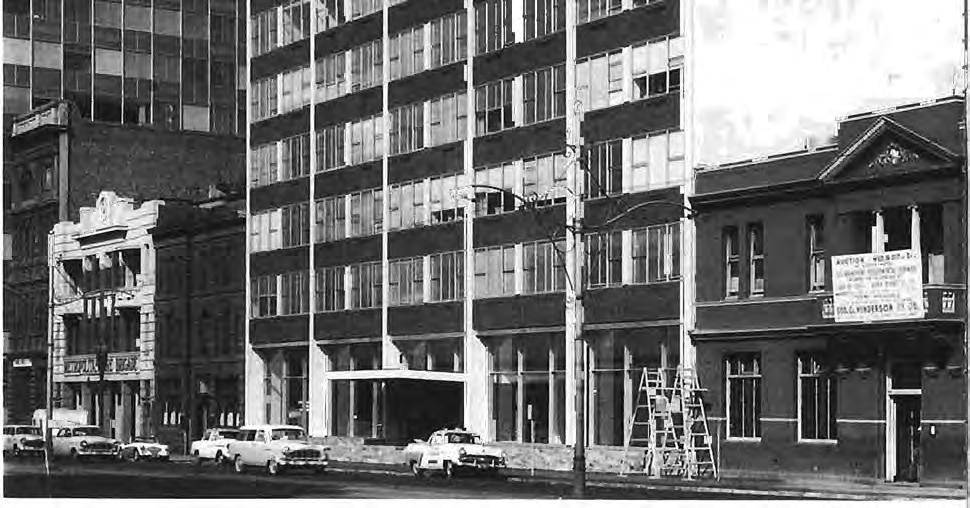
wanted to buy Selborne Chambers, and had offered all shareholders £7 for each one-pound share. The majority of the Bar, most of whom owned shares, then decided to back the new project.
Late in 1959 the Victorian Bar Council was able to acquire the present site of Owen Dixon Cham-
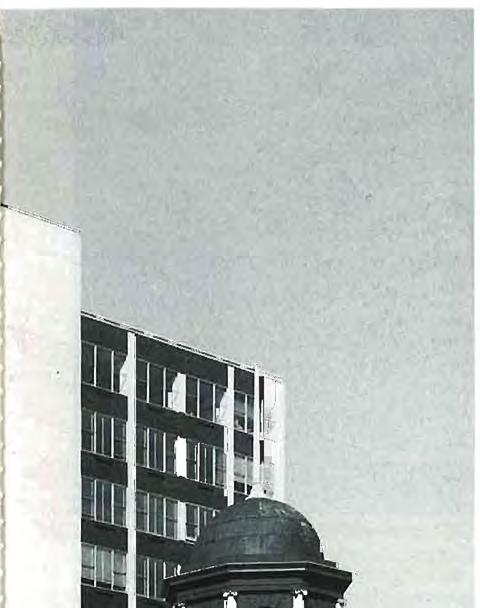
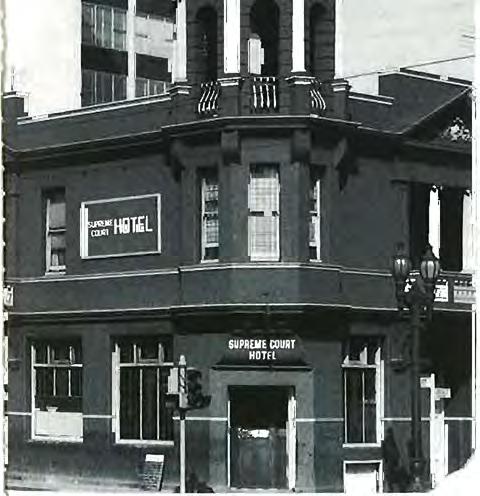
bers East on which then stood a somewhat archaic two-storey building. Immediately to the north was the Supreme Court Hotel which, in the days of sixo'clock closing, was one of the favourite watering holes of the legal profession. By September 1960 the archaic building had been demolished and the building project , which was in the hands of Richard Costain (Australia) Pty Limited, was underway. By December most of the steel structure was completed and early in 1961 the main concrete pours took place.
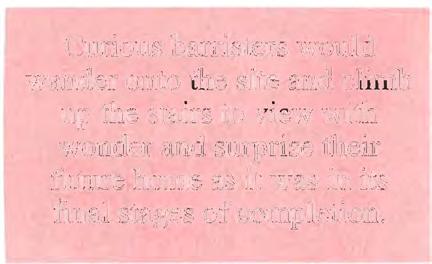
Within the Bar a variety of floor plans were circulated and members of the Bar formed groups and chose suitable plans for a segment of a particular floor suitable to their requirements. In Selborne Chambers there had been one public typist only and very few barristers had secretaries. There was also little provision for waiting solicitors or clients, who ordinarily stood waiting in the passages until Counsel was ready for the conference. The new building was to provide adequate secretarial space and suitable waiting facilities.
During autumn 1961 the brickwork of the new building was completed, windows and internal partitioning walls were installed, and from time to time curious barristers would wander onto the site and climb up the stairs to view with wonder and surprise their future home as it was in its final stages of completion.
By the end of June most floors of Owen Dixon Chambers were ready for occupation and on the weekend of 1 and 2 July 1961 which was the beginning of the July vacation, the big mov e began. Wilsons, the carrier, performed the move as a job lot and under the very efficient direction of Bob Gilbert all our books and smaller possessions were packed into wooden teachests. Later Ian Wilson was to recall of the move that the carriers had never in their lives seen "such a bundle of old furniture and bric-a-brac moved into a new building". In all rooms fairly minimal bookshelves were provided in the new building and, if required, additional shelving. The floors of all rooms and the passages were tiled with grey linoleum tiles. Happily most of the carpet squares brought from Selborne Cham-
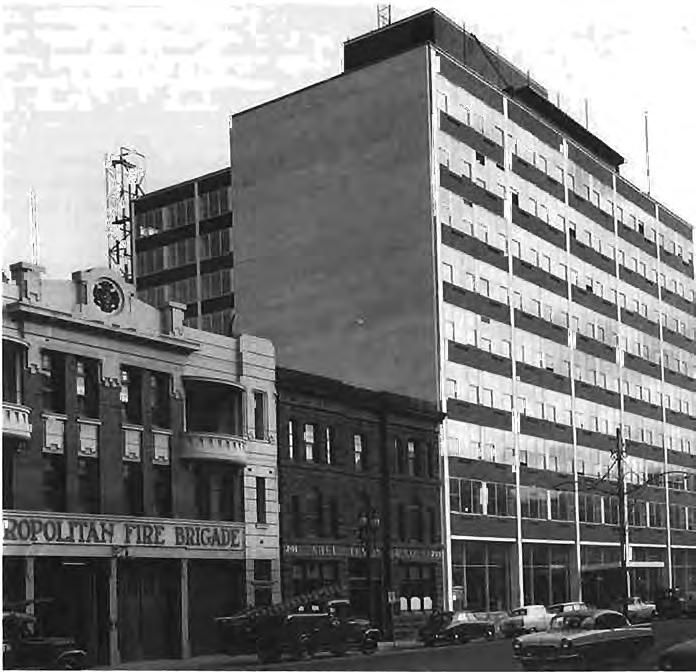

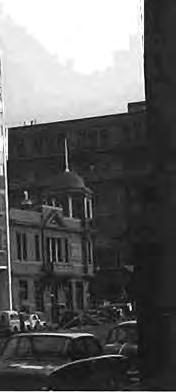
The north facing view - soon familiar to barristers returning from a hard day's work at court opposite
bers more or less fitted our new rooms, but many opted for the lUXury of wall-to-wall carpets The building was then nine storeys high and on the top floor was the library, the dining room, kitchen facilities and a roof garden.
Although Owen Dixon Chambers was in full swing by late July, the Official Opening by the Prime Minister the Right Honourable Robert Menzies did not take place until 16 October 1961 . Most members of the Bar became tenants in Owen Dixon Chambers and for the next 20 years it was the main home of the Bar. Bradshaw and Barton refused as a matter of principle to move to the new building and obtained very long leases of two rather grotty rooms in Brougham Chambers at a very low rental. To the front there was a rather unattractive view of Chancery Lane while to the east was a lane with stagnant pools of water, in which collected old newspapers, tins, bottles and other refuse. Behind the lane rose the western facade of Temple Court -a conglomerate of pipes, toilet windows, and other such features.
Most of us thought that this lone remote colony of two barristers in such surroundings could only spell financial disaster for them both. How wrong we were proved to be. In order to erect the 16 sto-

rey building now situated at 459 Little Collins Street, an English company soon acquired Condon ' s Building (within which Brougham Chambers was situated) and a number of other adjacent buildings. Bradshaw and Barton were offered long leases of far better chambers at the same rental, but indicated little interest in moving. An English director was dispatched to Australia to attend on Max Bradshaw in his chambers to reiterate that the company could not understand why he and Barton wanted to remain there. By this time the largely unoccupied Condon's Building was in very derelict state. Max rose from his chair, walked slowly to the grimy window and peered out at the encircling gloom. "I like the view here" , said Max Shortly afterwards, as an inducement to leave, each was offered a sum so large that, when one allowed for the fact that it was tax free, a successful senior junior might well have taken three or four to earn such monies. When Max, who was conducting the ne gotiation s re fu sed (hi offer, Rus sell Barton almost Ultimat ely settlement was reached at an even higher figure . The moral to this story is: "Stick to your principles It doesn't always cost you money".

Charles Francis

PROVIDED WE DO NOT LEAVE THEM WITH nothing more than a legacy of ceremonies and costumes from another world, the Republic of Vanuatu can be perhaps the most pleasant place on earth. Unfortunately it has been assumed that the mere presence of a white man in a position of authority will improve the country. It is time that that attitude changed . I believe that the program of assistance offered by Australia to assist in judicial services was a step in the right direction. The idea was to assist by teaching the ni Vanuatu to equip them for the assumption of judicial office in their country, not merely to have positions filled by expatriates and to pretend that we have done a good thing Unfortunately the program is on hold for the time being. I will perhaps write of my view of the reasons for this at another time, but my present purpose is to record some of my observations of my time there.
I was sworn in as a Judge of the Supreme Court of the Republic of Vanuatu in December 1993. I was not in fact due to commence my term as a judge of that court until late January 1994 . In the afternoon of the day of my being sworn in, I commenced to hear my first case.
Outside the courthouse was gathered a large crowd The foyer of the court was filled to overflowing. I was soon to discover that the courtroom was equally packed with interested spectators and from my seat on the bench I could see through the open doorway into the packed foyer from which led the stairway to the first floor. The stairway was full of people, some leaning over the bannister in an attempt to see into the courtroom.
My swearing in as a judge had not been open to the public, although the press were present. I have to report however, that the large gathering at the court was not assembled for the purpose of welcoming me, nor for the purpose of simply getting a look at the new judge so as to find out what was in store for them I was conducting a sitting of the Magistrates Court for the purpose of hearing a charge against an official of the Public Servants Association under the Trade Disputes Act. I had been told when I arrived in Vanuatu that a substantial number of members of the Public Service had gone on strike in November over a number of demands that they had made and which had not
been met. It seems that what precipitated the demands and then the action was the Parliament giving its members and particularly the ministers a substantial raise, despite the fact that the Public Service had had little or no increase in their salaries since Independence in 1980.
The Public Service employs by far the greatest number of people in paid employment in Vanuatu and therefore both the action and the question of Public Service salaries was of great importance to the people. This explained the crowd, rather the interest of the people in me.
Under the Trade Disputes Act it was an offence for a person to encourage others to take part in industrial action, where the minister responsible had made an order under the Act, in certain circumstances. The offence was punishable by imprisonment. It seems that every otherwise available judge and magistrate in Vanuatu felt that they could not hear the case because of personal knowledge of the defendant.
The hearing commenced with the defendant pleading not guilty and the prosecution calling its evidence. 1 heard a good deal of evidence designed to establish that the defendant was in fact an official of the Public Servants Association. I then heard evidence from a number of police officers regarding gatherings of unidentified people, carrying placards with writings, the content of which was unknown to any of the witnesses, at or near some government office buildings. The hearing was adjourned to the following day, the prosecution case still in progress.
The crowd was perhaps even larger for the second day of the hearing . Several more police witnesses giving substantially the same evidence as those who had preceded them were called. Counsel for the defendant on the second day rose to his feet at the conclusion of the evidence in chief and smiling declared, "I have no questions My Lord".
The prosecution case ended and a submission of no case to answer was made on behalf of the defendant. The main basis for the submission was that no evidence whatsoever had been given ofthe involvement of the defendant with any of the gatherings outside the government buildings. A secondary submission was that there was no
evidence as to who any of the people so gathered were, whether they were members of the P.S.A. or that they were taking part in industrial action. It was unnecessary for me to rule upon the secondary submission. The defendant was duly acquitted upon the first ground. The large crowd began to smile, although they remained silent as they had done throughout the entire hearing.
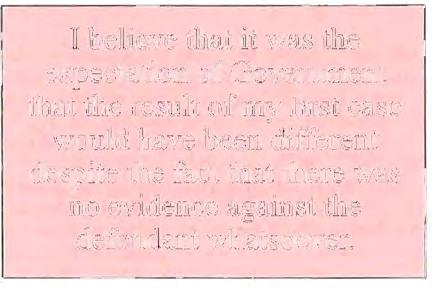
The following day I returned home to Australia as I had planned all along Upon my return in January to take up my position, many people expressed their surprise to see me, it having been rumoured that the Government had thrown me out of the country. I was able assure the people that this was not the case . There had however, been some matters which had preceded my hearing of this case which were in my view less than satisfactory.
The fact of my resignation as a judge of the court is fairly widely known and I will not now go into the reasons for it , suffice it to say that I believe that it was the expectation of Government that the result of my first case would have been different despite the fact that there was no evidence against the defendant whatsoever.
My next time in court was the official opening of the 1994 legal year. The full bench of the Supreme Court, comprising the Chief Justice , Charles Vaudin d'Imecourt, Rowan Downing, myself, the Chief Magistrate and from memory, two other magistrates . We attended a church service at the Presbyterian Church which followed an "Agenda" prepared on the instructions of the Chief Justice and which included "Mass", presumably because the ceremony for the previous year was conducted at the Catholic Church. I was later to discover that the Chief Justice had decided to share the annual church service among the various churches of Port Vila, by having it held at the Catholic Cathedral every second year and the alternate year at one of the various Protestant churches.
From Port Vila I left for the northern island of Espiritu Santo where I was to be principally based. It was here that I think the importance of a
community having a trained, skilled, fair and independent judiciary and a trained, skilled and courageous legal profession was brought sharply into focus. When I arrived there, there were two resident magistrates in Santo and I was to become the first resident Supreme Court judge since Independence There was no permanent resident legal profession there at all. There was one lawyer, a member of the Public Solicitor's Office based there, but principally because of budgetary restraints the office was not able to maintain a presence there. During my time two legal firms established offices which they visited from time to time
When Supreme Court criminal sittings were held, the Public Prosecutor and one lawyer from the Public Solicitor's Office attended for the sittings. Because of requirements upon their time in Port Vila, sittings had to be arranged to suit them rather than the court or the requirements of the community. In civil proceedings, the position was the same , if not in fact worse. In cases where the parties were represented, it was almost impossible to have the parties available at the same time Where the parties were unrepresented, the cases hardly ever became ready for trial.
The simple fact of the matter wa s that there were insufficient lawyers in practice in the country to deal with the work. The people are poor, in monetary terms . Many problems associated with the difficult question of the custom ownership of land arose. I speak of matters ancillary to the determination of custom ownership itself. This problem is enormous There are enough cases on appeal to the Supreme Court, involving custom ownership, that would keep the court occupied for five ye a rs doing these cases alone. One ofthe problems that arises where parties are unrepresented or where one party only is represented, is that it is almost impossible to settle cases. I am sure that the general public are not aware that lawyers resolve more cas es than they actually litigate. When there are, in effect, no lawyers, the cases neither settle, nor become properly prepared for presentation in court. What happens therefore, is that the cases build up without much prospect of being resolved in a re asonable time or at all.
The cases not being resolved leads to great tension in the community, often leading to personal violence , or trespass to land and damage to property, including homes, outbuildings , crops and cattle. Consequently, tensions are building up among a group of people who are the friendliest, most generous and likeable people one could hope to meet.
I would like those who in this country seek to take power from the courts , restrict lawyers from properly representing the people and generally try to apply principles of economic rationalism to the

practice of the professions, to see what can happen to a community when there are not enough lawyers to go around Governments of course are not fond of lawyers because they help people to take them on. Governments who do not have the help oflawyers themselves, on the other hand, also find themselves in difficulty
The absence of a strong, skilled and courageous legal profession creates another significant problem. Ultimately, the judiciary will come from the practising profession . If there is not a body of people who understand the law and understand the role of acting fearlessly for their clients whatever the cause, then there is not a sufficie n t recruiting ground for the judiciary Equall y impo rtant is the day-to-day role of the lawyer tually fearle s ly advocating their client's caus e absence of this, there is no check upon the judiciary itself. The prospect of a bench losing independence and objectivity is heightened in this situation. For Vanuatu, the sooner it develops its own legal profession of national lawyers the better. This is in no way intended as a criticism of the expatriate lawyers practising in Vanuatu. If they were not there, the ordinary member of the community would be almost entirely without representation at all.

What exists in Vanuatu is a fundamentally sound and fair legal system and set of laws. The Constitution contains a Bill of Rights, entitled Fundamental Rights. These rights include protection from discrimination upon the grounds of race, sex and religion . Despite these constitutional guarantees, women's rights are frequently abused and there is clear discrimination on grounds of religion. This highlights the need for the people to be able to be represented. It is of little use having the best set oflaws in the world if people are not aware of their rights or how to seek to enforce them . This is the role of the legal profession. Those who live in communities who have the benefit of such a profession would do well to be aware of this before they seek to destroy that profession.
Presently, Vanuatu remains one of the most pleasant places on earth. It does so because of the goodwill of the great majority of the people. There is however no room for complacency.

I commenced writing this article in my hotel room in Port Moresby. The hotel is in a compound surrounded by a wire fence topped with razor ribbon . Guard atte nd the perimeter fence gate. is an internal fence further guarding the hotel foyer entrance think four people have been killed lhi week and three died in a hoot-out at a restaurant the day before I arrived. My concern for Vanuatu is that it appears that the ingredients for the breakdown in law and order which occurred in P.N.G appear to be present in Vanuatu
legal system and judiciary. Peter Ryan, in his robust article "Some Unfinished Business From the Second World War" (Quadrant, September, 1995) said:
It is my impression that PNG's legal system and judiciary have striven to maintain standards of probity. Perhaps they continue to reflect the example and the training of the distinguished Australians like Sir John Minogue and Sir Reginald Smithers who served on the PNG bench. If my feeling is right at least one important department of public life is sound. But for how
I agree with Peter Ryan's assessment of the legal system and judiciary of P.N.G. From thi s there can be hope. For Vanuatu the problem must be faced and not swept under the carpet. There exists an enormous fear of apparent criticism, but recognition of a potential problem is the first step towards avoiding the consequences of ignoring it. It is out of my affection and concern for Vanuatu that I urge it to be vigilant.
I also urge those who seek to take positions of public office in this or in anyone else's country to examine their motives for so doing. If you wish to help the people to ultimately truly attain their own true independence, then offer to go. If you wish to take such office for your own reasons, such as a comfortable retirement, the opportunity to live in a tropical paradise, with housing and servants , to escape the rigours of a modem city life and its pressures , to enjoy the round of cocktail parties and fine restaurants, or even to explore and participate in the unspoiled life of the villages which have remained unchanged for centuries, then do not seek to go. It is their country, not ours . If you have nothing to give, then stay away.

For some reason I hold some optimism for the future for P N.G. Perhaps in part it is to do with the
It was my observation soon after arriving in Vanuatu, that practically nothing had been done by way of instructing the people as to the structure of the legal system, its application a nd the laws themselves. Two cases with which I dealt iIlustrated this graphically. Both cases involved sexual offences against young girls, one eight years of age and the other approximately 15. The eight year old had been seriously tom when penetrated by her uncle She, it would seem, came close to bleeding to death. The area chiefs determined a resolution of the problem and effected a peace s e ttlement between the girl's parents and the offender. Some mats and I think a pig were to be given by the offender to the girl's father. The chiefs prevailed upon the court to take no action in the matter because it had been resolved in custom In the other case, the 16 year old had been raped upon three successive nights by the man she had believed to be her father. In fact she had been, when an infant , swapped by her natural parents for an older girl from a nearby viIlage. Custom had it that she would be married to a member of the family from
whom the other girl had come. The older girl had been swapped for the purpose of marriage. It turned out that the only male member of the family into which the younger girl was to be married, was the man who had brought her up. On the fourth night, after having been raped on the previous three, she tried to kill herself.
It was obvious in both ca ses that there was not only a lack of appreciation of the criminal law and its role in a community, but there was no knowledge of the actual law which made the actions of each offender an offence. These cases and others demonstrated a complete lack of instruction to the community of the legal system which had been adopted at Independence and which had been substantially in force for many years before.
Rowan Downing who was Registrar of the Supreme Court and also a judge of that court had made the same observation. As a consequence of cases like those to which I have referred and others with which he had dealt it was decided to do something about it . Rowan , assisted by the Public Prosecutor's Office, the Public Solicitor ' s Office and the police conducted what was probably the first program of instruction in the Constitution and the law, to the people at a village level. He did this on the island of Tanna, a place famous for the active Yasur volcano. In Santo, at a place called Fanafo, I conducted a similar program with the area chiefs This was a small beginning and did not become formalised . Discussions were also held with education authorities and I personally had the opportunity of speaking with both staff and pupils of schools and it was my view that legal studies should be formally taught. Perhaps one day this will be done.
Despite the problems created by urbanisation, unemployment in the towns and moving from traditional to modem society, given the right direction and avoiding or eliminating corruption at high levels, Vanuatu can avoid the problems which have befallen Papua New Guinea. They will however need to be quick about it. Personal interest must not be put above the interest of the nation. Many areas of the law need attention and a significant program of law reform needs to be undertaken.
This article is indeed a random collection of thoughts and experiences and there are many which could be documented. Perhaps I shall attempt to put them all down one day. I will however conclude with one experience which allows me to be optimistic for Vanuatu.
A criminal perhaps, but a different type from those to whom we are accustomed, had the job of gardener and cleaner at the court in Santo. His only gardening tool was a bush knife and at his request) had brought my motor mower for him to clear larger areas on occasions. On leaving for lunch one
day the magistrate pointed out to me that the prisoner had been left behind at the court and not escorted back to the gaol.
I went and spoke to him and he explained that he could not walk back to the gaol unescorted or he would be considered to have escaped. His dilemma was that the police had gone and if he could not get to the gaol he would be without lunch. I offered to drive him to the gaol. He somewhat nervously accepted the invitation but was uncertain as to what to do with his large bush knife. I told him that he could carry it with him and he and bush knife got into the front seat. On the way to the gaol he told me that he had a sentence of eight years in gaol. He had been in for something more than a year. I did not enquire as to his offence but he told me that he was learning the error of his ways and that upon release he would see that he did not re-offend.
We arrived at the gaol and the perimeter fence gate was open. I did not see any officer in attendance . I drove along the short drive to the main prison building. The gates there were also open, again I did not see any officer. The prisoner got out of the car, thanked me, waved goodbye with the bush knife and walked in through the gates of the prIson . There would not be many places on earth where this could occur. It is a wonderful country.
Robert K. Kent
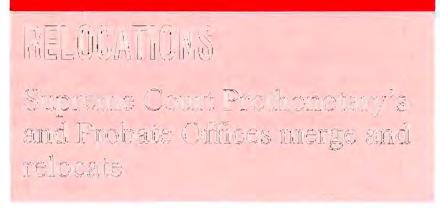
After more than 100 years in the Supreme Court building the Prothonotary's Office has merged with the Probate Office and relocated to 2nd Floor, 436 Lonsdale Street, Melbourne (opposite the Court of Appeal).
The new, combined registries are modem, spacious and service oriented and provide a one stop location for probate and general filing and enquiries.
Business hours remain the same: 9.30 a.m to 1.00 p.m. and 2.00 p.m. to 4.00 p.m.
General enquiry phone numbers are:
Prothonotary's Office 96039300
Probate Office 9603 9295

by the Bar Council in the Essoign Club on 23 November 1995 the Honourable Peter Murphy presented to the Bar a ceremonial sword which once belonged to Sir
Hayden Starke. The sword had been given to him by Mrs. Jan Lloyd, the widow of E.D. Lloyd Q.c. to whom it had been presented by Sir John Starke some years before. John Starke had received it together with other items of judicial paraphernalia from Sir Owen Dixon when he was appointed to the Supreme Court in January 1964. Sir Hayden Starke left those things In Dixon's keeping when he retired from the High Court precisely fourteen years before his son's appointment. It would be nice to be able to say that they were left with Dixon as custodian for John Starke but the truth is that Sir Hayden simply abandoned them when he left the bench.
Though intended to be ceremonial, the sword is not an innocent object. It is a rapier encased in a scabbard for attachment to a belt. The blade has cutting edges and a sharp point. The hilt and the upper part of the blade are decorated with marcasite studs. There is an element of uncertainty about its ceremonial significance. It has been suggested that it was part of the insignia of a Knight Commander of the Most Distinguished Order of St. Michael and St. George. But I recollect being told by Sir Owen Dixon that it was part of the full Windsor dress, which included tail coat, knee
breeches, buckle shoes, lace cuffs and kid gloves, that would be worn at Court. He had a similar sword and a tricorn hat! (which like the sword I never saw him carry, though as Chief Justice he wore the other accou-
trements to administer the oaths of office to an Administrator on the death of a GovernorGeneral) . John Starke told me that he wrote to thank Dixon for the kind gift, which from the way he spoke he seemed to regard as the last link in a chain of reconciliation with his father. He said that he had reminded Dixon that a sword was not part of the ceremonial outfit of a judge of the Supreme Court. Whatever may have been the sentimental significance of Dixon's act, John Starke had no attachment to the sword and he gave it to his friend Woods Lloyd who had a lifelong fascination with martial objects.
It is appropriate that
the Bar should hold a memento of Sir Hayden Starke. His name adorns no set of chambers. It is attached to no lecture or prize. No wall bears his portrait. Like that of J.A. Hamilton, Viscount Sumner, whose personality and career his own in some ways resembled, his reputation, though great in his time, has tended to fade so that amongst present members ofthe bar he
I A photograph of Sir Owen Dixon c a rrying the tricorn appears at p. 64 of J.M. Bennett's monograph Keystone of the Federal Arch (Australian Government Publishing Services , 1980) where the tricorn is said to be "now obsolete ".

is known almost as much as the father of his son as for his own achievements. Yet they were substantial. For most of the twenty years before his appointment to the High Court in 1920 he was the dominant advocate at the Victorian Bar. Dixon said of him on his death that "his legal knowledge, his discriminating judgment as to what mattered, his clearness and directness of speech and the strength of his mind and character combined to give him a forensic power as formidable as I have seen".
Starke had been the first to join the bar after qualifying for practice through the articled clerks course This became possible with the fusion legislation. His father was a doctor who died on the goldfields from typhoid when Hayden Starke was six years old. He was brought up by his mother who took positions as postmistress in various country towns and eventually at Clifton Hill. He received his formal education at state schools wherever his mother's employment took them. His last six months of schooling were spent at Scotch College to improve his Latin in preparation for law . Family circumstances did not enable him to attend university full time and so he was articled in the firm that became Weigall and Crowther. He was an outstanding student, becoming secretary of the Law Students' Society and winning the Supreme Court Judges' Prize for articled clerks. He was a keen competitive rower. He came to the bar immediately upon his admission in 1892. There could hardly have been a worse time in the economic fortunes of the colony to do so but Starke not only survived but flourished. He never took silk, declining an offer from Sir John Madden in 1912 on the ground that he had no private income and preferred the flexibility of practice as a senior junior to lead in important cases without losing other lucrative work and a second offer from Sir William Irvine in 1919 on the ground that he had not served in the world war. In 1909 he married Margaret Mary (known as Maria) Gavan Duffy, daughter of a solicitor John Gavan Duffy who belonged to the politico-legal family of that name. As a gesture of thanks to his mother and sister, Starke paid for a voyage "home" in the S.S Waratah and was devastated when it was lost without trace between Mauritius and Durban. He is said to have been the only relative of passengers on the ship to be represented by counsel at the Admiralty inquiry into its loss.
Starke was appointed to the High Court on 5 February 1920 on the death of Sir Edmund Barton . He was the fourth judge to have been appointed from the Victorian bar , the others being Isaacs, Higgins and Frank Gavan Duffy, a halfbrother of his wife's father. With Isaacs and Higgins he had little in common, but one of his early acts was to instigate the reconsideration in the Engineers' Case of the doctrines developed by the
Court in its early years of reserved State powers and the immunity of instrumentalities. He joined in the judgment written for the majority by Isaacs, the price of his accession being the modification of the original draft. Even so, he later regretted his part in the sea-change in constitutional principles that occurred with that case and became a bitter critic of its baneful influence.
Starke carried with him to the bench the ferocious independence that had marked his career as a barrister. He did not care for most of his colleagues and did not hide his feelings His belief in the absolute importance of each judge's bringing an independent mind to judgment led him in most cases to prepare his own reasons. These were written lucidly and concisely, with never an eye to posterity, and were directed to the solution of the case in hand . They reveal a mastery of principles over the whole field of law Personal relationships on the Court deteriorated with the appointment of H.V. Evatt and E.A. McTiernan in 1930 and that of Starke's former pupil Sir John Latham, as Chief Justice in 1935 . Dixon alone h eld the ring . As his entry in the Australian Dictionary of Biography puts it, Starke's adherence to a strict code of honour yielded little to human frailty and it prevented him from working amicably with his colleagues. So it was too in his relationship with his son John. Breach was almost inevitable. In a sense, the war which took John from Australia came none too soon. During the war, with the Court depleted by the successive absences of Latham and Dixon, Starke became an influential figure. Legalistic attempts to escape wartime controls received short shrift but he was concerned that fundamental rights should not be lost to the cause of expedience. His last major case was Bank of New South Wales v. The Commonwealth (1948). He retired in January 1950 just short of his seventy-ninth birthday . He died on 14 May 1958.
In his later years he and Lady Starke lived in an apartment at "Myoora" in Irving Road, Toorak. I remember dining there as a child with friends of my parents. Midway through the meal the doors of the dining room opened and there entered a tall elderly man with close-cropped white hair , his wife, a lady of grace and beauty , on his arm . Our host was normally in awe of no-one, but I remember the tone of his saying "That's Sir Hayden and Lady Starke". The impression of the bearing of the old couple was indelible.
The ceremonial sword, as a symbol of strength and honour, is a fitting remembrance of Sir Hayden Starke for the Bar. It will be placed in a cabinet in the Bar Council rooms until a suitable place for the exhibition of it and other memorabilia is found elsewhere in chambers.
James Merralls

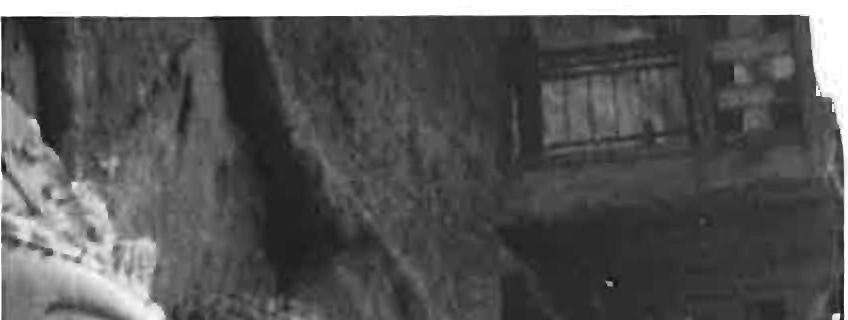

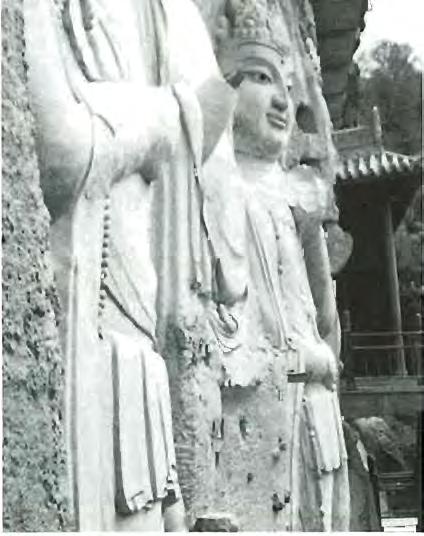
It seems that the editors of this tome got such response last year from my perambulations in the East that they wanted a return visit! What could I do but oblige them?
In August and September this year I revisited Beijing, for a Law Asia conference, and trotted off to parts of China as yet unexplored by Sparke feet.
Once again I was struck by the absence of the rule oflaw, made all the more pungent by the farcical nature ofthe conference (how great the Chinese legal system, how much it's contributing to peace and development in the Asia-Pacific, how "important" the speeches. More on that in another article.
(To be fair, I did later witness the traffic-control system at its best, as a uniformed man took control of the chaotic streetscape of LinXia after a three tricycle pile-up.)
I must say, the highlight of the conference was probably shopping with an English barrister at the " Beijing Snowman Dress and Personal Adornment Company".
I was not looking forward to a return to Beijing - it is not an attractive city, and I thought I had "done" the tourist attractions to death. But I was surprised, and moved, to find a stunning set of images in an out of the way temple in the northern suburbs. The temple contains a photographic exhibition of the development of glorious Chinafrom defeating the British at Canton to sending Long March Missiles into space. In the middle, of course, was the war with Japan, recorded in photographs by both sides, step by brutal step.
The photographs are stunning in the literal sense of the word - they strike you with a physical force The bland eye of the photographer records the bound Chinese man on his knees, executioner 's sword poised over his head; a headless body, so recently decapitated the blood is still spurting from the cut; the row of rotting and emaciated heads on sticks; the pile of children's mutilated bodies; the dead woman with sliced open genitals - the first photograph is quite famous, the rest unknown.
No longer would I wonder at the fear and hatred the peasants in the south (and the Chinese
Government also, although thinly disguised) reserve for the Japanese. Not even perhaps at their desire to have male children "in case of bandits" (see last year's article).
The exhibition is presented as bland historyno propaganda is attached, nor any emotion.
(Contrasted, of course, with the very public display of photographs at the Summer Palace, which record the glorious liberation of Tibet. The bringing of the Tibetan people from poverty to civilisation Happy Tibetan peasants embracing mother China. All this, while the Tibetan borders are closed for the 30-year anniversary of the "liberation" of China and the streets of Lhasa seethe with soldiers. )
The capacity of the Chinese to ignore the truth never ceases to amaze me. There are legitimate arguments as to the beneficial nature of the Chinese occupation of Tibet and the introduction of railways and electricity, but officially China will never recognise the status quo as an occupation, nor of the problems which have accompanied the benefits.
Be that as it may, onward I flew to Dunhuang, in the Gobi desert.
Extraordinary landscapes of mythical proportion - huge sand dunes, over which Lawrence of
Arabia might appear any moment. I climbed, felt the desolation of the desert, admired the fortitude of the earliest inhabitants (and Marco Polo, who travelled through here and is held in pretty high esteem in these parts - especially for a foreigner) and had a frivolous go at parasailing. Of course, any Chinese tourist attraction is accompanied by hawkers - in this case, the camel drivers, who travel to work by bicycle or motorbike, leading their camels behind them.
I travelled from there southward along the railway line The route is part of the Silk Road. The style of this part of China is quite unusual. There is a large preponderance of Muslims - the influence from Pakistan Gust across the border) - and the ancient influence from the Middle East is strongly felt. A largely ignored population in China (as are any non-Han minorities) the Muslims have quite a separate lifestyle. And unlike other populations, they have strongly held the attachment to their religion. Minarets are obvious in many towns, and they apparently practised Islam relatively untouched throughout the upheavals of the Cultural Revolution.
The other influence along the Silk Road, is the very ancient hand of Buddhism. In Dunhuang and in many places further south, there are grottoes,

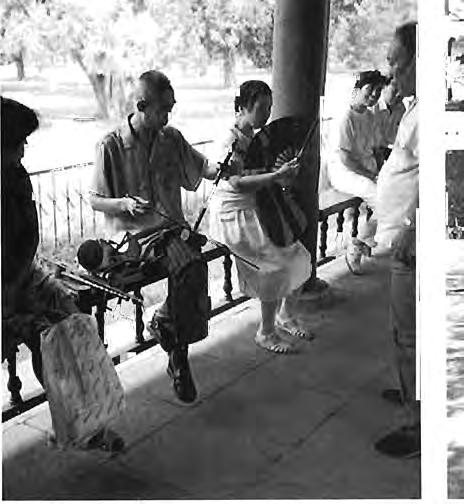

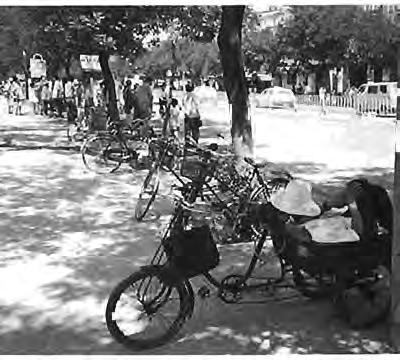
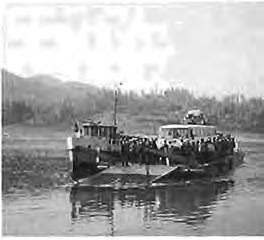
service

caves, mountains and every manner of natural artefact, carved with Buddhas. The Silk Road is the route by which Buddhism entered China from India, and the ancient nature of the carvings is evident. The carvings are universally stunning. Some are huge, some are small. They range in age from very old, Indian-style Buddhas (slim figures, with close fitting robes and simple adornment, and with fleshier faces) to more modem (say, a mere 1000 years old) Chinese influenced figures - gold leaf and intricate paintings, the advent of the dragon and phoenix symbols (imperial symbols throughout China's history, adapted to Buddhist art) and well-fed, jolly faced Buddhas. Not much in the way of asceticism in Chinese Buddhism!
Some of these carvings must rank with the pyramids as being great wonders of ancient religious worship. (At least that's what I think - the Chinese tourists who visit seem to be more interested in them as a venue for picnics.)
Near Jiayuguan there are tombs, 1,800 years old and nearly perfectly preserved. (Thanks to the fact that a candle is left burning when they are sealed airtight - the oxygen is consumed and the wall paintings left in pristine condition.) They are better than the pyramids by a long way for a glimpse into history - paintings showing everyday life 1,800 years ago (including a "kebabo" BBQ), social customs, agriculture, climate (the mulberry trees depicted could not survive the climate now - it must have been wetter then) and the nature of greed. Like the pyramids, the treasure had been plundered in recent years and a robber's corpse left behind to tell the tale.
Southward I continued - past the far western end of the Great Wall reconstructed by students in 1987 in the glorious tradition of A.V. Jennings, with modem bricks to look like a modem version of the wall. The real end of the wall is a crumbling mound. Nonetheless, as I am further from Beijing
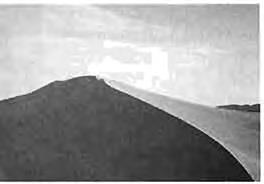
then Perth from Melbourne, the enormity of the exercise is impressive!
Westward this time - to Xiahe, a village close to the Tibetan border. Touted by the Lonely Planet as a touch of paradise, here is a Tibetan monastery surrounded by village. The monastery town is extraordinary - 3,000 monks in training, who roam the streets in robes of burgundy, pink, orange, saffron etc. and yellow hats. The monastery is lovingly kept, and is an attraction for both foreign and local tourists. The foreigners to see the magnificent art and buildings. The locals to walk the pilgrims way.
The pilgrims way is a path of prayer wheels, 1 km long, which encircles the monastery.
I followed the pilgrims one morning - ancient men and women (and, gratifyingly, young people and children also). People battered by the sun and the sheer hard work of life. Dressed in their best and doing the morning ritual. They walk, and chant prayers with prayer beads. They spin the prayer wheels, and touch walls and comers of buildings. The whole exercise becomes trancelike - the chanting and the repetitive spinning become very focused. I even found myself falling into a rhythm of walking and spinning, which was quite hypnotic.
The pilgrims here are Tibetan. Most come from the adjoining village and from the surrounding countryside. They universally wear a large black or dark blue woollen robe. Warm in winter, and worn cooler in summer by leaving the top part dangling from the belted waist. The belt is ornate - with inlaid white stone and elaborate carved ornaments. There is always a dagger in the belt. (This is not just ceremonial dress - it is commonly worn in the village and the fields.) The women wear their hair long - in plaits which seem to be a metre long.
They speak Tibetan, have a hankering for
images of the Dalai Lama and eat the most revolting food imaginable. I was fortunate enough to share a meal with three old women under a tree, over a billy. They made me yak milk tea with milk fresh from the yak, which had obviously just been milked into the large plastic bag they carried The tea was pretty good - apparently it is usually drunk with a slab of yak butter and salt added, which makes it completely repulsive.
They then fed me Tsampa -a combination of ground barley, yak butter and yak milk. A bland dough, but I was a bit worried (even I, with my strong stom-
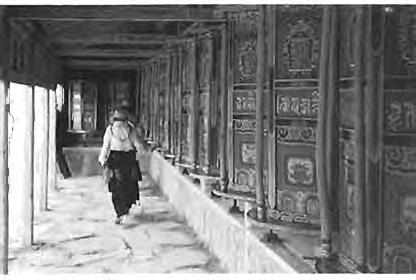
The pilgrim's prayer way ach) about the yak butter, which was fished out with filthy fingers from a filthy pot full of bits. (Bits of what, I will never know and do not want to.) (And for anyone who is interestedno, I wasn't ill from the meal.)

Paradise is right we were sitting under the tree by a clean (I) river, trying to conduct Tibetan monks debating a bit of idle chit-chat in limited Chinese (both them, who probably normally spoke Tibetan, and me). They insisted on going through my backpack for images of the Dalai Lama. They told me their ages (unbelievably, I later saw the 73 year old walking along with a huge pile of kindling on her back), played with my hair and my sunburnt skin and slapped my thighs ("good child-bearing hips and thighs" I imagine was the translation). Wonderful the stuff of which travel is made!
that. In Yangshuo, on the night of the moon festival (a very big party night) there were hundreds of teenage boys in the streets (very few girls, which makes me wonder where they are). There was a great party atmosphere, but also an air of tension. A gathering which in the West would probably erupt in the odd brawl or two. The same boys can be seen in the surrounding villages during the day doing nothing. I hardly blame them - they are caught up in an economy which is very rapidly switching from Statesupported to private enterprise. That switch is beginning to leave people behind. The State is going bankrupt - it is laying people off and is not paying people it employs. It is slow to take new people on.


Unfortunately, the children of the Tibetan village were made of a different stuff to their elders. On my daily walk through the village to get to town, I was hit and jumped on by small children . They tried to grab my bags. They constantly begsimply by demanding that you give them things. All of this is done with the full approval of their parents, who can occasionally be seen shoving the children out into the street as a foreigner walks past and whispering things to the children which they repeat to the foreigner as a demand.
They have no compunction about whacking an adult and I wonder how they are going to grow up.
This is not the only place where I wondered at
Young people no longer have a promise of employment by the State, or in the countryside. They are being left without some of the traditional support structures which have characterised this tightly controlled society. Apparently, the rate of all crimes is increasingincluding violent crime (for example, theft from foreigners has always been common, but violent crime almost unheard of not so any more). Other travellers expressed to me their occasional fear of walking the streets. There is apparently a rising incidence of gangs and gang crimes.

I travelled on - to Lan z hou, Maijishan, Xi'an, Guilin, Yangshuo, Hong Kong and Macau. Too much for this small space. (Unless, of course, public demand is such that I am compelled (!) to write chapter 3.)
None of my earlier comment is a condemnation of Chinese society, as it reaches for Western ideas and values. It is, however, a noticeable change from my travels a year ago. The society is changing very rapidly, and with Deng Xiaoping on his death-bed , the next few years in China will be very interesting. I fear, however , that they may fulfil that old Chinese curse - "may you live in interesting times".
Interesting times indeed.
Carolyn Sparke

According to the June edition of Australian Lawyer the President of the Australian Chapter of the International Wine Lawyers' Association is a Mr. Drinkwater.
17 October 1995
Coram: Tuppen M.
Police prosecutor reading summary relating to the accused in the dock who was charged with assaulting police and resisting arrest:
"The accused was taken to the station where he grabbed the crotch of Constable X very forcibly. It took some time to prize open his grip. Constable X suffered bruising and sore testicles as a result."
The two police officers sitting with the accused in the dock looked at each other with horror and moved their chairs backwards from the accused.
The accused remained asleep.
10 May 1995
Coram: Mr. McLeod M. Burnett for the Defendant
The magistrate is conducting a call over of the defendant criminal cases for the day:
Mr. McLeod: "Now Mr. Burnett what is your case all about?"
Burnett: "My client is charged with offensive behaviour in that he is alleged to have been masturbating in the passenger seat of a taxi."
Mr. McLeod: "What's the defence?"
Burnett: "It is contended that the act was involuntary due to my client's extreme intoxication at the time."
Mr. McLeod: "Pull the other one, Mr. Burnett."
9 October 1995
Boylan v. Frankling Grain Pty Ltd
The court refused to sit until the appellant's solicitor handed to the President's Associate a receipt for the $260 daily hearing fee. When the court did
sit it was announced that the appeal would be adjourned sine die.
Berkeley for the Appellant: "Your Honour does this mean that we get our $260 back?"
President: "I'm sorry Mr. Berkeley we've already split it three ways ."
5 June 1995
Keller v Obe Group (Investments) Limited
Coram : Gray 1.
Gray J: "The reasons of the Social Securities Appeals Tribunal, which I have read, do not indicate that the applicant would be unfit by reason of the condition he then suffered to attend and address the court. He has appeared in person, both before a judicial registrar of the court and before Keeley J. of whose judgment of 19 April 1995 he complains. Nor am I satisfied by the medical certificate faxed today. Its illegibility is one of the difficulties . More importantly, however, it indicates an unfitness for school and does not specifically address the question whether the applicant is able to attend court and, ifso, to address the court."
Friday 10 November 1995
Coram: McLennan, M.
Th e Commonwealth DPP v. Kevin Patrick
Donovan, Stephen James Howard, John Patrick
Kavanagh, David Ross Mackie, William Edward Turner, Robert Ralph Williams and Peter Gerald Mas sey
Mr. Faris Q.c., with him Mr. Webster and Ms. Carlin for the prosecution.
Mr. Weinberg Q.c., with him Mr. Chettle for Howard until 6 December 1994 . Thereafter, Mr. Chettle for Howard.
Mr. M. Weinberg Q.c., with him Mr. G. Chettle for Donovan.
Mr. D. Grace Q.c., with him Mr. Hale for Mackie
Mr . R. Lopez for Massey until 26 September 1994. From 19 December 1994, Mr. Chettle for Massey .
Mr. D. Galbally for Kavanagh until 8 June 1995. Mr. H. Wilcox for Turner until 8 June 1995. Thereafter, Mr. Grey for Turner. Mr. R. Marron for Williams.
Mr Chettle: On behalf of everyone at the Bar table , thank you, Your Worship , for your patience , even though my clients have obviously been discharged, for the amount of time and energy which has obviously gone into this decision. It is a magnificent piece of work and we very much appreciate the effort Your Worship has put into it. I don't say that because my clients have been discharged, I do say that genuinely, Your Worship, I have never seen a judgment as well written in a Magistrates' Court ever, it is just sensational.
25 September 1990
The Queen v. Satwant Singh Coram: Judge Fricke
S Bruckard for the Crown G. Maguire for the accused
The accused had pleaded guilty to conspiring to arrange sham marriages to enable parties to obtain permanent residence in Australia
On the plea, Maguire was outlining the


a c cu ed ' own marit a l hi s tory . whi c h included four marria ges in three c o untri es within the previous nine years includjng g e nuine e s, a sham and th e n a remarria e cond wife
His Honour: Does he have a drip-dry wedding suit?
Coram : Gallop 1. Tax Fraud Prosecution
Lasry Q.c. and Champion prosecuting Salmon Q.c. of the Sydney Bar for one of the accused Adams for other accused
Salmon cross-examining accomplice witness. Salmon: And why it was raised? .. . Well , what I do remember is that it was, on Terry's part, a validation of this currency program working.
Adams: I object to that as an expression of opinlOn.
His Honour: Well, I am afraid if she is asked a question which involves drawing a conclusion from the whole of the circumstances I do not think you can object to it, Mr. Adams Adams: If Your Honour pleases.
His Honour: You can stick a dagger in Mr. Salmon , if you like. He asked the question and he got an answer.

PICTURE IF YOU WILL BREAKFASTING ON a magnificent landscaped terrace overlooking the blue Mediterranean. Yes, that was the scene enjoyed by delegates and partners at the Fifth Greelel Australian International Legal-Medical Conference held on the island of Crete from 21-25 May 1995. The actual location of the conference was at the Capsis Beach Hotel and Bungalows, a fine Greek hotel and convention centre located on the picturesque peninsula Agia Pelagia approximately 22 kilometres west of Iraklion city.
Like so much of Greece, the largest and southern-most island of Greece, Crete, is divided into four prefectures, each with an administrative capital: Lassithi (the capital: Agios Nikolaos), Iraklion, Rethymnon and Hania, the last three prefectures the capitals of which have the same name as the prefectures.



World's oldest written code

The tradition and culture of Crete is unique and very different to the mainland. That in itself ensured delegates and partners experienced a most memorable stay.
Mythology has it that Crete is birthplace of the god Zeus, the father of the gods of ancient Greece. Crete is also the birthplace of the Minoan civilisation, the early period of the civilisation flourishing from 3,000-2,100 B.C., the middle Minoan period from 2,100-1,500 B.C. and the late Minoan period from 1,500- 1,100 B.C. The Minoans flourished and developed unprecedented skills in construction, engineering, artistic and cultural achievements. Today, the Minoans are best known for the exquisite Kamares pottery, craftsmanship in silver, a theme in all their jewellery and their strong trade links with greater Asia Minor. The ruins of four palaces are still very evident and a must for the tourist located at Knossos, Phaestos, Malia and Zakros. Knossos is the largest of the palaces and within easy travelling distance south of Iraklion, mid-north coast of Crete. The Archaeological Museum in Iraklion houses all the Minoan treasures and includes the famous Phaestos Disc, Kamares ware vases and a magnificent bull' s head, a libation vessel.
Undeterred, the Minoans enjoyed a catastrophic earthquake around 1,700 B.c. wherein archaeologists inform us all four palatial complexes were destroyed. True to their culture, the Minoans reconstructed their palaces with even grander layout most evident in the ruins at Knossos and Phaestos.

Around 1,500 B.C. at the height of their civilisation, the Minoan civilisation was destroyed. There is considerable debate among archaeologists about the cause of the destruction. It was probably caused by a Mycenaean invasion, orthe other theory, cataclysmic volcanic eruption which took place on the island of Thira (now called Santorini) to the north of Crete.
As mythology has it, the father of all the Greek gods, Zeus , chose to be born and grow to manhood on the island of Crete.
Back to the conference itself, the Crete Conference Committee under the chairmanship of Miss Eugenia Mitrakas and deputy chairmanship of Professor Graham Burrows and Mr. Jack Hardy, planned, organised and delivered a most memorable conference. The diversity of medical and legal sessions meant a topic of interest for each and every delegate. Mr. Justice Norman O'Bryan was in charge of the professional program which ensured the timetabling of all sessions and the co-ordination of speakers kept the ship on an even keel. The fusion of medical and legal issues in the topics delivered by the speakers ensured a most interesting and diverse range of issues, the calibre of which was second to none. Topics ranged from insanity in the Criminal delivered by Mr. Justice George Hampel to The Modern Phenomenon of

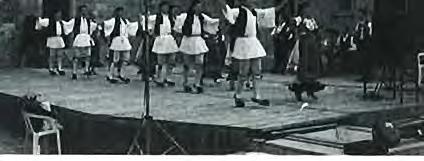
Child Sexual Abuse Allegations - A Unique Challenge for the Medical and Legal Professions delivered by Mr Justice John Fogarty, and Mr. Justice John Hedigan's subject Privilege and Confidentiality in Medical Communications. Not to be outdone, speakers from the Australian medical fraternity delivered papers of equal calibre with Professor Richard Ball speaking on the topic Se lf Mutilation in the Correctional and Psychiatric Field, the Gary David Story, with Professor Patricia Kincaid-Smith speaking on the topic Priorities in Medicine, a most illuminating paper. The conference was enriched by a strong contingent from the Greek medical and legal fraternity with some most interesting papers delivered by this contingent including a study on child nutrition on

the island of Crete delivered by Professor Kafatos, the paper entitled Nutritional Changes and Child Abuse.
Reference to the abovementioned speakers and topi es is but a small sprinkling of the depth and breadth of the papers delivered by Austra l ian and Greek delegates Congratulations to them all. Be rest assured, delegates returning to Australia and other parts of Greece at the conclusion of the conference derived an enrichment in a setting of visual and cultural splendour second to none.
The social calendar during the conference equalled the calibre of the professional program. Like previous legal and medical conferences in Greece, Miss Mitrakas and Mr. Hardy ensured through exhaustive diligence and even a "dry run" of various tours that the content in the social calendar left delegates and partners with a broad choice of venues and experiences enriching all delegates and partners.
As with any visit to Crete, a must is the Minoan palace of Knossos and the Archaeological Museum at Iraklion hOll ing the treasures of the Minoan age.



all parts of Greece. The setting for this concert wa magnificent in the old Venetian fo.rtres abutting the old harbour, also called the Venetian harbour at Iraklion.
During the afternoon and evening of the third day of the conference, delegates enjoyed a guided tour travelling outh of the conference facility to the ancient archaeological of Gortyn , approximately 46 kilometres south-west of lraklion. The site is famous for the massive stone tablets which in cribe the law of Gortyn, the basis of much modern law. From there delegates proceeded to the archaeo logical ruins of the Ba ilica of St Tito , the fil · thisbop of Crete and a protege ofSt Paul. From thence, delegate and partners proceeded to the second largest of the Minoan palace at Phae. to , considerably smaller than the archaeological ruin at Kno 0 but with an awe-inspiring view of the Me ara plain and Mt Ida






True to the calibre of cultural and ocial experience enjoyed by delegates and partner at previou medical and legal conferences, a visit to Rethymnon with it Venetian quarter of narrow aIley ways set within a picture que harbour was a must for all those wiShing to wine and dine and enjoy traditional Cretan culture and cuisine




Other delegates and partners enjoyed a day tour to Spinalonga Peninsula and a ferry boat trip to Spinalonga Island which is located approximately 80 to 100 kilometres ea t ofIraklion.
Spinalonga Island is famous for its fortress built by the Venetians in 1579 to protect Elounda and Mirabella Bays . The island withstood continuous Turkish seizure finally surrendering in 1715 •. orne 30 years after the rest of Crete had been conquered. A l 0 infamou in the island 's history is the fact that Spinalonga Island became a leper colony the last of the lepers dying there in 1953 . The land now i · uninhabited, but remnants of the old Venetian quarter later used by lepers are still self-evident at the base of the magnificent Venetian fortress.





On the evening of the second day of the conference delegates and partners enjoyed a twi l ight conceit of traditiona l dancing upported by mu icians of the highest performing at lea t eight traditional dances in traditional costume from


In 1997 the Sixth Greek!Australian International Legal and Medical Conference will be held at Thessaloniki, the second city of Byzantium and the second city of modern Greece. Thessaloniki is located atop the Thennaic Gulf within the State of Macedonia in northern Greece. It is understood Thessaloniki has been chosen as the cultural capital of the E.U. in 1997. Delegates and partner can look forward to a wonderful experience in thi host city. The conference is scheduled from 1 6 June 1997 with a po t-conference tour tentatively set for Gallipoli For those who have enjoyed the culnlral ity of Greece the sixth conference will prove to be a magnificent reunion For the uninitiated , one can only recommend the Sixth Greek/Australian International Legal and Medical Conference, you won't be disappointed.

Stephen Jones

IN A LANDMARK DECISION WHICH THE TRIALS raised issues covering the negligence of police officers following a shooting and whether the police officers were then immune from liability, the Full Court of the Supreme Court of Victoria unanimously dismissed an Appeal by the State of Victoria and one police officer.
The "incident" lasted only seven or eight minutes, although the events were played out in resultant criminal and civil trials over the course of the next ten years.
On 5 October 1985 "Paul" was seated in his bedroom contemplating suicide . He had in his possession a loaded shotgun
The police attended the premises in response to a request from Paul's father. The police went to Paul's bedroom.
There was an exchange of words, and Paul was then shot.
On 13 January 1987 police charged Paul with two counts of attempting to shoot with intent to do grievous bodily harm and two counts of assault (contrary to ss 17 and 40 of the Crimes Act 1958).
A committal hearing was conducted on 23 January 1987 and Paul was committed for trial in the County Court of Victoria at Melbourne
On 25 February 1987 Paul commenced civil proceedings in the Supreme Court of Victoria at Melbourne against the two police officers and the State of Victoria.
The criminal trial commenced on 2 October 1987 before His Honour Judge Duggan. The police officers (including the first and second defendants in the civil case) gave their version of events.
The civil trial commenced in the Supreme Court of Victoria on 3 March 1993 before the Honourable Mr. Justice Teague The police officers (including the first and second defendants) again gave their version of events with a different emphasis.
The confrontation between Paul and the police officers that was evident from the criminal trial was replaced by a passive and serene approach in the civil trial. The facts and evidence were presented, argued and portrayed in different ways in each trial.
The sergeant and the constable had their revolvers drawn and the sergeant said to the constable "tell me when you're set" The constable replied "I'm set". The door to the bedroom opens and two shots are fired. A 22-year-old male person sitting in the bedroom is shot in the abdomen and in the right thumb. An ambulance is called. The English language is on trial.
On 5 October 1985 Paul, a diagnosed paranoid schizophrenic is in a depressed state of mind. He wanted to commit suicide. He goes to his father's wardrobe and obtains a Browning 12 gauge shotgun, loads the shotgun with one cartridge and goes to his bedroom and closes the door. The music is loud His father comes to the bedroom to tell Paul to turn the music down. He sees Paul with the shotgun resting by his side. His father is worried and calls the police for help The police arrive to what is described in police language as a "domestic". The father is in an excitable state and speaks with the police officers and says that his son may be [mentally] sick.
The police officers then enter the house. Two police officers draw their revolvers and walk up the passageway to the bedroom . There is a knock on the door, the door opens and a conversation occurs between two police officers and Paul. The police officers say "put down the gun", Paul says "go away, leave me alone". The police officers say the gun was pointed at the head of one of the police officers. Paul says the gun is resting across his lap The police open fire and Paul is shot.
From the time of the arrival of the police to help at "the domestic" until the ambulance is called is about seven or eight minutes. Paul is taken to hospital suffering from life threatening injuries which require emergency surgery and intensive care
Paul makes a slow recovery from the physical injuries and is still coming to terms with his mental state In October 1987, in the County Court of Victoria, the D .P.P. presented that on 5 October 1985 Paul attempted to discharge a loaded firearm at a police officer with intent to do grievous bodily harm and further, made use of a firearm (namely a shotgun) with intent to resist the lawful apprehension (of himself?).
During the course of the six-day criminal trial

various witnes 'es gave e v idence. Paul did not give evidence. The police gave evid e nce that they were confronted by Paul pointing the gun at the head of one of the police officers and that Paul then brought his right hand back on the gun and appeared to be pulling the trigger. Ballistic evidence confinned the gun was loaded and was ready to fire .
The police also allege they had twice told Paul to "put down the gun" and Paul had twice said "Get fucked".
The judge directed that the jury must be satisfied that th e pro ecution had established, beyond rea sonable doubt that Paul had attempted to discharge the shotgun with intent to do a police officer g ri e vou. bodily hann.

The jury deliberated. The verdict was not guilty.
In February 1987, Paul commenced civil proceedings in the Supreme Court of Victoria against two police officers and the State of Victoria.
Paul claimed damage on the ground s of negligence , assault and battery wrongful arrest, false impri onment and breach of s tatutory duty. T he two police office rs denied l iability and alleged they were immune from liability and negli g ence on (he g round of public policy contributory neglig ence and la wful e xcu e.


After all, Paul had voluntarily consented to the risk of being shot.
The State of Victoria admitted vicarious liability for any negligence or battery of the two police officers. The State of Victoria also said that no duty of care was owed to Paul by reason of engaging in unlawful conduct with criminal intent towards the police officers immediately prior to him being shot.
The matter proceeded before a civil jury in the Supreme Court of Victoria and various lay and expert witnesses gave evidence on behalf of Paul and the police . Paul gave evidence that the gun was resting across his lap and denied he attempted , or had intention , to shoot the police.

After 17 days of trial, a civil jury returned a verdict that one of the police officers was negligent in the CO'llrse of his duty and awarded damage in favour of Paul in the um of $116 ,000 (with 10% contributory negUgence).


The police alleged in the civil trial that they were doing nothing more than their duty required. In attending the domestic situation", common sense prevails and the police officers were endeavouring to "communicate" and to find out what the problem was During the period of police training then undertaken, police received training in various facets of police work including aIDled offenders and ho tage and siege situation s . The training manual stated that the aim of the police in any situation is to protect life and property and
that the plan must be simple and effective to contain the situation. Time is of the essence to reduce tension and to negotiate a sensible settlement of the problem.
The police during the course of the criminal trial said Paul had attempted to discharge the shotgun and resisted arrest. In the civil trial the police maintained that the situation that arose on 5 October 1985 was a "domestic", and the aims and plan stated during the course of training was relevant, although this depended on the circumstances and a large amount depended on the use of "common sense".
The police now say they "wanted to communicate". Paul says that communication in the fonn of gun drawn and c onversation between the police officers ("tell me when you re ct ' ) led to a confrontation which inevitably resulted in injuries contrary to the aim of the situation which was to protect life and property at all costs.
The same "incident" was portrayed in different ways in the criminal and civil jurisdiction. The same witnesses, the same circumstances and a different emphasis on events that occurred in each trial. The English language was again on trial.
The facts and circumstances surrounding the civil trial are reported in (1994) Australian Torts Reporter 81-280.
John Edgar is a partner with Browne & Co

The minutes of a special meeting of the Western Australian Bar Association Inc. held on Wednesday, 16 August 1995, contain the following item . Court Dress - Abolition of wigs, bands and bar jackets

Martin Q .C poke eloquently to thi reasonable , timely and proper motion as did Hal l and Curthoy s. Eaton clarified the finer points of the artorial goings-on of the Fami ly Court ; Pringle Q c. and McIntyre opted for a fonnal ballot; Sanderson reported on the Law Society's disinterest; Nichols enquired as to the likely sanctions for Luddites such as himself who would continue to robe no matter what and accu cd Hall of toadying to solicitor ; Miller Q .C . pointed out that it was only the wearing of wigs which enabled hjm and Percy to maintain th eir anonymity and Buss Q c. thought that be wa not in favour. The vote against tbe motion (lost 10/ 24) wa ensured by the silver tongue of Dawes who exhorted the meeting to express its olidarity with the witch doctors of Mozambique .

"The Flowers that Bloom in the Spring, Tra-La
The Association's annual Spring dinner will be conducted at BYBLOS restaurant, described by the hard-to-please Stephen Downes in the Sunday Age as "as close to the perfect modern bistro as we have yet seen in Melbourne ".
The food is quite stunning - a fine example of the latest in culinary skill coupled with simplicity. Sauces are exemplary, light and wickedly moreish. This isn't "East meets West" - rather "classic cooking meets current gastronomic science". Owner Kostas Metaxas and chef Harry Lilal are trendsetters who will be with us for a long time.
B YBLOS is situated at the old Station Hotel in Prahran. Some of our more chronologically challenged members may have fond memories of the train permanently stuck in the wall of the old Hotel It is now a modern, airy, well-lit delight. The train, sadly, has departed.
I make the usual plea for members to plan ahead and respond early. I, like my predecessor, am an eternal optimist. It is likely that the dinner will fill quickly and circumstances have caused this notice to go out a few days later than usual. Please make a decision ASAP.
Carolyn Burnside
Details
Venue: BYBLOS Restaurant - 96 Greville St, Prahran (opposite the Prahran Station)
Date: Tuesday, 14 November 1995.
Time: 7.00 for 7.45 pm.
Dress: Hey, folks, this is Trendyville. Smart modem stuff! If you don't know what I mean, take a walk down Greville St next Saturday morning! But please, no body piercing!
Cost: $45 per head, including all "special" requirements. Members who have signed the Bar roll since 1994 inclusive - $30 per head. The CBA will be using subscriptions to subsidise a fair amount of the cost.
Members may bring ONE guest.
Special Guests: We are currently arranging a list that will take your breath away
Seating: Allotted. Your secrets are safe with CB. Trust me. I'm a lawyer!
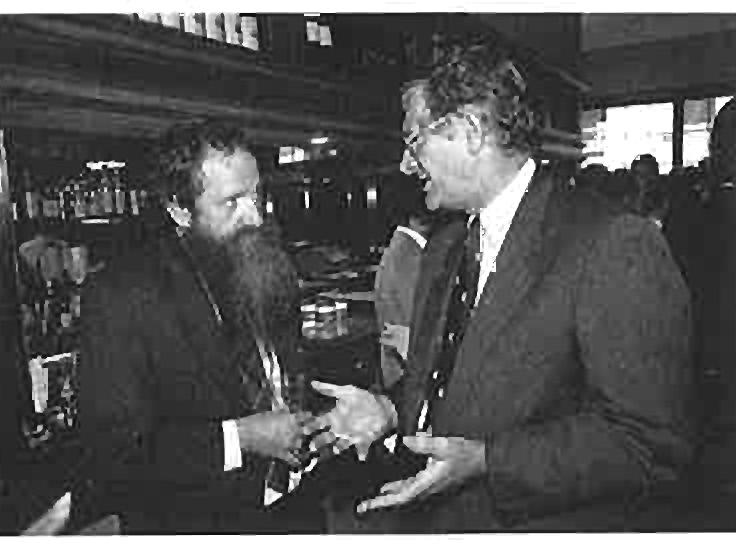
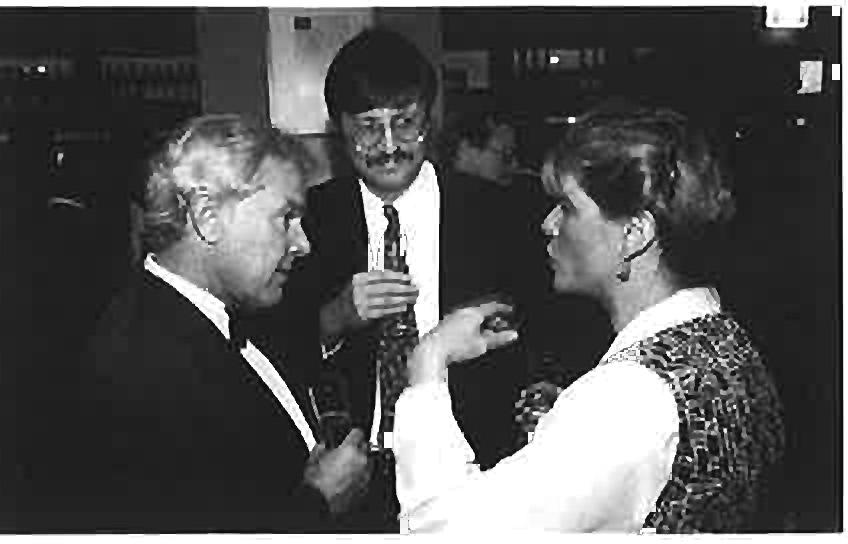
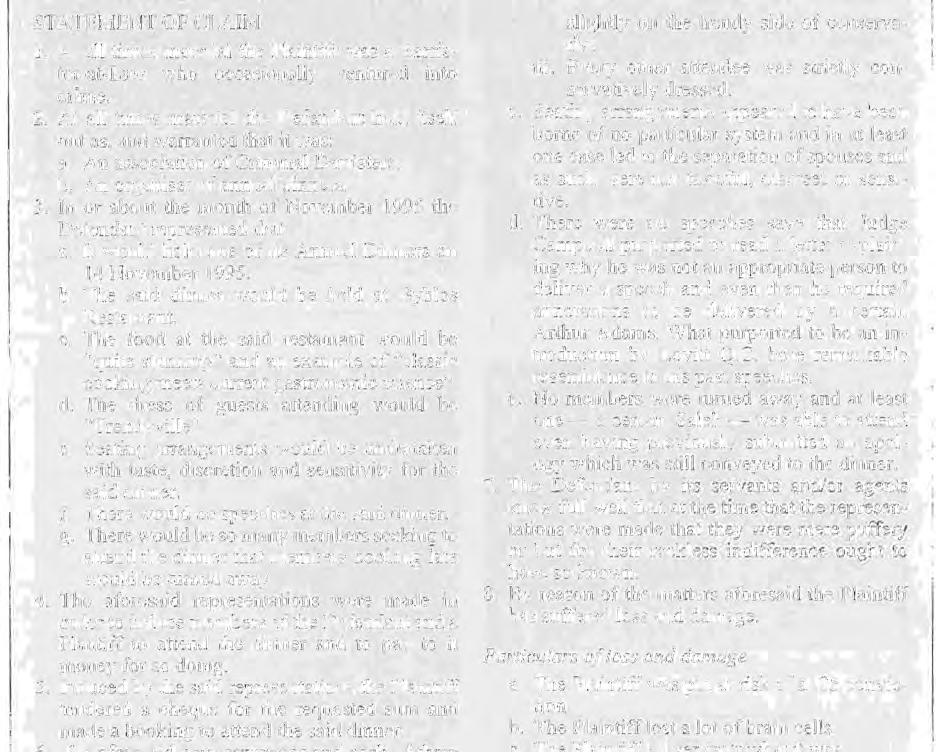
6 . The aforesaid representations and each of them




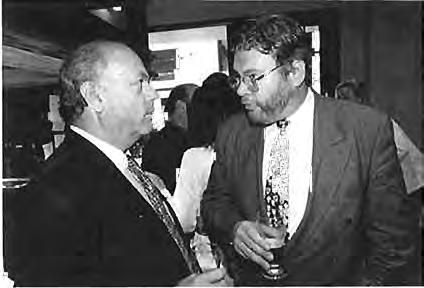

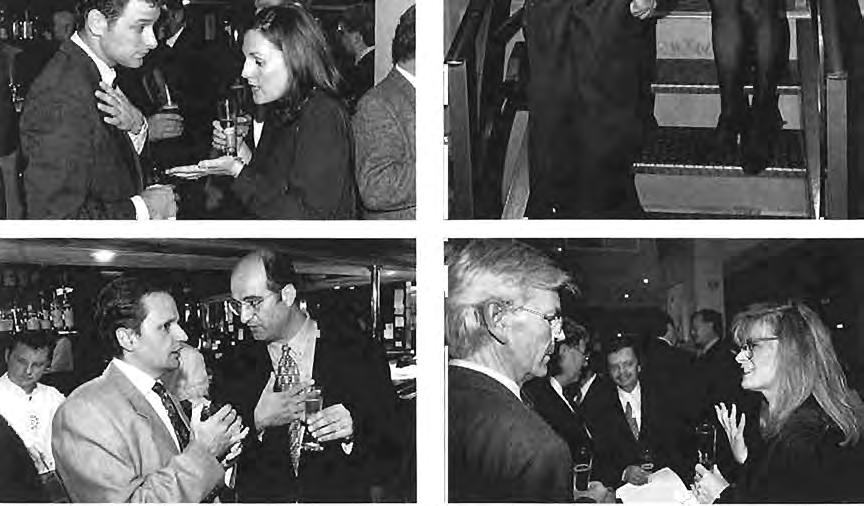
It was a "hands on" function I


AT 6.45 P.M. ON SUNDAY, 26 DECEMBER 1915 a seaman named Slater entered a licensed refreshment house Shortly thereafter he was seen coming out of the shop eati ng an ice-c(eam wafer, part of which he co n umed out ide the s hop. He was charged with unlawfully a idin g and a betting the keeper of the licen sed refreshme nt hou se "to exercise certain worldly labour , business and work in hi s o rdinary caHing of a hop keeper, the same not bei ng a work of nece sity or charity", contrary to the pro v isions of sectio n I of the Sunday Observance Act 16 77.


Section 3 of that Act provid ed that " nothing in this Act contained hall ex nd to the prohibiting of dressing of m ea t in families , or dres ing or e Uing of meat in inns, c o k sho ps or victualling ho.u ses, for uc h as otherwi e ca nn o t be provided". Mr. Slater contended that an ice-cream wafe r was a sweet meat , and was "meat" within s.3 of the Sunday Observance Act. He was convicted. He appealed to the King's Bench Division. For the edification of those interested in the art of statutory interpretation , we set out the judgments handed down in the King's Bench Division in the case of Slater v. Evans [1916] 2 KB 403.






occurred to those who framed the Act that it was necessary to make provi ion again t p eop le being prevented from obtaining their Sunday dinner. Some people prepared that meal at home ; others got it from a coo k s,ho p . Accordingly the mption contained in 3 wa in erted a to the sing of meat on Sunday . We are now asked to say that th e preparing of ice-cream by mixing uga r and ot her ingredient, lidifying them by ice, and putting the mixture betwe e n two biscuit i the dre sing of ' meat." 1 am clearly of opinion that is ot. Whether the wafer wa consumed inside or outside the s hop i for thi purpo e of no materi a lity. With regard to the cases which were cited to \I , I think it is plain that many judges, n liking thi kind of leg is lation I do not like myselfhave tried to ge of the sta tute by holdin g Or ' ugg es tin g that all kinds of thing might be " m eat" although th ey w e r e noL That is not an effec tive way tting rid of the tatut e. In my opinion the best way to attain o bj ect is to COIl true it trictly , in the way tbe Puritan s who procure d it would have con trued it· if that is done it will very soon be repeal e d. The appeal mu t be di mi sed.







DARLING 1. , after stating the facts and referring to the provisions of the Sunday Observance Act, 1677, continued as follows: It is said on behalf of the appellant that the ice-cream wafer bought by him was "meat." That word, I agree, may be used a s denoting anything that can be eaten. We sometimes speak of a thing being as full of something, as "an egg is full of meat"; that "what is one man's meat is another man's poison"; and it is quite common to speak of "meat and drink ." In expressions such as those the word "meat" is of course not limited to flesh. In this case, however, what we have to decide is not whether ice-cream can be described as "meat" in a sense that may be found in a dictionary or in orne proverbial expression, but whether it ca n be de cribed a "meat'> within the meanin g of that term a us ed in . 3 of the Act of 1677 . In my opinion ice-cr ea m cannot be described as " meat" within lhat section The Act wa s intended to prevent people exerci ing their ordinary calling on unday . ome things had necessarily to be permitted and so the tatute makes an exception in favour of "work of nec and c larity ." It al 0




AVORY 1. 1 am of the same opinion. I observe that in Amorette v. James (1) two of the judges suggested that upon some future occa ion it might be held that i.ce-cream came within s . 3 of the Act of 1677 a. bein g " meat." peaking for myself, that occa ion ha not yet arisen. While it may be contended that in secondary ense ce-c rea m may b e " m ea t ," clearly of opinion that it i not " meat" within that i to ay , it is not meat sold "in inns coo ks bops, or victualling hou es for such a otherwise cannot be provided." Therefore on that g round 1 agree that the conviction wa ht and that appeal should be dismissed_





HORRIDGE J. In Amorette v. James ), where tlli point did not direc tly arise, J expressed the view that it was impo s ible to hold as a matter of law that ice-cream must of necc ss ity be "meat" within the section. I agree that this appeal should be dismi sed.
Appeal dismissed
Solicitors for appellant: Wr entmore & Son, for T. W L ewis & Crockett, Pontypridd.

I DO NOT KNOW WHAT IT WAS - PERHAPS th ere wa s something in the air. Whatever it was, it had its effects on at least two of Melbourne's eating establishments one weekend early In September.
Some time ago a c olleague suggested we go to lunch at Bergerac in King Stre et. I had to confess to not knowing of it. " It is good", he said. "I ' ve eaten there before and any way it is a favourite haunt of the 'Red Faces Club ' " On tho se recommendations particularly the unsolicited one from the Red Faces I have no option but to brave a particularly wet and wintry day and join him for a politically incorrect lunch. I wa s heartened to find that half of Melbourne - including some of the Red Faces Club - had had the same idea. It w a s packed!
The food was excell ent and th e service was reasonable allowing for such a crowded day For what we ate, the prices were reasonable, although the wine list was a little pricey. Emboldened by that experienc e I convinc e d my wife and some good friends to venture there one springtim e Saturday evemng.
Our guests were somewhat ta ken aback to see a couple di sappear into the building obviously wearing moccasins . We a ss ured them that those persons were making a differe nt use of the building to that planned by our little group. Bergerac was not particularly busy when we enter ed and it remained that way for the remainder of the evening There was one other table for four and a table for two in use. The re mainder remained untouched. Behind a curtain which ran alongside our table was a large, noi sy, three generational group of French-speaking diners.
Things went astray from the beginning. The waiter insisted on opening the wrong bottles of wine. He then made it clear he did not know the menu; wor se still, rather than look at his own copy of the menu to ascertain what was upon it he learned over the shoulder of one of the ladies upon our table to study her copy of the menu .
The entrees came and went without great trouble although we never got any bread to go with them and some wer e so rich as to require something of th at nature . At that time our waiter was nowhere to be seen and did not reappear until entrees were well behind us. The entrees were uniformly good.
The waiter then descended upon us with the mains. "Here's your steak!" says he, clumsily
plonking a rather small dish in front of a somewh at shocked lady diner . Before she could say anything he was off, only to return with a dish that appeared to be more like a beef dish . "] think that is my chateaubriand" says she and he agrees The venison, as it was, was then replonked, without ceremony in front of her husband.
My fish of the day then materialised and soon after my wife received her dish. After some time, when the French fries promised with the fish had not arrived, I aroused the gentleman who appeared to be the proprietor out of his disinterest and enquired as to the welfare of the said potatoes. "They are coming", we were informed, and true to his word they arrived almost instantly. They were stone cold.
They had obviously been prepared before th e mains and then forgotten
With the exception of the totally inedible French fries the mains were again good. We did have great difficulty getting the attention of our waiter to open a bottle of wine for us He seemed more intent on staring at a piece of paper on the desk by his station. The proprietor by then had disappeared not to be seen until we left. By then, too , we had got a very clear message - although it is BYO do not bring your own wine and , if you do , expect to do all of your own wine waiting.
Having finished our main meals and requested a break to allow the first two courses to settle before embarking upon a selection of our desserts, we were almost harassed by the waiter into rushing into a choice of desserts. With much debate, in front of him, the other three chose profiteroles and I went for the "iced nougat". Ultimately, the profiteroles arrived They were very rich and filled with ice cream rather than the more usual and less interesting cream . The iced nougat did not arrive . When eventually enquired after, which took not a little bit of time as our waiter had gone the way of his proprietor, I was met with the bland and conclusively expressed "] forgot" No apology , no enquiry as to whether I would like it now, no concern and no emotion passed across his inscrutable countenance.
As coffee had proceeded dessert we were soon able to request the bill. It eventually arrived and we were rewarded for the missing dessert by being billed twice for all desserts that had been delivered Again no apology, but he did at least take the bill away to be fixed He brought it back. This time
there was a minor adding-up error, in favour of the house, of course It was not enough to concern ourselves.
No tip was proffered and we proceeded to leave having had what could have be en a very good night substantially dampened by close to the worst service imaginabl e.
But there is more ...
The proprietor re-emerged and enquired whether we had had a good night. That w a s an incentive mistake He was politel y informed (through tightly gritted teeth) that we had not and that we h a d e xperienced th e worst servic e suffered by any of u s in a non-Eastern European rest aurant. With true Gallic indifference , as befitted the night, he shrugged his shoulder s and informed us, " It is his first night. It is alright" . As I was bein g hurriedly ush e re d out of th e re staurant by a wife fearing an explosion of a par with his countrymen's in the South Pacific I could only mutter that I did not think it was alright.
But there is more .. .
A few day s later I rang th e restaurant to enquire if the g e ntl eman who had see n u s off th e premi ses was ind ee d th e proprietor. He was. I was informed, also, that our waiter was not a "first timer" but rather a regular "fill in" waiter. The lady who had
answered my questions thought I ought to write and inform the own e r of our experiences. I suggested that it would be pointless going to that trouble especially as he had already displayed a total lack of concern on the night itself.
If it is a politically incorrect French meal that you hanker after I suggest that you look elsewher e unless you wish to consume it at lunchtime and do not mind over stressed waiting staff or you are happy to risk dining in a near empty re staurant with much less than indifferent service In that case , you may find the service a tad more friendly, and th e me al a lot more expensive, if you do not bring your own wine.
The day after our chastening e xperience at Bergerac my wife and I took my mother and our children to Zampelli's We have done that before , when my mother has ventured down from Sydn ey On each previous occasion we have found both th e food and the servic e to be beyond reproach. If any criticism could have been directed at Zampelli's it is that the serve s a re somewhat daunting. They happily provide " do g gy bags" .
On this occasion, the indifferent service of the night before seemed to have followed us. Towards the end of a substantial serve of superb nachos and
Retailers and Manufacturers of Men's High Quality Footwear
120 Queen Street. Me lbourne 3000 Australia
A.C.N 004 708 730 Phone: (03) 9670 3386 Fax: (03) 9602 5512
service, qualified men shoes fitters, Australian family company
M cC l oud Shoe s are retailers an d manufacturers of a wide range of business and casua l footwear, catering to the n ee ds of the footwear conscious male.
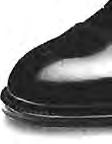
We pride ourselves in our product knowledge and p ro fessional ap p roach to the men's fo otwear ind u stry So when considering your
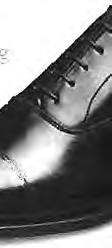


fo otwear apparel , think of McClo u d S h oes
McC l ouds offe r to the d iscerning mal e ex clu sive local manufacturers and world famous brand names t h at i nclude Grenson, Churc h, Lloyd, Lo ake, Sioux, R ockport and Salam a nder.
an equally moreish smoked fish platter, we asked for another round of soft drink for the children and "freshly squeezed orange juice" for a rather parched grandmother.
After we had done as much justice as we could to the entrees the still laden dishes were removed, but no drinks. The mains arrived and again no drinks. We grabbed another waiter going by and asked him to follow up the drinks. Twenty minutes had now passed! Still no drinks.
Like the entrees the mains were rich and grandchildren and grandmother alike were becoming rather desperate towards the end of their main course The matter was taken up with the maitre d' who promised to tend to it. After another lengthy delay the soft drink arrived. The waitress had gone before the orange juice could be enquired of. We then spied an orange juice waiting on the bar so I went and helped myself informing the maitre d' on the way back that 1 shouldn't have needed selfservice. I sat down and our waitress reappeared in a blazing mood: "That's not yours." "Why not?" I responded. It appeared to have been bottled rather than fresh and ours was still being squeezed (1 estimate that it took 15 minutes to squeeze each or a nge) . She was informed that we would hold onto the mass-produced orange juice until the handmade one materialised It eventually was brought with very bad grace . When the waitress was politely informed that it was "not good enough" that we had to wait so long and make so many enquiries we were subjected to a tirade of it not being her fault, us not understanding how the restaurant operated and a lot more. Even when we turned our back to her and in various other ways indicated that we did not wish to go on with listening to the tirade, she continued.
Ultimately, an approach was made to the maitre d' who was informed that we had not come





to be involved in protracted argument with a member of her staff. She referred it to the proprietress who promised to look into it and compensate us for the poor drink service. We weren't too worried about the latter provided the former was attended to.
The proprietress was true to her word. The waitress was replaced at our table by a charming waiter whom we had had before. He remained charming for the rest of the day. We were not quit of our waitress however - she kept passing by our table glaring at us to the extent that our children started to become a little concerned about our welfare. The drinks we had so long waited for were not charged to us nor were those they replaced .
Unlike Bergerac, Zampelli's were prepared to attend to an immediate rectification of an obvious problem I have to add that the problem we experienced that day at Zampelli's was quite out of character from our previous many visits there notwithstanding that it always appears to be extremely busy and the staff run off their feet.
One warning though! If you are of a mind to consume dessert, check out the cake and tart display before you order your earlier courses otherwise you will find yourself with the dilemma of choosing between trying to sque eze food into an overloaded system or passing up an excellent range of rich desserts.
In this particular case, the attention to our difficulties meant that the excellent (and very substantial) food was enjoyed by us and we proceeded to leave with pleasant memories rather than the nightmare of the night before.
Bergerac, 131 King Street, Melbourne 9629 2868 Zampelli's, 300 Toorak Road , South Yarra , 98272671
Graham Devries
A tradition built on personal service, expert advice and the understanding that Australia's most comprehensive range of tackle should also offer the best value.
Angler

From Geoffrey Cowen, The
Darrow: The Bribery Trial of America's Greatest Lawyer (1993), pp.283-6.
IN THE WINTER OF 1911-1912 , EARL
Rogers was at the height of his powers, already a criminal lawyer of national note, well on his way to becoming the legendary creator of courtroom antics, tactics, and drama that novelists would try to capture and criminal lawyers would try to imitate. His reputation had already begun to emerge as the larger-than-Iife prototype of a defense counsel whose matinee idol following is only enhanced by his remarkable combination of wit, charm, intemperance, and deviousness, and his wide range of friendships with journalists, detectives, barkeepers, and prostitutes.
Earl Rogers was a comet on the horizon of criminal law, a blazing figure whose brief but remarkable career left an image that still remains. He was born in upstate New York , the son of the Reverend Lowell Rogers, an evangelist who came west to teach the gospel and then was swept up in the Southern California real estate mania of the 1880s. Rogers learned music from his mother, became fluent in several languages, including Latin and Greek, and was attending college at Syracuse University when the collapse of his father's real estate venture in Riverside County forced him to drop out of school. Not yet twenty, Rogers worked briefly as a reporter, but when he started to cover the courthouse he quickly became convinced that there was far more money and fame to be made by trying cases than by reporting them.
In that era when lawyers could earn admission to the bar through apprenticeship rather than law school study, Rogers managed to charm his way into the employ of U.S senator Stephen M. White, widely regarded as "California's greatest lawyer and most brilliant statesman." By 1897, when Rogers was sworn into the bar and hung out his own shingle, some of the senator's magic had rubbed off: White's friends had become Rogers's
friends; White's skills had become Rogers's skills. Perhaps as important in the long run, Rogers soon came to imitate White's greatest weakness - his propensity for exceptionally hard drinking.
Starting with his first case, Rogers established a reputation as a winner - brilliant, resourceful, innovative, and prepared to test the outer boundaries of legal propriety The case began when "Doc" Crandall - better known as a pimp than as a veterinarian - was charged with murdering a client during a wild weekend party with two prostitutes. His case looked hopeless since Ruby Gaines, one of the prostitutes and an eyewitness to the murder, was scheduled to testify. But Crandall was acquitted when Ruby failed to appear in court. Though it couldn't be proved , the press was convinced that Rogers had arranged to have Ruby abducted and had fed her a steady diet of alcohol to keep her from the witness stand
His reputation continued to build during the months that followed, but it didn't reach full flower until two years later , when he took on an unpopular and apparently hopeless case that pitted him against the best lawyer in the city - his mentor, Stephen White As it happened, White was serving as a special prosecutor in the murder of Jay Hunter -a rich, handsome, and debonair attorney, the scion of Southern aristocrats , and a popular member of the city's plutocracy. Hunter had b ee n murdered in the hallway of his office building by an obscure mechanic and odd-jobman named William Alford Witne sse s had seen Alford with the murder weapon and had heard Hunter, in his dying breath, say that he had been killed in cold blood.
To other defense lawyers, the case looked airtight, but to Rogers it looked like a once-in-alifetime opportunity to display the tactical skills he had been developing. Rogers's excuse was selfdefense, the claim that Alford had been forced to shoot Hunter when the gentleman knocked him to the ground and began to beat him with his large walking stick. To diffuse the impact of the prosecution's damaging testimony, Rogers ridiculed it - causing laughter in the courtroom. He attacked and teased White's cocounsel, " General" Johnstone Jones, who was a bit too corpulent and pompous for the jury's taste; once - to the jury's
delight - he even jabbed his finger into the general's paunch when the prosecutor asked a witness to describe the exact location of "the anterior superior spinous process of the ilium ."
Rogers didn't have much evidence of his own, however, other th an the testimony of his client , who was sure to be tom to pieces on cross-examination by Senator White . Knowing his mentor's habits, Rogers had lunch with White one day during the trial , making sure that the se nator had so much to drink that he would , as was his custom on such occasions, take a brief nap before appearing in court. As soon as court began that afternoon, Rogers put Alford on the stand, out of tum, and raced through a recitation of how he had been knocked to the floor by Hunter and had used hi s gun in self-defense . After less than a half hour of questioning, Rogers turned the defendant over to the prosecution. Without White at his side , General Jones was left helpless. By the time the senator strolled into court that afternoon , Alford had left the witness stand, his testimony intact. White was furious, but there was nothing he could do.
Nor was White able to do anything but protest when Rogers , for corroboration, stunned the courtroom by producing a jar containing Hunter's bowels , which had been preserved in alcohol. Rogers had made himself an expert on human anatomy, so much so that he was able to tear apart
THE LOCATION IS A NOISY COFFEE PLACE frequented by members of the Victorian Bar. You know, the sort of place where the coffee tends to be weak and milky; the food overpriced and predictable ; and, the noise levels high Three reasonably experienced junior members of th e Bar are daintily sipping their cafJe lattes and nibbling a shared pastry . Having conducted the mandatory post mortem of the not so recently played Grand Final they move onto matters of greater import:
Kim: Things still a bit slow for you?
Tom: I never said they were ...
Tim: Me neither.
Kim: Well, patchy!
Tom: I wouldn't say that!
Tim: Oh that was yonks ago!
Tom: If anything, things have begun to improve.
Kim: Yeah, I think things are getting better.
the testimony of medical experts and was soon to become a lecturer at various medical colleges. Over White's strenuous protests, Rogers used a twenty-five-year-old physician named Dr. Edward Pallette to prove th at the bullet had been fired from below - a direction that could only be explained if, as Rogers claimed, Alford had been lying on the ground when the shots were fired . White made no effort to recall the autopsy surgeon to offer a rebuttal.
Still, since the prosecution was entitled to make the final statement to the jury, Rogers was worried that White would win his case with the force of hi s closing argument. So he bought a small, schoolhouse blackboard, brought the blackboard into the courtroom , set it on an easel, and implored the jur y to keep looking at it while White presents hi s "spellbinding oratory." Then he wrote a single, blief question on the blackboard :
The Special Prosecutor did not recall Autopsy Surgeon Khurtz to the stand on rebuttal. Was this because he knew Dr. Khurtz agreed that the evidence of the d ead man' s own intestines and the testimony of Dr. Pallette proved befor e your own eyes that the bullet tra ve lled UP from the floor, not DOWN?
To the astonishment and delight of the press , and most of the public, Alford was acquittedand a star was born
Tim: Well, you both obviously had great scope for improvement.
Tom: I wouldn't quite say that.
Kim: I wouldn't either.
Tim: I suppose you are back to the halcyon days of three or four years ago?
Tom: I am still writing the same as I did then.
Tim: So the boom never hit you then?
Kim: What boom ?
Tim: Everyone knows that the Bar peaked in '92 and '93 and then the bottom fell out for almost everyone.
Kim: Not me.
Tom: Not me either.
Tim: Well, if you don't have any rises I suppose you can't experience any falls.
Kim: A bit like a souffle never rising twice.
Tim: Or in the case of your s, never rising once.
Tom: WeIll am keeping busy.
Tim: Have you got the Age cyptic done already have you?
Tom: If you must know, I just ploughed through a heap of paperwork - my secretary will have to work through the night to catch up.
Kim: I've got so much I don't know where to begin.
Tim: Ever thought of starting at the beginning and just working your way through?
Tom: You really are bitter today.
Kim: Another argument with the missus ?
Tim: Whaddya mean bitter ?
Tom: Well you've hardly been the model of pleasantness today.
Kim: What's gotten to you .?
Tom: Your bank manager?
Kim: That credit manager from ABC Law Books ?
Tom: The Tax Department ?
Tim: Look , leave it alone I am fine. You're the ones with the problems.
Kim: Something's bugging you. Get if off your chest, you'll feel better.
Tom: If you can't tell us . . .
Tim: It's nothing really, it is nothing. R e ad my lips
1- T -I-S-N -O-N -E-O-F -Y -0- U -R-B-E-E-SW-A-X!
Tom: Come on get it out of your system.
Kim: A shared burden and all that ...
Tim: It really is nothing
Tom: If it is enough to curdle your coffee it is significant.
Kim: For goodness sake tell us.
Tim: It is nothing. I am just tired of it all.
Tom: Tired of what?
Kim: Yeah what?
Tim: Just the boring, grind of it all.
Tom: That hasn't changed
Kim: Why is it getting to you now?
Tim: It's bloody ceasele ss that is what.
Tom: What's ceaseless ?
Tim: The whole bloody thing
Kim: Yeah but what's so irritating today ?
Tim: It's not just today. It's been going on for months.
Tom: What's been going on?
Tim: It is the same old thing
Kim: Go on, get it off your chest, you'll feel better
Tim: Bloody hell, I don't need a social worker on my back
Tom: Forget her, just tell us what's gone wrong
Tim: You ' re no better.
Kim: Don't get stuck into us. It isn't our fault whatever it is.
Tom: Whose fault is it? What is the matter?
Tim: Solicitors, listing clerks, legal aid, courts, you name it.
Kim: What about them?
Tim: I am just tired of it all. It never bloody ends .
Kim: Yeah but what never ends?
Tim: For a start I am sick of being in the bloody Reserve Lists. It doesn't matter whether you're first, third or ninth or whether you are back for the second or third time you just don ' t get on
Tom: That's nothing new.
Tim: I reckon it's worse than ever. I reckon they're listing more matters just to make their statistics look better. And then the lists get clogged up with juries. I'm just sick of it.
Tom: But that's always been the case
Tim: It's worse. You spend hours getting a matter ready to start, days at times, and then you discover the night before that somehow you've gone from being first for the day to last in the Reserves List
Kim: I don't think it matters where in the Reserves List you are ...
Tim: and being given "priority" for the next time is just a joke
Tom: Yeah well . ..
Tim: I had one matter which came back five times, interstate witnesses and all. The parties gave it up as a bad joke and settled it between themselves.
Kim: Well you got paid anyway
Tim: Pig's I did! The bloody client told the solicitor he wasn't going to pay when he did all the work and she said as I had a week's warning that was that!
Tom: That has happened to all of us!
Tim: But it goes on and on and bloody on.
Kim: It has happened to me too. Why only last . ..
Tim: The final straw was when the same solicitor cancelled today ' s matter.
Tom: I thought you didn't want to do it anyway .
Tim: That's not the point is it?
Kim: Yeah but ...
Tim: She didn't even have the guts to tell m e direct. She rang the clerk.
Tom: You had the brief ...
Tim: That's the point , she always delivers the brief late. She had me booked weeks in advance. And then the day before, she rings the clerk and says: "Oh I don't expect a fee slip eith er" . She's got priors too
Tom: Don ' t take any work from her then ...
Tim: That's what my clerk says but
Kim: But what?
Tim: She still gives me work from time to time.
Tom: I suppose she is a good payer ?
Tim: You'd hav e to be kidding!
Tom: Why .. .
Tim: Every fee is haggled down.
Kim: You don't work below scale do you?
Tim: She's tried that but thankfully only a couple oftimes.
Tom: So, what's wrong with scale? Hundreds are

working well below scale and then there's Legal Aid.
T im : Lega l Aid! That's something again! No the problem with Petra is that everything is marked • Urgent" and "Scale'. he does not give YOll half the instructions you need and he expects YOll to redo the work on the ba i of complete instruction for nix.
Kim: Is that all?

T im : I cou ld go on for ever. For in tance , it takes for ever to get paid even if he ha silting in trust. Then , if she has been left high and dry by a client she expect YOll to wear your fees. And if you start to a k after fee you get thi badtempered response if you attacked very integrity.





Tom: She's not the only one like that I could tell
Tim: That's exactly it. She I have got used to. But it's all the others.
Kim: Tom, you tell him about the matter I was almost briefed in.
Tim: You were going to do a matter for Tom!
Kim: No not exactly.
Tim: Against him!
Tom: Yes. She was briefed to oppose an S F.J. on my fees.
Tim: You've been caught over-charging again?
Tom: No!
Tim: You marked for a late adjournment
Tom: No
Tim: Ah. You marked for a matter which settled?
Tom: None of that. Actually the Solly's defence
Kim: They haven't got any defences. It's outrageous!
Tom: Yes, well, that may be. He was arguing that I hadn't been briefed in the matter.
Tim: Had you?
Tom: Of course! I was initially briefed to appear before Justice Irmington to get a matter briefed because their preferred Counsel was to be interstate that day.
Tim: Irmington would have had your . . . err ... he would have given you the most monstrous going over.
Kim: He would have said that there were hundreds of other equally competent Counsel desperate for work.
Tim: Why couldn't you do it? You've done that sort of thing before haven't you?
Tom: Worse still I was already in his list on an identical matter for the same Sollies .
Tim: So what was the problem?
Tom: It ran for three days, the Solly was there to instruct each day, I got a good result.
Tim: So what was the problem?
Tom: The Solly reckoned I wasn't briefed beyond the first day.
Tim: You have to be kidding! So what's happening?
Tom: It's on next week.
Kim: Who's doing it for you?
Tom: I thought I might do it myself if nothing else comes up.
Tim: A fool for a client eh?
Tom: You wanna do it?
Tim: Err I can't. Whadda 'bout Kim?
Tom: Yeah!
Kim: You know I can't. It'd be unethical.
Tom: What about Legal Aid. You were saying
Tim: Don't talk to me about legal Aid!
Tom: Alright I won't.
Tim: Ever tried to find out about when your fees are to be paid?
Kim: Yep.
Tim: It's like trying to get through to the child support agency. They never answer their phones, they never have the file and they tell you to put it in
writing Then they ignore your letters
Kim: Sue the buggers!
Tim: I did once and then they paid some of the fees and mounted all these arguments against the others.
Kim: Such as?
Tim: The brief wasn't aided.
Tom: Approval had only been given up to the pretrial.
Tim: It was the wrong court.
Tom: You quoted the wrong file reference .
Tim: Aid had been revoked.
Tom: Aid wasn't extended to adjournments or consent orders.
Tim: The brief fee was too high even if it was scale.
Kim: Why didn't you get your clerk to chase it up in the first place?
Tim: I did and he told me to write them a fully detailed letter.
Kim: Why didn't you?
Tim: I did and I heard nothing from them
(At that stage a mobile telephone goes off and they each scramble for their phone. It turns out to be someone at the next table.)
Tom: So that's all you've got to complain about?
Tim: Don't you start on me.
Kim: I really have to go. I've got a lot of work to do for tomorrow's brief.
Tim: Me too!
Tom: At least we've cheered you up.
Tim: Like bloody hell you have!
Kim: Must go.
Tom: You'll have to pay for the coffees Tim, I'm a little short today
Kim: I reckon it's your shout anyway.
(Readers may get a sense of deja vu out of the foregoing. If so , the moral is that life doesn't change but just grinds on inexorably.)
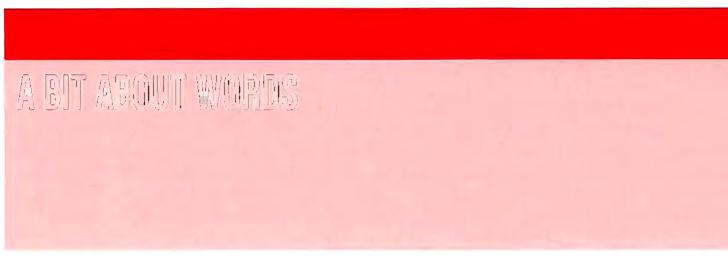
THE WORLD OF LANGUAGE IS LITTERED with durable solecisms which eventually come to be accepted in their "false" meaning through consistent use. In other columns I have discussed fulsome, ilk, helpmeet, syllabus and others, as words whose current meaning, once considered erroneous, is now entrenched.
The language of science is a steady source of words which suffer that fate. However , the process of derailing the true meaning of scientific words is usually swift . If the original meaning of ordinary words suffers the death of a thousand cuts, victims from the lexicon of science are put to the sword as soon as they appear in a popular newspaper. The reason is not hard to find: journalists like strange , evocative words to add rouge to the cheeks of indifferent writing; and the reading public does not, as a rule, understand more about science than survived reluctant Thursdays in the high school science laboratory.
Consider the fate of quantum leap in popular usage, it means "a sudden, very large change in amount, position or attitude". Its true meaning is almost the opposite. Quantur' mechanics was the creation - perhaps the ; overy is more accurate - of Max Planck. He announced his theory at a meeting of the German Physical Society in Berlin on 14 December 1900. He postulated that energy exists only in discrete packets (quanta) which were irreducible and indivisible. From that proposition he explained the wave-particle duality of electromagnetic waves, which had puzzled scientists for a long time : light and other forms of electro-magnetic energy exhibit properties associated with wave s, but also exhibit properties associated with particles How could such inconsistent properties coexist in electro-magnetic energy? Quantum mechanics provided the answer.
Planck postulated that electrons could only move in particular orbits, and might move from one orbit to another, but they could not move to a new orbit lying between the fixed orbits. To move between orbits involved receiving, or losing, a quantum of energy. The quantum was indivisible, hence the impossibility of intermediate orbits. The jump from one orbit to another was associated with

the gain or loss of a quantum of energy , so quantum jump It is the smallest change in position possible in the known universe or, for that matter, the unknown universe, given the overwhelming evidence that quantum mechanics accurately describes the physics of sub-atomic particles .
Quantum mechanics developed over the course of the next 30 years, baffling everyone Like most scientific revolutions, it caught the imagination of the press, and the quantumjump (soon the quantum leap) was picked up as a vogue expression. Perhaps because the theory itself was so revolutionary, and its effects so profound, its central concept quantum jump almost instantly came to be used as signifying a gig antic step.


In a very different way, the prefix cyber has belatedly been picked up by the Internet community, and is now loosely associated with the world of the Internet.
Cyber derives originally from the Greek kubernetos meaning steersman. In its first adoption into English , it appeared gubernate (1432), gubern (govern , 1520), gubernator (governor, ruler, 1522) and cognate expressions such as gubernacle, gubernacula, gubernance, and so on. In the U.S A. it is in common use as gubernatorial (U S.A. 1734), because the State governors are elected, and an adjective is needed to describe the elections.
Apart from the American usage, the word is confined to the dusty corners of language But in

1948, Norbert Wiener wrote a seminal work on communication theory and control systems, which he titled Cybernetics. At page 19 he said: "We have decided to call the entire field of control and communication theory, whether in the machine or in the animal, by the name Cybernetics" In its most popularly known manifestation, cybernetics is characterised by the use of information feed-back as an integral component of a control mechanism. Thus, the thermostat in an air-conditioning system detects the temperature of the room and feeds that information back to the heating unit; the heating unit produces more or less heat; the temperature changes; the thermostat detects the change in temperature and feeds the information back to the heating unit; and so the feed-back loop continues. That is cybernetics in action.

For reasons which are entirely obscure, people who spend a lot of time surfing the Internet are now called cybernauts, the virtual space they create and populate is called cyberspace, anyone with a regulatory role or minatory attitude on the Net is likely to be referred to as cybercop, the collection of text information on the Net is cyberlibrary, the fact that pornographic material is to be found in the cyberlibrary has coined the use cybersex, good Web graphics are cyberart. In short, if you want to sound like an old hand on the Internet, just add cyber- to any word which is capable of taking a prefix.
The unifying sense in which the prefix is used is "of or pertaining to the Internet". It is difficult to see how the usage arose. There is no apparent connection between cybernetics and the Internet: on the contrary, the Internet is the largest uncontrolled information system the world has ever seen.
And finally, a parting shot. It is not really erroneous, since its literal meaning is accurately caught in its common usage. It has been in use in one form or another since the 16th century:
1592 GREENE Upst. Courtier Wks . (Grosart) xi . 219, Thus much I must say for a parting blow.
1611 SHAKES Cymb. i. iii. 34, Ere I could Giue him that parting kisse.
1646 CRASHA W Steps to Temple 77, Hark! She is call'd, the parting hour is come .
1779 SHERIDAN Critic ii. ii, If you go out without the parting look you might as well dance out.
1794 SOUTHEY Frederic 6, That deep cry seems to sound My parting knell.
1876 JOWETT Plato (ed 2) 1. 266, This seems to be indicated by his parting words.
1894 HALL CAINE Manxman 75, With this parting shot Nancy flung into the house
But it derives from an earlier, metaphorical expression and has replaced it because of their phonological similarity. The original expression is Parthian shot By about 170 B.C. their region was independent of the Seleucid kingdom. In 55 B.C. the ineffectual Roman general Crassus was defeated by the Parthians, who used to great effect the Parthian shot. The Parthian horsemen would ride towards their enemy and let fly a volley of arrows, then turn in retreat. Thinking the Parthians' resources exhausted, the Romans would follow the retreating horsemen. But, great horsemen that they were, the Parthians would rise in their saddles and, turning , fire another volley into the unsuspecting Romans. Thus the devastating final shot in apparent or actual retreat became known as the Parthian shot. Here lies the subtle distinction between the two expressions: a parting shot is one necessarily associated with departure; a Parthian shot may be the purpose of a feigned withdrawal.
"'Poison,' said Sherlock Holmes curtly, and strode off. 'One other thing, Lestrade,' he added, turning round at the door: 'Rache is the German for r evenge, so don't lose your time looking for Miss Rachel.' With which Parthian shot he walked away, leaving the two rivals open mouthed behind him" (Conan Doyle, A Study in Scarlet).
Tom Stoppard caught something of the original, while using the modern variation: "He smiles briefly at them without mirth, and starts to back out, his parting shot rising again" (Rosencrantz & Guildenstern are Dead, ii, 57)
J.W.K. Burnside
Certified 100% silk . Highest quality craftsmanship. Exquisite Cashan design.
One 4' x 6', rust , black, blues; one 3' x 5', silver , blues, brown, pale pink .
Professionally valued at $5,200 and $4,000. Selling for $3,900 and $2,700 neg.
Phone Inga D'Arcy on 934 72108 for viewing in your home.
This quality of silk carpet is usually unavailable locally.

BARRISTERS: ENGLAND IS NOT THE ONLY country where the legal profession is overdone Hungary swanns with barristers.' It is the ambition of the Hungarian peasant to make one of his sons an advocate, as it is the ambition of the Breton and the Irish peasant to make one so n a priest. It is related of the son of a small farmer near Pesth, who was sent to the law school of that town , but who, either from the want of parts or application was plucked in the qualifying examination , that not daring to re t urn home empty-handed after all the money that had been spent upon his education, he forged a legal diploma. The father was not, however, so ignorant as not to be aware that such diplomas are always written on dogskin parchment in Hungary. "Why is your certificate not made out on dogskin?" asked the old man. "The fact is," replied the youth, "there are more barristers than dog s in Hungary, and so there is not enough dogskin to make diplomas for all of us ."
Willock, Legal Facetiae (1887) 419
It has been a vintage year for frauds and assorted con artists. We recently saw the jailing of a young woman who passed herself off as a successful barrister after attending lectures and tutorials at the University of Melbourne Law School. The accoutrements of fraud included commissioned fake degrees and a practising certificate from the Victorian Law Institute All we at Bar News know is just what we read in the newspapers and given the emphasis by the papers on the young woman attending lectures, tutorials and faculty social functions without being enrolled in the law faculty we make the observation, having gained our legal education at the other place, that if enrolment at Melbourne is anywhere near as horrendous as it is at Monash, who can blame her for skipping enrolment? We make the further observation that her fraud/fantasy was bound to come unstuck when she sought to clothe herself as a "successful barrister" What a giveaway! As is commonly recognised these days, successful barristers are
*Rese arch assist an ce by Bar nerd de Shonk is gratefully acknowledged by the authors.
1. We understand that these d ays Victoria swarms with hungry barristers.
about as rare as sincere politicians, truthful usedcar salesmen, honest real estate agents or even modest foreign ministers.2
At the time of writing, a one-time lecturer at RMIT and the Police Academy is awaiting sentence after being found guilty of perjury in the County Court on the basis that his claimed law degree from London University is but a figment of his imagination. We note that the lunchtime Essoign Club wags - they are a droll lot - are arguing and laying wagers over who was being referred to in the Australian's headline : "Bogus lawyer in court" 3
Notwithstanding the spate of lawyer jokesyou've heard the one about the kid in grade school who told his class (and his teacher) that his dad played piano in a whorehouse because his dad had been too ashamed to tell his own son that he was a lawyer - there seems no shortage of non-lawyers desiring to pass themselves off as lawyers . The latest to come to light is Steven Welchons, who for two years held down the position of deputy public defender in Wampsville, N.Y. State, and represented over 1,400 defendants of which, so far at least, I 00 are seeking a retrial of their cases. 4
In an effort to dislodge some pesky joumos in hot pursuit , the award-winning writer Helen whatsername claimed to be a lawyer with wide courtroom experience and quite capable of assessing the weight of evidence . 5
This year saw the publication of Michael Crick's unauthorised biograph y 6 of Lord Archer of
2. The Age (29 July 1995) 3; The H erald Sun (28, 29 July 1995) 1.
3. Hawes (16 August 1995) 4; qv Oldfield , "Lecturer accused of perjury", The Age (16 August 1995) 7; "Fake lawyer found guilty", The Age (31 August 1995) 4.
4 . Curriden, " Impostor Lawyer Fools Many", ABA Journal 14 (September 1995).
5. Scott and Fagan, "Demidenko d efiant in face of furore ", The Australian (22 August 1995) I.
6. Jeffrey Archer: Stran ge r Than Fiction, reviewed by Davie, " Underneath the Archer" , The Age Saturday Extra (8 July 1995) 7 and Hawker, "Why Archer might have been off-target", The Sunday Age (6 August 1995) Agenda 8.

Weston-Super-Mare,? better known as Jeffrey Archer, reputedly the highest-paid author in the world. Crick documents the discrepancies between reality and the myth and misstatements (mostly of Lord Archer's own making) regarding the antecedents and biographical detail of his life concluding that Lord Archer's "own life is a more compelling story than his own fiction".
We hope that none of our readers were tempted to purchase a computer on a "pay now, wait for delivery" basis from Osborne Computers which has gone belly-up leaving such trusting consumers in limbo. A check by Computer Age on the company returns lodged by Osborne Computers for 1992/93 and 1993 /9 4 revealed apparent discrepancies in the details provided by Osborne's M.D. John Linton. In the documents lodged with the ASC, Linton lays claim to a B.Ec. (Hans) from Sydney University and a BA from the University of Melbourne. Neither institution has records of a John Linton with these degrees and when Computer Age attempted to contact Mr. Linton they were unsuccessful. 8
Almost forgotten in the recent brouhaha concerning the judiciary in Vanuatu is that Charles Adolphus Vaudin, a British barrister en route to the position of Vanuatu's Chief Justice alighted from the plane in the previously joint French/British colony of New Hebtides as Chief Justice Charles Adolphus Vaudin d'Imecourt, a name almost certain to gain the confidence of the ruling francophone population and get up the noses ofthe Anglophile Opposition. Whether the name change was brought about by traversing the Equator or the International Date Line or both we are unable to say.9
L as t year, in a remarkable week for autohagiography, the publication of Bob Hawke's M emo irs was topped by a columnist (who each week interviews a mover and shaker in our society), interviewing himself. 10
The present professor of poetry at Oxford is James Fenton. In 19 94 Fenton told an interviewer that he had made two key contributions to his campaign for the Oxford preferment (elected by the Convocation of graduates). Fenton had failed in 198 4, did not stand in 1989 and in 1994 was determined to win. One of the key contributions was to plan a party, in his garden, to be held on the second
7. What a gobstopper that is! - it sure beats BrieflessCuesey.
8. Cookes, "Queries on records" (4 July 1995) 29.
9. O'Callaghan, "Judging the Judges", The Australian (6 Jul y 1995) 15 .
10 "Driving each other crazy " , The Sunday Age (21 August 1994) Agenda 4.
(and final) day of voting. ("Of course it was a voterigging exercise", Fenton says. "You think I don't know how to vote-rig?") The other was to allow himself to be interviewed in the Tim es. The interview included this vote-winning exchange:
Q: [The Australian poet] Les Murray, who I suppose is your main rival, told another paper that he had heard that the duties of the professor of poetry were not particularly onerous. Is that your impression?
A: I saw that article I have to say that it made me think that Les Murray had been very badly advised First of all, it seems insulting to imply that the job you are standing for is a doddle. Secondly, it is very much in my mind that the task of writing fifteen worthwhile lectures on poetry is not to be taken lightly
It is important to know that the questions as well as the answers were Fenton 's The Times was somehow persuaded to allow Fenton, quite openly, to interview himself. This was a "filthy trick" , Fenton says merrily He is capable of making the display of avidity seem endearing. I I
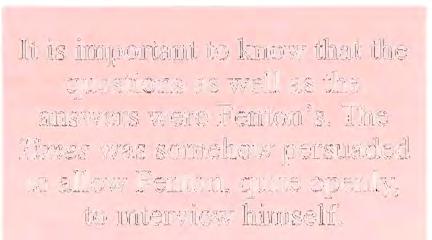
A recent advertisement in the Weekend Australian advertises for sale: 12 NOBLE TITLE/KNIGHTHOOD (Religious Order)
Unfortunately, further information can only be obtained by sending $25 to an address in Leichhardt N .S.W. For the $25 we receive (in addition to the comprehensive report containing the history and price of the honour) a sample issue of The Distinguished Gentleman (an entrepreneur's journal) It's just too bad that those two glasses of Essoign house red last Thursday completely blew the whole of this year's Bar News budget for investigative expenses, otherwise we'd provide our thirsty readers with the good oil on thi s superb investment. Us - we'd prefer to put the $25 towards
I I. Parker, "Auden's heir", The New Yorker (25 July 1994) 62 at 64. 12. (25 March 1995) 15
one of the guaranteed turf investment systems advertised in the old Truth.
Recently at the Southwark Crown Court two entrepreneurs, Stefanos Kollakis and Martin Lewis, received non-custodial sentences after pleading guilty to flogging off royal titles to gullible Americans. Victims included New York attorney Jeffrey Schnepper who "purchased" the title of Lord of Bradley and the Moors believing it entitled him to share a carriage with Queen Elizabeth II in the Queen Mother's birthday celebration procession. The scam was well organised with the defendants creating the Institute of Heraldic Affairs, a firm of solicitors, and the National Office of Heraldry to reassure wary "investors".13 We offer the suggestion that the two miscreants escaped gaol because the sentencing judge was persuaded that ripping off credulous American lawyers was a "victimless crime".

The Age has reported on unqualified pilots gaining by bribing their flying instructors. 4
In Victoria we hav e recently seen the resignation from the Aboriginal and Torres Strait Islander Commission of a commissioner whose "Aboriginality " was disputed by Victorian Aborigines. The resignation forestalled continued investigation but not before his sister declared he had no more Aboriginal blood in his veins than she did and she had none .
This year's Anzac Day parade in Gulgong N.S.W. was led by the highly decorated Brigadier Gilbert Richard Barrow. In answer to a parliamentary question, the Defence Science s and Personnel Minister Gary Punch said that Mr. Barrow was
13 Kennedy, " Pair face court over royal title swindle", The Weekend Australian (29-30 April 19 95) 14 .
14 Ewi ng, "Flying instructor jailed for selling ex ams he filled in" (19 April 1995) 7.
"not entitled to wear any medals and has never served with the regular army ... "15
U S. Marine Corps Captain and Judge Advocate Jeffrey Zander was exposed when it was learned that he had awarded himself numerous medals for bravery including the French Croix de Guerre and overcome the problem of Bar admis ion by adopting another lawyer' li fornian Bar Admission (Zander ha s graduated as a Iawyer but nol passed the Bar admi ion nece . ary to practi e).16




Notwithstanding the ALP affimlative action policy, the second-placed ALP Queensland Senate ticket candidate Jeff Slowgrove withdrew following admissions that he had three drink-driving offences again t hi name and that he neither possessed a B A degree nor had he graduated from the University of New South Wales as the party had been led to believe. We are of the view that neither of these "problems" is a bar to political representation and indeed, feel that the combination of both is unbeatable Should there be any doubt that the would-be candidate is eminently suited to represent the good folk of Queensland we offer the following from the torrid questioning of Mr. Slowgrove by journalists following his withdrawal from the Senate ticket:
Yes, I do have one daughter.
No , I am not married.
But no, s he is certainly not illegitimate. She is legitimately mine and I love her.
Yes, I guess I have to say that I'm not a perfect person. 17






In 1991 Forbes magazine slapped Bruce McN all, owner of the L.A. Kings hockey te am, movie producer, chairman of the National Hockey League and one of L.A.'s top power brokers, on the wrist for garnishing his resume with bogus graduate work at Oxford U niv ers ity and fictitiou p ast partnership with Howard Hughe and 1 Paul Getty. Upon being queried he admitted, No questi o n, I do e mbelli h no question" bobbin g his flashing heepi s h gri


One of the persons behind the discredited BCCI bank was Sheikh Gaith Rashad Pharaon who insisted on being called "Doctor" Pharaon His detractors noted that while others m ay give you the title of "sheih", you take it reluctantly, you don't assume it yourself. His aides pointed out discreetly that their boss had a Ph .D. from the Harvard Business School - a not very subtle reminder that the
15. 199 HR Debates, 37th Parliament , I s t Session, 6th Period (31 Janu ary 19 95) 157; Kennedy, "A bogus brigadier", The Herald Sun (15 May 1995) 3.
16 Cap lan, "T he Jagged Edge", 81 A BA Journal 52 (Marc h 199 5).
17 Meade and Harris, "Senate candidate quits over drinkdriving", Th e Australian (30 March 1995) 3 .
18. Burrough, "Raider of the Lost Art", 57(4) Vanity Fair 34 at 36 (Aplil 1994)
only other well-known Saudi businessman Adnam Khashoggi was a college dropout. In fact, Pharaon's Harvard degree was an MBA, but few people bothered to check. Former associates explain that Pharaon favoured the title "Doctor" because it was used by men like Henry Kissinger and Armand Hammer , although they , of course, had earned their degrees. 19
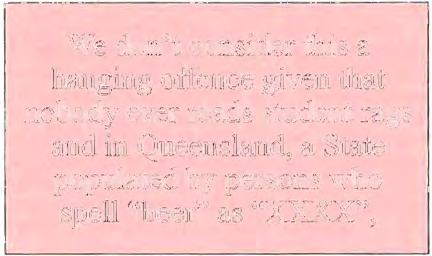
During the trial of William Remington in the heat of 1950 s McCarthyism in America the federal prosecutor Irving Saypol cross-examined a defence witness regarding his decision to "anglicise" his name from Rothenburg to Redmont. Remington's appeal was upheld on other grounds and thus the Court of Appeals criticism of the cross-examination is only obiter dicta 20 What the trial jury was unaware of was that the prosecutor conducting this cross-examination came into this world as Ike Sapolsky.
Adoption of a new moniker does have advantages. The donor of the Delacorte Fountain in New York's City Hall Park, whose family had emigrated from Russia, contributed two other fountains to the city, as well as the Alice in Wonderland statue, the clock with the dancing animals, and the Delacorte Theatre, all in Central Park. Once when he was asked why he had changed his name to one ending in "Jr.", he explained , "When your name is George T. Delacorte Jr., no one asks what your name was before it was George T Delacorte Jr.".21
Carl Laemmle is said to have created the first "name" actor when he planted a story in the St
19 Truell and Gurwin , False Profits: The Insid e StOlY of BeC!. the World's Most Corrupt Finan c ial Empire (1992) 37; Beaty and Gwynne, Th e Outlaw Bank: A Wild Ride into the Secret Heart of BCCI (1993) 54 and 171 - 3 20. US v Remington, 191 F 2d 246 at 252 (1951) per Swan CJ, Augustus Hand and Leamed Hand, Circuit Judges. 21 'The Talk of the Town" column, The New Yorker (20 - 27 February 1995) 86. 66
Louis Post-Dispatch that Florence Lawrence, previously known only as "the Biograph Girl", had been killed by a trolley car, and the next day took out an ad in the trade publications denouncing his own plant as a vicious lie 22
U.S. professional basketball player Charles Barkley published his autobiography Outrageous and then charged that he had been misquoted in his own book. 23
American author and alumnus of the Citadel (and supporter of Shannon Faulkner's fight to enter the males-only State Military College) Pat Conroy describes his introduction to publishing at age 24 as a public school teacher in South Carolina:
I will tell you of the first book I published It was called The Boo, and it was about a guy named Colonel Courvoisie at the Citadel who was nice to me as a boy. I took the finished manuscript to him and he looked at me and said "Bubba, you're an English major. How do we go about getting this book published?" I said , "Colonel, I have no idea." Puffing on his cigar, he said, " Let's have a look in the Yellow Pages." Under "Printing" I found an ad for the Albion Printing Press - business cards , invitations, books So I went to see them and said, "I wrote this book. I ' d like to get it published." They said, "That'd be fine. For $2,000 we' ll give you 500 copies." Then I went and got a loan from the Bank of Beaufort, and I published the book. I would have published my next book , The Wat er is Wid e, the same way, but someone su ggested I call the agent Julian Bach in New York, and I did, and he took me on Then one day Julian called to tell me Houghton Mifflin wanted to publish the book He said, "Here's the great news, Pat. Seventy-five hundred dollars!" And I said , "Julian , I don't think I can raise that much money ."'·
Among the multitude of sins being attributed to the award-winning writer Helen whatsername is lifting a Patrick Cook satire from the Bulletin and having it published as hers in the Queensland University student paper Semper Floreat. We don't consider this a hanging offence given that nobody ever reads student rags and in Queensland, a State populated by persons who spell "beer" as "XXXX", we doubt many are able to or desire to read the Bulletin 25
22 Goldberg, The Pow e r of Phot ography : How Pho(ographs Changed Our Liv es (1991) I 17
23 Deford, "B arkley 's Last Shot", 58(2 ) Vanity Fair 102 at 105 (February 1995)
24 , Berendt , "T he Conroy Saga" , 58(7) Vanity Fair 100 at 105 (July 1995) ,
25 Scott and Fagan, "Demidenko defiant in face of furore" , The Austra lian (22 August 1995) I
The French sculptor Jacques Lipchitz liked the food Gertrude Stein served at her receptions. He also enjoyed her self-regard; she asked him: "Jacques, of course you don't know too much about English literature, but besides Shakespeare and me, who do you think there is?"
When growing up in Los Angeles as the son of the West Coast comptroller for Columbia Pictures, Tony Blankley was a gifted violinist and, he says, a mediocre child actor. In the 1956 boxing movie The Harder they Fall, Blankley played oppositewell, in the vicinity of, at least - Humphrey Bogart. Bogart was dying of cancer at the time, and Blankley likes to tell people, with mock pomposity, "Bogie and I made our last picture together.,,26
Two years ago, when asked to nominate a "Book of the Year" for the Daily Telegraph, English author Jeanette Winterson chose her own fifth novel, Written on the Body. In March 1994 when the Sunday Times asked her to select her favourite author, Ms. Winterson chose herself saying, "No one working in the English language now comes close to my exuberance, my passion, my fidelity towards the language".n
Discredited Wall Street inside trader Ivan Boesky constantly tried to burnish his resume and family connections in conversations with New York colleagues. He often implied that he had graduated from Cranbrook, a prestigious prep school outside of his native Detroit (he attended for two years though he didn't graduate), and the University of Michigan (again, he was enrolled but did not graduate). Others assumed he had attended Harvard, since Boesky made so much of his Harvard Club membership. Boesky graduated after five years (twice dropping out) at the Detroit College of Law, a low-prestige law school that didn't require a college degree for admission. Every law firm he applied to turned him down and his father made him a partner in the Brass Rails -a chain of bars which had introduced topless dancing and strip shows to boost profits and which, according to critics, had hastened the decline of their neighborhoods. 28
Boesky was enormously proud of his Harvard affiliation - it offered the establishment respectability he craved. The club is independent of the university although membership is restricted to Harvard graduates, faculty members and facultylevel appointees. Boesky gained admission through the most arcane route imaginable: he donated heavily to Harvard's least-known graduate school, the School of Public Health, and had been
26 The New Yorker (9 January 1995) 24.
27. Rocco, "Winlerson's Discontent", 58(2) Vanity Fair 98 at 100 (February 1995).
28 . Stewart, Den a/Thieves (1991) 40-42.
named to the school's board of overseers, a "faculty-level" appointment. Boesky bought his way into the Harvard Club. 29
With apologies to those readers who have OD'ed on the OJ. trial in California, we note from the Age 30 that the pioneering U.S. psychologist and leading expert on battered women, Dr. Lenore Walker, will be testifying at the trial. What has got the womynists' knickers in a knot is that she will testify for the "wrong" side - the defence. What should enrage lawyers, logicians and philosophers is the basis of Dr. Walker's testimony: wife beaters are not necessarily wife murderers. To be paid an estimated $50,000 for stating the obvious would seem to be a nice little earner. Having got the women's movement offside, the more militant feminists are carefully releasing discreditable facts regarding the turncoat's background. Presumably these facts were less important before her treachery and selling out to the 0.1. defence. While her C.V. lists herself as holding a post at the University of Denver's School of Professional Psychology, that school's dean has no knowledge of any affiliation with her.
While we are unable to report further on the importuning of the International Parliament for Safety and Peace, Honorary Doctorates Department, we are able to relate the most recent missive from Jocelyn Timothy of the International Biographical Centre announcing the publication later this year of the third edition of International Leaders in Achievement. They have already allocated space for our biography and photograph to provide "permanent recognition not only [of our] various achievements but also to [our] personal philosophy of life, which will act as a stimulus for others". While there are no glaring exceptional spelling errors in the latest letter, we can only wonder whether her use of "embellishments" is a telling Freudian slip. There is a specially commissioned Certificate of Authenticity to celebrate our gullibility in coughing up US$190 (Standard edition), $295 (Luxury edition) or $595 for the Royal edition. Given that this new edition will list the "thousands of [our] fellow achievers", we hope that not all of them will order the Royal edition which is "limited to 100 copies".
The standard edition is bound in cloth which does not square with the promise of fine quality leather made by Ms. Timothy in her letter. This standard edition is available to biographees, professional libraries and research institutions worldwide and comes with a personalised Certificate of Inclusion. This causes us to wonder just
29 Ibid 110.
30. Reed, "Women's anger on the boil as psychology takes a battering" (17 February 1995) 13.
who is nominated on the personalised Certificate when the purchaser is, say, a professional library? Who is it that gets to have their name embossed (in gold) on the front cover?
The luxury edition is bound in elegant simulated leather, while the Royal edition is bound in real leather and supplied in a matching fleecelined slipcase together with traditional bookplate. This is debasing the language leather is leather just like pigs is pigs or is it possible the slipcase is lined with simulated fleece?
Lawrence Money's "Spy" column in the Sunday Age of February this year (we hesitate to list those members of the Bar who have featured in this column given the propensity of the Bar News editors to suffer from runny noses and worse at the mere whiff of a libel suit) reports this advertisement from the Far East Economic Review
British Lordship for quick sale at a price of £ 18,000 or nearest offer. Excellent lineage, well-respected title with no debts attached. Many documents included in the sale , many of which are dated 1688 to 1888. Allows you to legally use Lord in your name and can be held by any individual or race . The purchaser will be the eighth lord and the title is fully inheritable.
(We interpolate to recollect the 1960s footballing Lord twins playing for Geelong, and believe a representative of a newer generation is in the current lineup presumably these persons legally use Lord in their names! A further aside for those too impatient to await the C.1.'s nod or perhaps fear that the A.G. may abolish the rank of Queen's Counsel is the use of the double-barrelled surname the one-time British Labor M.P . (1974-86) and now BBC TV presenter and Times columnist Robert Kilroy-Silk may provide inspiration. We are of the view that Briefless-Jay rolls smoothly off the tongue better stili, how about Briefless-Seajay?)
In a later "Spy" snippet, Money asserts that enquiries have been received from some curious would-be peers. He coyly neglects to inform us whether these include the "Doctor" who ceased describing himself as such only after receiving discreet (and wise) Bar Council advice and was saved only by the editors' fear of defamation litigation from being included in the original article. 3l
The pages of Bar News - an august journal of record are perhaps not the proper place to discuss Miss Kylie Minogue's Gossard "Wonderbra" two journalists (Lisa Cooke and Joal Ryan and we sure as hell hope that the secondnamed is female, but then again, they both hail from California who knows?) actually tested this device and concluded that the agony out31. 89 Victorian Bar News 85 (Winter, 1994)

weighs the ecstasy,32 This brings to mind the new BOD designer pouch bit
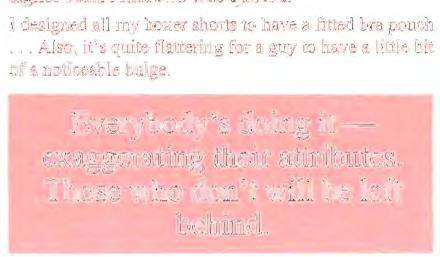
In fact, designer Andrews may well be able to enter into a joint venture with Los Angeles custom menswear designer Brian McKinney who seeks to address the problem of where the stylish male can park a mobile Ehone without spoiling the line of his designer duds 4 Is that a phone in your pocket or are you just glad to see me?
The idea of wearing your mobile phone inside a pair of John Andrews' boxer shorts may save money for Australia's medical health scheme Medicare. AAP reports 35 that Britain's National Health Service has added a new and novel procedure to its list of State-subsidised surgical operations: penis enlargement to ease the mind. While the NHS had previously only paid for the operation for men who had suffered accidents or infections, it has recently permitted two married men to become the first in Britain to claim the £3,000 operation on the NHS for psychological reasons. These men were suffering from "Locker room syndrome" and were unable to undress in front of other men for fear of being laughed at.
Having gone this far we can relate how the now defunct Oz magazine credited Mick Jagger with introducing the male falsie to Australia although it was unsure whether the item was a Coke Tm bottle or a cucumber.
Everybody's doing it exaggerating their attributes. Those who don't will be left behind and because of the universally recognised exaggeration, all qualifications legitimate and otherwise will be devalued. Thus our recommendation is a paraphrase of Captain Yossarian's response to Major Major's question of what if everybody did it Then I'd certainly be a damned fool not to do it myself Wouldn't I?
32. " Stick that up your Wonderbra" , The Summer Age (2 January 1995) 3
33 . Huntingdon, "Pad the parcel", The Age Saturday Extra (25 February 1995) 14.
34. Roberts, "Calling all fashion victims", The Age Saturday Extra (15 Apri11995) 14
35 "A big breakthrough", The Age (6 June 1995) 10

GA THER AROUND ME MY DEARS WHILE I conclude the tale of the VicBees.
You will remember that when we first started taking about them I told you of their great big pink hive and the reproduction of the venerated leaders of times past that were proudly displayed in the bowels of that building . The reproductions are still there. Like the VicBees' attitudes to life issues they remain in black and white. Like some VicBees they have not moved forward in time. For some reason, unknown to me there are no reproductions of the last few venerated leaders. I do not think it is because they are, or have been, too shy to have their reproductions made and displayed for it is not in the nature of VicBees, and especiaIIy the more prominent among them , to be so refining.
You will remember how I told you about the trend started by the neighbours of the VicBees to adorn their buildings with rusty bits of metal, chipped and split bits of wood and tom plastic webbing. I told you how the trend spread far and wide and it was a trend that stuck around for a long time - again the VicBees ' neighbours suffered a great sense of loss and emptiness when they discovered they no longer had all that paraphernalia to fly through. Well they have become trend leaders again for the metal and the wood and plastic have now also come down from all the other hives I told you about.
You will remember me telling you about the attempts of the VicGovBees to do away with VicBees. Unlike the VicBees, the VicGovBees have gone about their task in fairly subtle and measured ways. They are not saying that there will be no VicBees any more. They are saying that there can be VicBees but they have to comply with all sorts of rules that will mean that those things that set VicBees apart will no longer be allowed to continue. ClerkerBees are to go. Sollybees will no longer have to pay VicBees to forage in the fields for their customers. Rather VicBees will have to get their honey directly from the owners of the fields. Unfortunately, a significant number of such bees think it should be optional whether they pay for the services of those that work for them. As well , VicBees couldn't organise themselves to
properly collect their honey even if their lives depended upon it. Come to think of it, VicBees couldn't live without their regular and irregular supplies of honey Soon we will see VicBees flying in ever-decreasing circles as honey withdrawal symptoms overtake them!
VicBees wiII no longer be able to pick and choose who they go foraging with; how much they can charge for particular fields; and, where they may establish their hives.
You would think that these measures to eliminate VicBees, as we know them and as they have been known for years and years, ages and ages, would unite VicBees and would have them up in arms fighting on all fronts, using all of their many skills to stop this attack on their very existence . Well you are wrong - totally wrong! Not a buzz has been heard from them in opposition to these virulent attacks upon them. It would seem that they have laid down their feelers and are prepared to meekly accept the fate laid out for them. The longgone VicBees must be fairly twirling in their last resting places. Past traditions mean absolutely nothing.
In fact, there are many among the VicBees who positively support these measures. One wonders why they ever wanted to be VicBees in the first place if all they want to do is abolish the very things that make them what they are! The strangest thing is that in the main it is the newest VicBees wherein are found most of the supporters of the rules doing away with VicBees . One wonders what motivates them to abolish the livelihood they appeared to have chosen and worked so hard to get to Perhaps for many of them expectations have not been met and their reaction has been to pull down everything around them. Who knows? VicBees are indeed strange creatures from the newest to the oldest. That was what once made them lovable.
The strangest thing about VicBees at present is that instead of turning their attentions onto those from without who are attacking them they have chosen to fight among themselves about things which on a scale measured against their very existence ought seem most trivial. They are bitterly fighting among themselves over the question of
whether they should all put in a little honey to support those few who choose to have little VicBees . It appears that overall while little honey is at stake huge principles are. So huge, in fact, that attention has been drawn away from the main game - their very future!
They are also arguing about whether all the VicBees should be supporting the continuation of the watering hole that is not used by all VicBe e s. It is said by those who do not ever use the watering hole that they should not have to help keep it afloat whether or not it may serve a purpose over and above being a mere watering hole . Again it is a contest between high principle and small amounts of honey - fiddling while the home bums!
They are also arguing about a maga z ine put out by the VicBees - or rather a small group of VicBees - every few months It is said that the magazine is glo ssy and that is a bad thing. It is said that only a small group are involved in putting it out and that is a bad thing even though that small group works tirelessly to put out the magazine and would dearly love the help of many many more VicBees. It is much more fun to stand back and criticise what the magazine is than to pitch in and tum it into what it should be It is said by som e that they do not read it so no one should read it. Tho se very same people would be horrified at the con ce pt
of the introduction of thought police but still consider it appropriate to dictate that others should only read what they choose to read themselves. It is said to be irrelevant because it does not reflect the views of those who do not choose to write for it. It is said to be selective in what it publishes even though it has not ever been known to reject any material that is reasonably lucid and not defamatory . Of course, we cannot suggest that those who choose not to contribute their views are being selective in their own way . Those critics believe that any criticism of them is unfair, unreasonable, unjust and inequitable. The magazine is said by some to be unnecessary because it can be readily replaced by a more frequent, s maller, cheaper, straightforward record of coming and goings, even though it is believed that almost all VicBees read at least some parts of each glossy magazine as it comes out and all sort s of Bees from all sorts of walks of life go to great lengths to procure copies to devour to differing degrees. Some ofthose readers may even have some influence in the continued existence of VicBees but that, it seems, is hardly important. But of course that doesn't matter because VicBees for the last few days of their existence can save a bit of honey and in that way also go out with a whimper rather than a buzz.
Vale VicBees! Vale dear listeners.
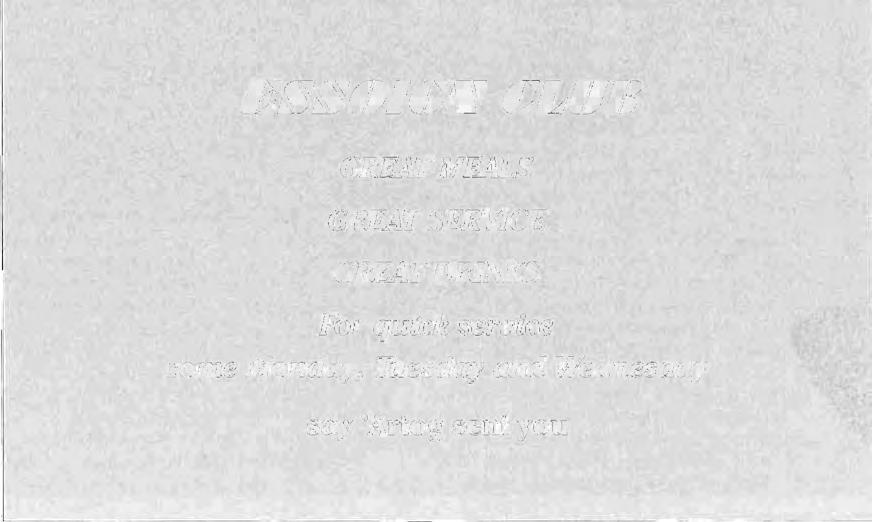

FOLLOWING YEARS OF REGULAR AND increasingly heavy defeat in the annual game against the Law Institute hockey team, the Bar this year turned the results of previous years on their head in a hard fought and (arguably) deserved victory by 3 goals to 2 at the State Hockey Centre on 27 October 1995.
The key to this dramatic turnaround was the recruitment of one of the Law Institute's stars, Stuart Wood, who very helpfully came to the Bar earlier this year and provided the team with some of the ingredients it had been missing so sorely in previous encounters, i.e. skill, youth, fitness, etc., etc.
The value of Wood's performance was plain in the annual practice match against RMIT where, unlike his increasingly geriatric team members, he ran prodigiously and played outstandingly as our best player in our 4-2 defeat.
Given that the loss of such a player from the Law Institute team and his accrual to our talents
meant that we had an outside chance of victory, every effort was made to ensure that the strongest possible team was available for the Law Institute game a week later.
Severe pressure was applied to Roger Young who came back for his first game in 18 months and Meryl Sexton, Phil Goldberg and Peter Collinson all likewise agreed to play.
On the night a new spirit of ruthlessness was brought to bear upon the fixture when the Bar Captain, Burchardt, objected to the solicitors' ring-in (non-solicitor) goalkeeper on the grounds of excess ability.
This objection, taken after a team vote on the matter, was a departure from prior form and was the key tactical move in the entire contest. The solicitors were forced in fact to play without a goalkeeper, a major and pleasing disadvantage.
Young's absence from the fray had not in any way diminished his capacity for ruthless and brutal
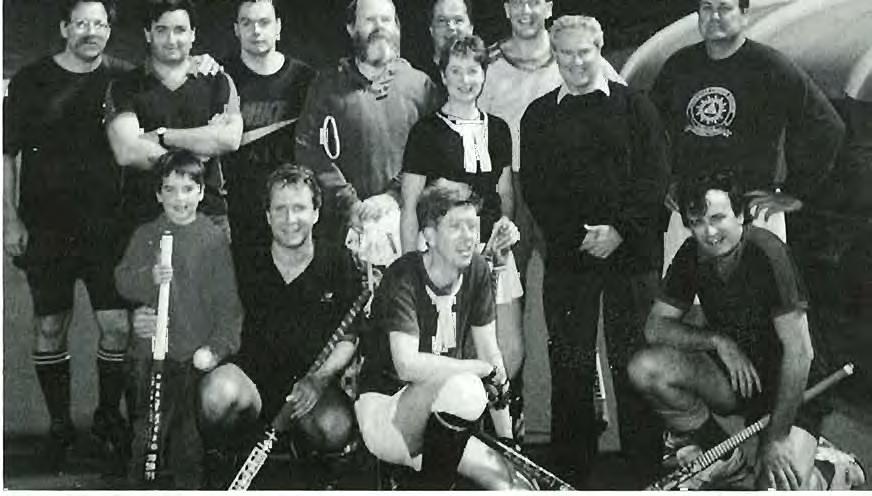
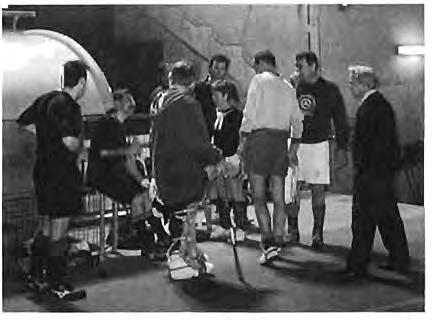
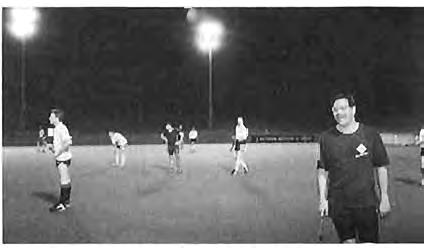
Goldberg, clearly not watching the game!
tackling at full back and, together with Peter Burke and Tom Lynch, the base of our defence was in good condition. The revitalised half line of Burchardt, Wood and Sexton benefited considerably from the mobility of Wood and the steadfast application of Meryl Sexton to marking her opponent.
With these advantages at the back, the fact that Collinson failed to tum up till half time, for reasons which were plainly associated with alcohol abuse, was not decisive.
A goal by Goldberg kept us at I-all at halftime (Goldberg missed one goal when he fell over in front of an open goal through exhaustion caused by lack of fitness - he will have to start rising and sitting on the Magistrates' Court bench more energetically to keep fitter).
In the second half Michael Tinney scored early, but the Law Institute equalised with alarming ease. Collinson then shrugged off the effects of whatever he'd been drinking previously and scored a third goal which gave us a slender advantage to which we clung, tenaciously or desperately depending upon one's extent of charity, until full time.
The solicitors' team was even younger than it was last year. Notwithstanding their lack of goalkeeper, it was a very good side, especially against
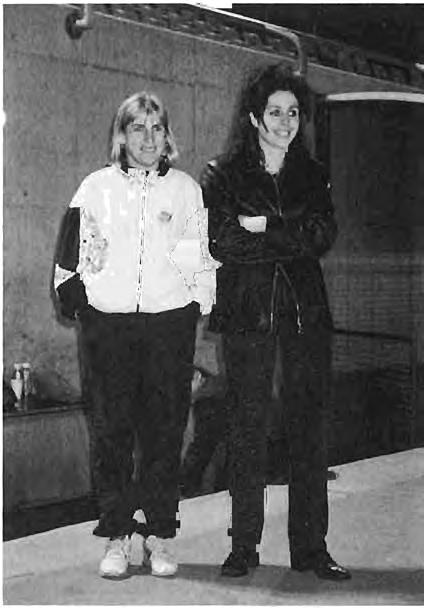
a team at least ten years per player older. This excess of age might perhaps have been even slightly greater had Coldrey J. been fit to play. His Honour attended, and vociferously supported , despite a recurrence of the foot injury that has kept him out of previous encounters.
The pattern of past successes has tended to be one of the odd victory in the first year of the accrual of some new star like Wood (one thinks back to Michael Tinney's arrival in 1989) and we will have to consider further recruitment to avoid being swamped by the youthfulness of our opponents.
The team that participated in this doubtless long to be remembered (at least by those involved) victory were Lynch, R. Young, Burke, Burchardt, S Wood, Sexton, Brear, A. Tinney, M. Tinney, Goldberg and Collinson. Our only regret was the absence through injury of Rupert Balfe, who would have enjoyed the result. Particular thanks are due to RMIT for providing us with an umpire and to Richard Brear for his organisation of the event and numerous memoranda .
The parties retired to Naughton's for the traditional post-match discussion of some subtler points in recent High Court decisions, and the debate was marked by the expected increase in fluency as fluid intake i"ncreased.
Philip Burchardt
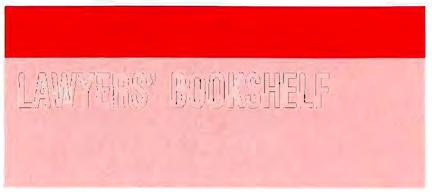
by Alan L. Tyree
Publisher: Butterworths, 1995 pages v-xxxiv, 1-469 Price: $79.00 (softcover).
A substantial number of new books have been released in the last two or three years concerning aspects of Australian banking law. Most of these publications have been specialist works or university texts, and as such might not have appealed to practitioners. This is not the case, however, with Alan Tyree's book, the second edition of which was recently released by Butterworths.
This work is a good conventional text concerning the key principles which govern banking law in Australia. As such, it should prove to be useful to many lawyers in a variety of situations.
Banking Law in Australia (2nd edn) is divided into 12 sections. The first, which is concerned with the structure of Australian banking, examines modem banking regulation in its historical context. The particular focus is on the role of the Reserve Bank of Australia.
Section 2 looks at the relationship between bankers and their customers. Included in this part is a discussion of what is referred to as "special customers". These include unincorporated associations, partnerships and companies.
Current accounts and bankers' duties are the themes of the next two sections.
Sections 5, 6 and 7 are devoted to cheques, with an examination of contractual and non-contractual relationships. The legal implications of misappropriated cheques are also analysed.
Section 8 focuses on the GIRO and EFT payment systems, as well as the clearing and settlement system.
Consumer banking, negotiable instruments and lending are the topics of sections 9, 10 and II.
The final section involves a very brief examination of international banking in the context of Mareva injunctions and documentary letters of credit.
Included in this second edition of Alan Tyree's work is quite a detailed legal analysis of the new Code of Banking Practice and the Australian Bank-
ing Industry Ombudsman. There is also much reference to Australian case law and legislation, in particular the Bills ofExchange Act 1909 (Cth) and the Cheques and Payment Orders Act 1986 (Cth).
It is a shame that this book is made to suffer somewhat from a rather superficial index, because otherwise Tyree's Banking Law in Australia is quite an impressive general text for practitioners.
Anna Ziaras
by John Glover
Published by Butterworths 1995 i-xxxi, 358 pages including index RRP $95.00
John Glover is a senior lecturer of law, Monash University He had been a practising member of the Victorian Bar having read in the chambers of A.1. Myers Q.c. before embarking on an academic career.
The book examines fiduciary relationships in three parts : firstly, Relationships of Trust; secondly , the Fiduciary Relation of Influence; and thirdly, Fiduciary Relations and Confidential Information.
In examining the Relationship of Trust, Glover discusses the theories that led to the development of the modem law. The author quotes from the decision of Frankfurter 1. in Securities and Exchange Commission v. Chenery Corporation 318 U.S . 80 (1943):
To say that a man is a fiduciary only begins the analysis; it gives direction to further enquiry. To whom is he a fiduciary? What obligations does he owe as a fiduciary? In what respect has he failed to discharge those obligations? And what of the consequences of his deviation from duty?
It is within that framework that the author has examined the Relationships of Trust.
In determining the existence of fiduciary relationship the author finds four characteristics: undertaking, entrusted property, reliance and power, and observes that there may be more as the law is not beyond expansion. Each of his characteristics is analysed in detail and he discusses for example, the relationships between managers and agents of syndicated loans, distributors and suppliers, brokers and client, business promoters and prospective investors and joint ventures. Included is an insightful analysis of the relevant cases in determining whether or not such a relationship exists.
Of particular importance to practitioners is the
author's discussion of the breach of fiduciary duty. He discusses the profit and conflict rules and embarks upon two case studies namely, that of the fiduciary duties of company directors and of solicitors. The latter involves the constant problem facing solicitors who represent clients on both sides of a transaction. A s the author correctly states, what often highlights such a conflict will be the protection of confidential information and the difficulty of ensuring that confidential information is not used to assist the other client. His discussion on breach of duty includes defences to fiduciary claim which include consent, ratification, and account and exclusion clauses. A separate chapter considers the remedies against third parties.
In a separate chapter Glover analyses the remedies against fiduciaries such as injunctions, constructive trusts, the recovery of property that is appropriated and the disgorgements of fiduciary gams.
It is a well written and researched study of the topic. I consider that this book is essential for proper understanding of what is an important aspect of commercial relationships and to attain a proper appreciation as to when a fiduciary relationship between parties exists and the consequences of such a relationship.
John V. Kaufman
by
M. Davies and A. Dickey Q.C. LBC Informatioll Services, 1995. pp i-lxxxi, 1-705.
Recommended price: $75.00 (soft); $120.00 (hard).
The second edition of this work continues the high standards of the first edition which I reviewed in Bar News, Winter, 1990.
It is an enormous task to set out the law of shipping in Australia but the authors of Shipping Law manage to do this most successfully. The second edition of the work takes into account all developments in this area of the law since 1990. There is an expanded discussion of maritime liens (chapter 7), the amended Hague Rules are discussed at length (chapter 12) and there is a new chapter on maririe pQllution (chapter 18). Nothing of note is overlooked. There is a most useful index. The tables of cases and statutes are themselves some 70 pages in length.
The second edition of Shipping Law is indispensable to anyone who must venture into the area. The work is well written, comprehensive and authoritative. No one having anything to do with shipping law in Australia can afford to be without it.
Damien J. Cremean

6-13 January 1996: Aspen, Australian Lawyers' Conference. Contact Creative Conference Management, 289 Broadway, Glebe N.S.W. 2037 . Tel. (02) 692 9022
15-16 January 1996: Ho Chi Min City. The Development of Dispute Resolution Law and Institutions. Contact Philip Bushby. Tel. (02) 391
3800
18-20 January 1996: Second International Mediation Conference : Mediation and Cultural Diversity. Contact Ms. Cathy Tobin, Techsearch Inc., G.P.O. Box 2471, Adelaide, S.A. 5001
20-23 January 1996: Agra, India. Law Asia Second General Practice Conference and Third Family Law and Children ' s ·Rights Conference . Contact Wendy Broun. Tel. (02) 364 6300
8-9 February 1996: Canberra, Asia Pacific Economic Law Forum. Contact Marian Jones. Tel. (06) 2012731
22-24 February 1996: Annual National Superannuation Conference for Lawyers, conducted by Law Council of Australia in conjunction with Leo Cussen Institute. Contact Dianne Rooney. Tel. (03) 9602 3111. Fax. (03) 9670 3242
24-29 March 1996: Hong Kong. Second Law Asia Business Conference. Contact Mr. Graham Morrison . Tel. (852) 2846 1888
9-13 April 1996: Dunedin. 1996 New Zealand Law Conference. Contact New Zealand Law Society Tel. (04) 472 7837. Fax. (04) 473 7909
14-16 April 1996: Hertfordshire University. Commonwealth Magistrates' and Judges' Association Seminar "Perceptions of Justice" Contact D.B. Armati . Tel. (02) 289 8701. Fax. (02) 289 8819
22-26 April 1996: Adelaide. Sixth International Interdisciplinary Congress on Women. Contact Festival City Conventions. Tel. 1 604 664 7641. Fax. 1 604 688 3105
28 April -1 May 1996: Rome. Australian Italian Lawyers' Association International Conference Contact Belinda Loveridge, Professional Conference Management Pty Ltd. Tel. (02) 9976 3245
18-21 August 1996: Australian Bar Association Conference. Contact Conference Secretiate. Tel. (07) 3236 2477
4-8 September 1996: Sydney. Australian Professional Legal Education Council International Conference. Contact the organising committee , Aplec International Conference. Tel. (02) 965 7000